8th Tactical Bomb Squadron
(1964-1969) |
Acknowledgment: B-57B: Special thanks to Joe Baugher sites for its detailed information on the B-57B in Vietnam. Special thanks to Marquis Witt and his B-57 Canberra.org site for its exceptional materials dealing with the B-57B. (Special thanks for the Doom Pussy story by Bob Galbreath; The Guns of Tchepone story by Larry Mason, Jere Joyner, Bob Mikesh, and Joe Rup, Jr. and weapons loader narratives by Dan English.) Special thanks to Gene Bonham for his photos and narratives on the B-57s at Phan Rang. A-37B: We are extremely grateful to A-37 Association website for its stories and photos. Thanks to Dennis Selvig for his A-37 anecdotes. Thanks to Richard Dutcher and James Lamb for their photos on the A-37 Association website. Special thanks to William R. Stevens, MSgt, USAF (ret) for his photos as a Line Chief/"B"
Flight Chief, 8th SOS (Dec 71-Nov 72). Thanks to Earl Watson for his photos as part of a load crew (72-73). Thanks to the AGE Ranger site (Darryl W. Clark, CMSgt, USAF) for its photos of the 8th AGE Shop at Bien Hoa. Thanks to Wavelen Wayne Fielder at Det 6 600th Photographic Squadron for his photos of Bien Hoa (APPROVAL PENDING). Other sources include: Air War College: 25th ID After Action Report; Easter Offensive: by W. R. Baker; Paper: They were Good Ol' Boys; VNAF.net,. Lastly we are deeply indebted to the historical information found at Air Force Historical Research Agency (AFHRA) on line. 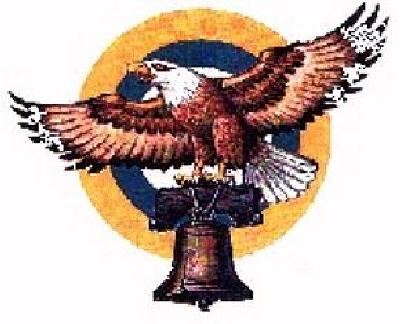 8th Bomb Squadron insignia 8th Bomb Squadron insignia
Approved June 21, 1954 (KE 8387)
1968 Map of Vietnam & Chronological History (1968-1973) 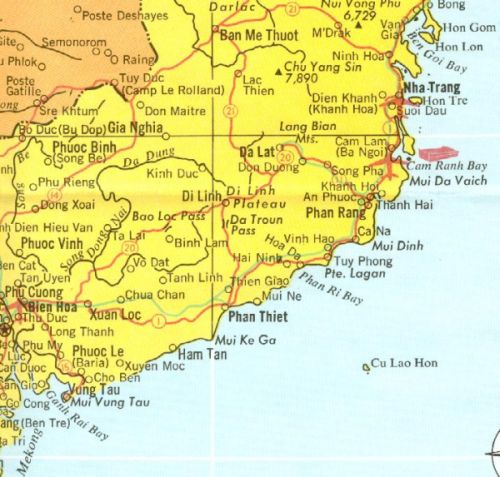
Bien Hoa and Phan Rang Location in Vietnam (1968 Map)The following is from Historical Text Archive: Don Mabry: Nixon widened the war, however. He defined victory as the preservation of a non-Communist government in Saigon. To achieve victory, he adopted measures long advocated by the military but rejected by Johnson. In March, 1970, Prince Sihanouk of Cambodia was overthrown, probably by the CIA and the right-wing General Lon Nol took his place. North Vietnamese troops poured into interior Cambodia. On April 30, 1970 Nixon ordered the invasion of Cambodia. Although the US had been secretly fighting there, this invasion was a widening of the war. The Cambodian invasion sparked serious protests. The anti-war movement had been quiet for most of 1969, giving the new president a honeymoon as he began implementing his "secret plan." In October, 1969, the Vietnam Moratorium Committee brought 500,000 to Washington, DC to protest the war and encourage Nixon to end it. The Nixon administration condemned the protest meeting. It indicated that anti-war sentiment had grown substantially. Nixon became even more anxious to win the war. When Cambodia was invaded in April and May, 1970 one and one-half million students protested on 1200 campuses. On May 4th, four students, on their way to class, were murdered by National Guard troops who had been called into action by the governor because of the anti-war demonstrations on the Kent State campus. On May 14th, two Jackson State students were murdered by Mississippi Highway Patrol officers who fired on a dormitory when students there protested the war and racism. Many Americans were outraged while many others believed that the students had asked for it. These incidents were further evidence of how the war was tearing the nation apart. Congress began raising questions about the constitutionality of the invasion and repealed the Gulf of Tonkin Resolution, one of the few legal props for the war.
The Cambodian invasion failed to cut off North Vietnamese and Viet Cong progress and Congress refused to fund Nixon's planned invasion of Laos. In February, 1971, Nixon used US air power to support a South Vietnamese invasion of Laos. This, too, failed.
As US troops were being withdrawn, Nixon stepped up the use of US air and naval power. From 1969 to the end of 1971, the US had dropped 3.3 million tons of bombs on South Vietnam, North Vietnam, Cambodia, and Laos, more than Johnson had dropped in five years and more than the US had dropped on Europe and the Pacific in World War II. Nixon was trying to bomb the enemy into submission but it did not work. In the Spring of 1972, North Vietnamese forces launched an offensive which pushed back South Vietnamese forces. Nixon widened the bombing of North Vietnam and mined its harbors but the war was lost. The Nixon administration had been engaging in secret negotiations between 1969 and 1971 as Henry Kissinger made thirteen trips to France to meet with North Vietnamese diplomats. The US proposed a cease fire in advance of any political settlement and the preservation of the Thieu regime. Nixon had asserted that Thieu was one of the four or five greatest political leaders of the world, and supported Thieu in the 1971 presidential election, one so fraudulent that all of his opponents withdrew. But in 1972, shortly before the US presidential election, Nixon announced progress towards a cease fire. The war ended in 1973. Nixon resigned in 1974 so he did not preside over the rout of the South Vietnamese in 1975 when the North Vietnamese armies took over the entire country.
The war was costly. One and one-half million died in Indochina of whom 58,000 were Americans. Millions more were maimed. Some 500,000 people became refugees. From 1965-1971, the US spent $120 billion dollars directly on the war but other costs raised this amount to $400 billion. Costly, too, was its effect on the US military which thought itself invincible and had difficulty accepting the fact that it was not. Of course, the War of 1812 was a draw, at best, but Americans only paid attention to recent events. It was a long war but not as long as the War on Drugs or the perpetual war that the War on Terrorism promises to be. It left open wounds on the US psyche. (See Base Development in South Vietnam 1965-1970: Chap 10: Base Camps for Base Camps information.)
- 1970
- Feb. 20: Nixon aide Henry Kissinger begins secret peace talks in Paris.
- April 29: U.S. forces enter Cambodia to clear North Vietnamese sanctuaries.
- April: U.S. Air Force bombs Cambodia.
- May 4: National Guardsmen kill four students at Kent State University in Ohio during anti-war protest.
- 1971
- Nov. 12: Nixon announces that U.S. ground forces are in defensive role; offensive actions handled by South Vietnamese.
- 1972
- April 15: U.S. Air Force resumes bombing of Hanoi and Haiphong after four-year lull.
- April 15-20: Hundreds protesting bombing arrested across the country.
- July 8: Actress and anti-war campaigner Jane Fonda visits Hanoi.
- Nov. 7: Nixon re-elected.
- Nov. 20-21: Kissinger and Le Duc Tho hold more private peace negotiations.
- Dec. 13: Paris talks deadlock.
- Dec. 18-29: "Christmas Bombing" of Hanoi and Haiphong by Air Force.
- 1973
- Jan. 15: Nixon halts U.S. offensive actions against North Vietnam.
- Jan. 27: Peace pact signed in Paris by United States, South Vietnamese, Viet Cong and North Vietnamese.
- March 29: Withdrawal of American troops and release of 590 U.S. war prisoners completed.
8th Special Operations Squadron Squadron
(1969-1972) |

3rd TFW A-37
(USAF Photo)
Convert to A-37B Dragonflys: Combat Dragon (1967) There was a great need for close air support (CAS) as well as counter-insurgency support aircraft as more troops were thrown into the battles of Vietnam. This in turn led the aging A-1E "Spad" to be exposed to more lethal fire resulting in increased losses. Early on in 1965, the USAF had tried the B-26K Invader but soon structural problems caused the wings on some aircraft to fall off. The B-57s were used as strike aircraft but of the 94 aircraft in the area, 51 were lost in combat (including 15 on the ground). Soon the aircraft losses became critical. By Jul 69 only 8 B-57s were left. The decreasing number of A-1Es impacted the support the ground troops. The F-4s and F-105s were only moderately effective as they could not operate effectively in close proximity bombing to ground troops.
The USAF began to revamp the COIN (counter-insurgency) program involving the YA-37A that the USAF had initially been shelved. In fact, the YA-37A that had been sent to the USAF Museum was removed from the museum and sent to Cessna for repair as the wing wiring had been cut for placement into static display status. New wing wiring was installed and the YA-37 easily passed its flight tests. The decision was made by Cessna to convert 39 existing airframes from the bone-yard at MASDC/Davis-Montham AFB, AZ. These airframes were the earliest T-37 trainers.
According to From Trainer to Gunfighter: The A-37
As soon as they had been airtested the converted 'Tweets' were flown to England AFB where both air and ground crews began their training. Eventually 24 had been delivered and they and their crews had been deemed fit to undertake the assigned test codenamed 'Operation Combat Dragon'. Role envisaged for the A-37A included Close Air Support, Armed Recconnaisance, Helicopter Escort and any other duties that would be assigned in theatre.
As well as the eight underwing pylons cleared for a variety of stores the Dragonfly sported a 7.62 mm minigun in the nose plus associated gunsite on the cockpit coaming. To complement their new role one half of the new fighter batch were painted in an experimental scheme of off-white and light blue whilst the remainder wore the by now standard Vietnam scheme of two shades of green and tan uppers with light grey lower surfaces. The blue and white aircraft were later repainted into the normal scheme as the camouflage proved to be too effective. (SITE NOTE: Pilot comments on the blue-white paint scheme were that it was not any more effective in preventing ground fire damage than the camouflage paint scheme, but did pose a problem as wing men and FACs had a difficult time spotting the aircraft from the air.)
By the end of July 1967 all the required aircraft for the 604th Air Commando Squadron Designate had been crated and were ready for trans-shipment to Vietnam in C-141 transports. The 604th ACS was moved to Bien Hoa Air Base, South Vietnam. It remained there for Combat Dragon between 17 July and 14 August 1967. (SITE NOTE: There seems to be differing quotes as to the exact start dates of various phases with dates differing by a few days to a month. This is not considered significant for this history's purposes.) According to AF Museum: Cessna A-37A: On 23 August 1966, the USAF directed the establishment of a program to evaluate the A-37 in a combat environment. The project was named "Combat Dragon" and was designed to test the effectiveness of the A-37 in Close Air Support, Counterinsurgency and escort missions in Vietnam. Besides testing the aircraft operationally, the project was also used to evaluate the maintenance, supply and manpower requirements. The Tactical Fighter Weapons Center directed the program and established a 350-man squadron with 25 A-37A's at England AFB, Louisiana in early 1967. The unit was designated as the 604th Air Commando Squadron (ACS). Initial instructor pilot training began on 29 March 1967, initial operations and combat orientation started on May 1st.
Phase I of "Combat Dragon" was done between 19 June and 16 July 1967 at England AFB. Phase I measured data collection and analysis procedures to be used during the actual combat evaluation, train the A-37A pilots, establish a bombing and gunnery baseline, and identify and fix problems with the aircraft.
On 26 July 1967, the 3rd Tactical Fighter Wing at Bien Hoa Airbase received its first Cessna A37A Dragonfly aircraft under project "Combat Dragon." The attack version was considerably heavier than the T37B trainer from which it was developed. Americans were to fly the A37, nicknamed "Tweet," while the aircraft was being readied for the Vietnamese Air Force. The Dragonfly was essential to plans to bring the VNAF up to strength with a tactical force that was almost all-jet.
Phase II of "Combat Dragon" began on August 15th and ended on September 6th. This phase of the project was used to familiarize the pilots was the operational areas of Vietnam and Laos. The data collection and evaluation system was also refined using forms and methods already in use in Southeast Asia.
Phase III of "Combat Dragon" began on September 7th and the first actual ground strike missions were flown. Phase III operations continued until 27 October.
Phase IV of "Combat Dragon" was done between October 28th and 30th and tested accelerated (maximum sortie generation) mission scheduling.
Phase V began on November 1st and tested the ability of the aircraft to operate from a forward operating location. Seven aircraft were deployed to Pleiku Air Base and flew combat mission through December 2nd. The remaining 18 aircraft remained at Bien Hoa AB and flew normal (Phase III) combat strike missions. The 604th Air Commando Squadron pilots initiated its Phase III combat operations test on Aug. 15, 1967, flying 12 combat sorties a day in support of ground troops and against enemy supplies being shipped into South Vietnam. The daily sortie reached 60 by the end of September.
In October, some of the planes were shipped to Pleiku for Phase V of the tests where pilots began flying armed and visual reconnaissance missions and night interdiction flights in Tiger Hound. Tiger Hound was an area roughly 90 miles long in Laos bordering on South Vietnam territory used by the North Vietnamese to infiltrate troops and supplies. It was also the code name of a special Air Force, Navy, Marine and Army task force that began interdicting southeastern Laos.
When the testing period drew to a close, the Dragonflies had logged more than 4,000 sorties without a single combat loss. One plane went down as a result of an unfortunate maneuver after the aircraft returned to its home base. The squadron was then attached to the 14th Air Commando Wing at Nha Trang. The unit however, continued to fly out of Bien Hoa.
(See Jim Fattaleh's A-37 Photos for photos 1967-1968, 604th ACS, Bien Hoa, RVN.)
Based upon the recommendations of the Combat Dragon tests, the A-37B was designed. The first A-37B arrived at Hurlburt Field in December 1969 for the 603rd Special Operations Squadron.
604th ACS attached to Bien Hoa (1967) The 604th Air Commando Squadron had used the A-37 aircraft with great effect in close air support missions dropping high explosives and napalm. The motto on the signs read, "Closest Air Support" -- "Smallest Fighter; Fastest Guns."
Though assigned to the 14th SOW at Phan Rang, the 604th was based at Bien Hoa and came under the operational control of the 3rd TFW. Operations began almost immediately. According to pilot reports, the aircraft was somewhat hard to control when fully laden -- and very difficult to control on pullout if only one wing's stores dropped. "Once trimmed to a lower weight was a delight to fly. Agile accurate it was the FAC's dream-the Army on the ground grew to love it and their enemies to fear it."
SITE NOTE: From AFHRA: 14th Flying Training Wing: "14th SOW: Performed combat operations in Southeast Asia, Mar 1966–Sep 1971, operating from numerous locations in South Vietnam and Thailand. Operations included close and direct air support, interdiction, combat airlift, aerial resupply, visual and photographic reconnaissance, unconventional warfare, counterinsurgency operations, psychological warfare (including leaflet dropping and aerial broadcasting), forward air control operations and FAC escort, search and rescue, escort for convoy and defoliation operations, flare drops, civic actions, and humanitarian actions. The wing also operated Nha Trang AB, South Vietnam, Mar 1966–Oct 1969, and provided maintenance support for a number of tenants. Trained South Vietnamese Air Force (VNAF) personnel in AC–119 operations and maintenance, Feb–Aug 1971, and transferred some of its AC–119s to the VNAF, Aug–Sep 1971 as part of a phase-down for inactivation." The A-37A had exceptional loiter times unmatched by its larger F-100 Huns and F-4 Phantom cousins. With external fuel tanks on the inboard pylons and a load of napalm and HE bombs the A-37A, the A-37A was able to hit a target and loiter in the area awaiting another target from the FAC. The larger jets had to burn off fuel to launch their strike; and after the strike, they required a refuel. On the other hand, the A-37A had none of these limitations and could launch a strike immediately -- loiter in the area because of its external fuel tanks -- and launch a couple more strikes before heading home. In addition, the A-37A could be combat-turned in 90 minutes because of its high maintenance reliability. Its larger cousins would be still sitting on the ground. It was also common for the A-37 pilots to fly as many as five missions in a day, while the F-100 and F-4 pilot had only one mission.
According to From Trainer to Gunfighter: The A-37:During the twelve month deployment of the 604th not one of the units aircraft was lost to enemy action in the air although some did limp home with interesting holes in the wings and the odd engine trashed. The 604th logged its 10,000 combat sortie in May 1968 and had throughout the TET Offensive flown an average of 60 sorties a day with an overall availability rate of 87% throughout. Other role undertaken by the Squadron included many that they were primed for such as armed helo escort, CAS, CAP for ground convoys, FAC, armed recce and night interdiction. It was during the latter that pilots decided not to use the nose mounted minigun as the blast and tracers had a nasty habit of leading the enemy gunners straight back to the cockpit when retaliating. We end this look at the exploits of the 604th with a quotes from a couple of pilots. 1st Lt Charlie Carter" If we miss our target by 20 metres it is a disappointment, but the '37' is such a stable bomber that we can deliver our ordinance quickly and accurately." From Major Don Ellis" The missions we like are those where we can support troops in contact with the enemy, then we can see the results of our flying and know that we are directly helping out the troops". According to AFHRA: 14th FTW, the 604th ACS at Bien Hoa was detached from 14th SOW and attached to the 3rd TFW at Bien Hoa from 15 Nov 1967-1 Mar 1970. This was part of the master plan to "Vietnamize" the Vietnam War. According to Dave Blum in the Dec 2003 A-37 Association Newsletter, "As Nixonian Vitemanation took hold, two A37 Sqdns (8th and 90th) were Vietnamized, leaving the 604th and this became the 8th SOS at Bien Hoa."

604th Raps Building
(Bob Macaluso on A-37 Association)
The following is an article about the combat experiences of Ollie Maier in Daily University Star on 29 Oct 97. It stated, Flying back to the Vietnam WarOllie Maier tells about his hundreds of combat air missions as a war pilot
By Travis M. Whitehead
Senior Reporter
If Ollie Maier could rewrite the Vietnam War, he would make it more like the Gulf War. "A lot of good people died--Americans, Vietnamese and even North Vietnamese," said Maier, who served in Vietnam as a combat pilot from 1967 to 1968. "I wish we'd gone in the way they did in the Gulf War: get it over with and get out. We had our hands tied." Maier, who is now the energy conservation coordinator for the SWT Physical Plant, spent his tour of duty flying support missions for ground troops in South Vietnam. Based with the 604 Air Commando Squadron in Bien Hoa, a few miles north of Saigon, he flew 502 missions.
Ollie Maier points to a picture of a plane he flew in Vietnam. Maier flew more than 500 air missions while stationed in Bien Hoa, just north of Saigon.
Maier said this earned him the distinction of flying more combat missions in a one-year period than any other pilot in Vietnam as recorded in "A-37 Rap," a book published with a collection of stories from the pilots in 604 Air Commando Squadron. Maier said the A-37 was a trainer aircraft modified into a fighting aircraft. Because of this, it was considered a test unit, and he had the freedom to fly sometimes as many as five missions a day. Fighter pilots in other units were restricted to flying only one combat mission each day.
The aircraft soon proved its worth.
"We had an outstanding reputation for hitting targets," he said. "We were often called on because we knew how to get the job done."
Maier said the A-37 was not as fast as some aircraft and couldn't fly into North Vietnam. However, when support was needed for troops in the south, the A-37 was more accurate. Its advantage was that, because it could fly slower than other aircraft, it could fly lower to drop its load. The pilot could tell if the target had been hit and, if necessary, make multiple runs. Other, faster aircraft had to have higher altitude to pull up.
Maier said the only time he could see the people he was shooting at was when he was strafing. The hardest part, he said, was thinking about killing people.
"We all want to live," he said. "Regardless of what God we have, to take another's life is not that easy. But they were trying to kill me, and I was killing them in self-defense. You just more or less put it out of your mind."
Maier said he often didn't think he would survive.
"There were times I was scared I was going to die," he said. "I'd see friends get killed. I never actually saw them die, but they'd go on a mission and not come back, and I knew they were dead."
Maier said that out of 25 aircraft, the unit lost only five aircraft and seven pilots. Maier said he often returned with holes in his aircraft. Most of the time it didn't cause any trouble though.
The A-37, he said, was mechanically controlled, unlike newer aircraft which are powered by electronics and hydraulics. If you lose the hydraulics in the newer aircraft, he said, you lose complete control. The A-37 was much more accomodating to damage. "We had two engines," he said. "If one was shot out, you still had the one."
There were a few times when Maier said he ran into trouble.
"My bomb and fuel tank system was shot out," he said. "I tried to drop my bombs and I couldn't, so they told me to go over the ocean and push a button. That would clean the wings out. It only cleaned the left one out."
As a result of this, he had difficulty landing and a wheel blew out, forcing him off the runway.
"The procedure afterward, if that happened again, was to bail out," he said. "It was just too dangerous."
Maier said the only people who didn't like the A-37 were the enemy and the politicians. The A-37 was made by Cessna airplane manufactuers. Maier said Cessna didn't have as much clout as other airplane manufacturers, which later made the A-10 to replace the A-37.
"When you have politicians fighting a war instead of the military, it's going to be different," he said. "It's easy for politicians when they're physically detached. If they had their desks in the trenches with the men, it might be different."
Maier pointed out it was easy to second guess a situation without knowing all the information. "Maybe their thinking was, if it got overpowering, the Chinese Communists would've come in," he said.
"If it was up to me, I would've went in and showed my power."
The following is a "war story" written by Ollie Maier from the Sept 1991 Newsletter of the A-37 Association:Lloyd Langston was leading thsi one and I was on the wing. We had already been in Nam for several months and were pretty familiar with the areas, targets, etc.
We were working some target down in IV Corps when the FAC advised us another FAC had a higher priority target not too far away. Although we didn't have much of a bomb load left, we switched radio channels and flew to the rendezvous for the new FAC. There he briefed us onthe target.
"This is a target I've had my eye on for several months, " he said. "It is a building in the middle of a small city that Charlie has been using as a munitions plant. Not only is there munitions there, but one of the Charlie's fuel storage areas is also along side of it."
"I have finally just received permission from the district chief to hit it...and I want to do so before he changes his mind," he continued.
"Since it's the biggest building right in the center ofthe city, I'm not even going to mark it. I don't wnat to alert the enemy working in it." (And it was a big building. From the air it look like a one or two story building with a tin roof that covered almost a city block. It had a river by it and canals all around.)
"You don't have to worry about how close the friendlies are as the whole area is considered unfriendly," he added.
As mentioned before, we didn't have much of a bomb load left. I think Lloyd had a couple of small 250 pounders and I had a couple of cans of nape...plus our mini-guns.
Lloyd rolled in, put his pipper on the target, and let one of the 250s go. When it hit the target, it was the biggest explosion I had ever seen. The FAC, who was flying off to a side, said the fireball went to over 500 feet...and later the smoke went to above 4,000 feet.
This smoke was from all the burning barrels of fuel. What the initial explosion didn't set off, I probably was instrumental it helping set off with the cans of nape. I really can't say for sure as it seemed the whole area was burning as I made my bombing runs.
The burning fuel was not only in the immediate area but it had flowed into the surrounding canals or stacked alongside of them) setting them afire.
Even though the intial explosion truly showed what one little airplane and one little bomb accurately delivered can do, this point wasn't really driven home until later back at the base.
On the way back to base, probably about half way, we met a flight of eight F-4s operated in flights of two or four. They were headed in the direction we had just come from.
When we landed we were informed that as soon as Saigon learned that the munitions plant was on the target list, they set up a special flight just for it.
That was the flight of F-4s we saw. Since we had totally destroyed the target, they had to be diverted to some mundane target. I understand they and their ops people were really quite pissed that a couple of half loaded A-37s had stolen their glory. The 604th ACS had its share of combat casualties with the A-37, but much less than expected for a close air support unit engaged in some of the most dangerous flying situations. The 604th ACS had seven pilot losses. Two are as follows:- Major Ronald D. Bond: According to Task Force Omega, "On 11 March 1968, Major Ronald D. Bond was the pilot of an A37A Dragonfly that departed Bien Hoa Airbase on a close air support mission for ground troops engaged in a battle with Viet Cong (VC) forces some 47 miles to the southeast. After making a strafing run over the target located on a hillside surrounded by rice paddies, the aircraft was struck by hostile ground fire, crashed and exploded upon impact approximately 2 miles east of a primary road and 4 miles west of the coastline. The location of loss was approximately 10 miles northeast of the major coastal base of Vung Tau, 44 miles southeast of Saigon and just north of the town of Long Hai, Long Dat District, Phuoc Tuy Province, South Vietnam. ... Ronald Bond most certainly perished in the crash of his Dragonfly."
- 2Lt David Whitehill: Another incident according to the Virtual Wall happened on 24 May 1968. David Whitehill was flying an A-37 as escort to a C-123K "Ranch Hand" spray aircraft near Rang Rang, about 30 miles northeast of Bien Hoa. When the C-123 came under fire, Whitehill attacked the gun position. On his third pass he apparently was hit by ground fire - he failed to pull out and crashed near the gun site.
According to the AFHRA: 3rd Wing, it was assigned to the 3rd TFW from 1 March–30 Sep 1970. The unit was deactivated when the 8th SOS began operations at Bien Hoa.

Bien Hoa Attack (1965)
(USAF Photo)TET Offensive (Jan 1968) From the Gold Bar Magazine (www.ocsfoundation.com/magazine) article A Look Back in Time
Air Force's Ground Support in Vietnam by Sam McGowan on 14 May 2002: Bien Hoa was hit at 0300 on January 31 by 35 rounds of 122mm rocket fire and 10 rounds of 82mm mortar fire. Almost immediately, an Air Force sentry-dog handler reported that the base was being penetrated. An enemy force of eight companies breached the perimeter at four points from the east; a fifth penetration was halted by fire from Army gunships. A concrete pillbox directly in the path of the advancing force became the center of resistance as the Air Force security policemen inside maintained a heavy fire against the attackers, catching them in a crossfire. By 0400 the attack had been halted east of the flight line by security policemen and security augmentees supported by Army helicopter gunships.
By dawn the enemy was resisting at only three points: an aircraft engine test stand in a revetment near the runway, the aircraft de-arming pad, and near one of the penetration points on the eastern perimeter. A counterattack, followed by a final sweep of the field supported by Army gunships, terminated all enemy resistance by 1640. Air Force casualties were four killed and 26 wounded; two airplanes were destroyed by shelling and two were damaged. Enemy losses were 139 killed and 25 taken prisoner inside the base. Another 1,164 were killed and 98 captured in the immediate Bien Hoa area. According to History Net: Lt. Colonel Charles A. Beckwith: An Unforgettable Character by Bill Bell:Sometime around 3 a.m. on January 31, with the local guard force incapacitated, VC sappers--wearing only undershorts and with wire-cutters suspended around their necks on nylon laces--began to infiltrate the wire aprons of the minefield at the end of the runway, with the intention of blowing up the base's tactical aircraft. As the sappers probed for mines, a 101st Airborne soldier who was manning an M-60 machine gun saw something moving out there and began to fire. ...
The main thrust of the attack was blunted thanks to early discovery, and the enemy did not breach the perimeter, thanks to the engineers of the 326th. Because the sappers had been stopped, we were able to get the fighters based at Bien Hoa back in the air quickly once the brunt of the fighting was over. But VC and NVA troops continued to pour deadly automatic-weapons fire into the base from outside the perimeter throughout the first day of Tet. During the ensuing sweep around the perimeter, the firing was so pervasive that the commanding general's secretary was killed while typing at his desk. The vulnerable buildings outside the perimeter were hit hard by the VC and NVA, many of them completely destroyed.
When the attack petered out, the bodies of killed and wounded VC and NVA were scattered in the brush and tall grass around the perimeter. We determined that some of the VC had apparently been special action unit personnel, since inside their packs we found starched and pressed VNAF uniforms. Had they managed to get inside the air base and assume their disguises, they could have created considerable confusion between the American and South Vietnamese personnel, even after first light.
As it was, more then 500 VC were killed and 40 more captured in the Bien HoaLong Binh area. When the smoke cleared at the air base perimeter, 115 VC and NVA bodies were piled in the wire. The following day, the bodies were covered with lime and buried using a bulldozer in one common grave at the end of the runway. 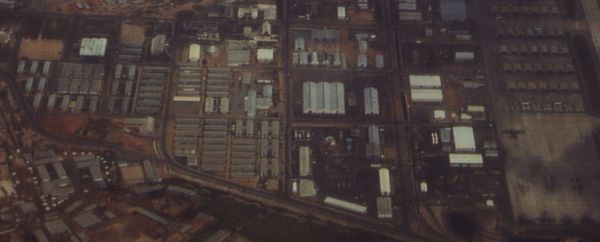
Aerial view of Bien Hoa
(John Lamb on A-37 Association site)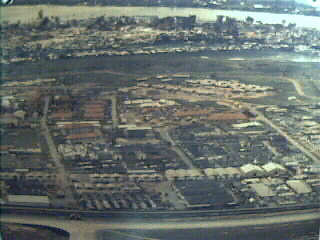
Aerial view of Bien Hoa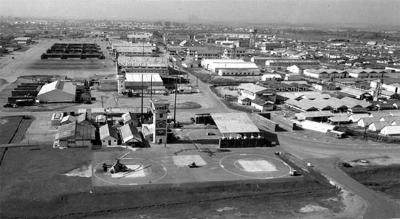
Bien Hoa from Runway 27L (looking south)
(Det 6 600th Photographic Squadron:
Wavelen Wayne Fielder)
Bien Hoa Tower with Pedro HH-43B in front
(Det 6 600th Photographic Squadron:
Wavelen Wayne Fielder)
Outside Bien Hoa Main Gate
(Det 6 600th Photographic Squadron:
Wavelen Wayne Fielder)
90th Attack Squadron, 3rd TFW, Bien Hoa (1969-1970)
The 90th was with the 3rd TFW at Eglin when it transitioned to F-100s. The 90th was redesignated on 8 Jun 1964 as the 90th Tactical Fighter Squadron. When the 3rd was rotated to Vietnam, the 90th accompanied it. On 8 October 1966, the wing transferred to Phan Rang Air Base, Republic of Vietnam, replacing the 366th Wing. With the transfer, the 35th became the parent wing at Phan Rang Air Base and began operating F-100 aircraft with Detachment 1 of the 612th Tactical Fighter Squadron from Misawa, Japan. The 90th TFS (Dicemen) was first assigned the 3rd TFW at Bien Hoa AB on 3 Feb 1966 flying the F-100. In 1969, the 90th TFS started its transition to the A-37B while still assigned to the 3rd TFW. It was attached to the 3rd TFW from 3 Feb 1966–31 Oct 1970.
The 8th and 13th Tactical Bomb Squadrons flying their B-57s followed the 35th to Phan Rang Air Base, while the wing gained an attached organization: the Royal Australian Air Force Squadron No. 2, equipped with MK-20 Canberra bombers. In July 1969, the B-57s were phased out of the USAF inventory and the remaining B-57s sent to the boneyard. The 8th was transferred without equipment and personnel to the 3rd TFW in preparation for its transition to the A-37B. The 13th TBS was inactivated. In the meantime, the 90th was standing down as well in preparation
SITE NOTE: By 1965, the F-100s were experiencing severe shortages in Vietnam and all assets were drained from the ANG. The F-105 could carry a larger bombload further and faster. In addition, the F-105 was built to take the extreme structural loads of low-level, high-speed flight, whereas the F-100 was not. Consequently, from mid-1965 onward, F-100D fighter bombers generally operated only in the South, leaving the North for the F-4 and the F-105. In this role, the F-100 was only moderately effective as a ground attack aircraft because it lacked the maneuverability to operate in very close proximity to friendly troops under enemy attack. Then in 1967 a catastrophic wing failure was caused by a series of wing cracks that had been produced by metal fatigue. All F-100s were temporarily restricted to a 4-G maneuver limit until all the planes could be fixed by carrying out a complete modification of the wing structural box. These modifications were not completed until 1969. This limited the usage of the F-100s in its role as a strike aircraft. All of this added to the pressure to field more A-37B strike aircraft as soon as possible...and to convert units to this aircraft. After the success of the Combat Dragon program and the incorporation of its suggestions in the A-37B. The prototype of the B-model was first flown in September 1967 and deliveries began in May 1968. Once deliveries were made, the USAF started the pilot training for the cadre of two squadrons of A-37B aircraft -- the 90th and 8th. After completion of training, the A-37Bs were broken down and shipped to Bien Hoa via C-133s. The pilots departed England for the Philippines for Survival Training and when they arrived at Bien Hoa after completion of the training, the aircraft was awaiting them all assembled.
The 90th did the first combat acceptance of the A-37B in Vietnam when they started to arrive around Sept 1969. The unit was combat certified on December 1969. Immediately, the unit was redesignated as the 90th Attack Squadron on 12 Dec 1969.
The 90th had been continuously associated with the 3rd Wing since 1919. But this long association came to an end when the 3rd TFW became a "paper wing." The assets of the 90th Attack Squadron, along with the 8th Attack Squadron, were turned over to the RVN Air Force as part of Nixon's "Vietnamization Program."
The close out of operations for the 90th at Bien Hoa also marked the end of the 3rd TFW in Vietnam. During May and June 1970, the 3rd TFW participated in the Sanctuary Counteroffensive in Cambodia aimed at depriving the enemy the use of its sanctuary bases and destroying its leadership. The campaign marked the 3rd TFW's last major operation. On 31 October 1970, the 3rd Tactical Fighter Wing ended its duties in Vietnam. Unmanned and unequipped, the wing remained active in a "paper" status until it moved in name only to take over Kunsan AB, Korea.
According to AFHRA: 90th FS, on 31 Oct 1970, the 90th Attack Squadron was redesignated the 90th Special Operations Squadron and moved to the 14th Special Operations Wing at Nha Trang where it switched to C-123K Ranch Hand and AC-130 aircraft.
8th Attack Squadron, 3rd TFW, Bien Hoa (1969): By July of 1969, the 8th Tactical Bomb Squadron's strength was down to only 9 aircraft. By the end of July, the squadron was down to 8 and it was decided that it was time to retire the B-57B from active service. The surviving aircraft were sent back to the USA in September and October and put into storage at Davis-Monthan AFB, AZ.
At the same time the decision was made to convert the 8th TBS into a A-37B unit. The elimination of the B-57 also presented a problem with the need for a replacement for the aging A-1E Skyraiders and the decommissioned B-57Bs as strike aircraft. The answer appeared to be the A-37B to fill the niche for a "counter-insurgency" (COIN) aircraft.
The A-37B aircraft, like the A-model, had a 7.62 Gattling Minigun in the nose, gun cameras, and armor protection for the pilots. It also had self-sealing fuel tanks, a tracking beacon system, and the ability to directionally track VHF and UHF signals. The prototype of the B-model was first flown in September 1967 and deliveries from the factory began in May 1968.
SITE NOTE: Plans for both the 8th and 90th squadrons to be attached to the 3rd TFW seems to have been driven by a historical imperative. The 8th and 90th had a long history as sister squadrons in the 3rd Bomb Group dating back to WWII and Korea. Later this same historical imperative, preserved the 8th SOS from deactivation as it was one of the oldest continuously active squadrons in the USAF.
In addition, there was a lot of pressure on fielding the A-37B as a counter-insurgency (COIN) aircraft to replace the aging A1-Es and mechanical problems of the F-100s. The A-37B was one of the few aircraft to be able to carry its own weight in munitions. This meant a combat configuration of 4 Mk82 500 lb bombs, 2 pods of rockets, and a load of gun ammo. This was equivalent to the load carried by the F-100 Super Saber (not counting the 20MM gun). In close range missions, the A-37 could actually get bombs on target faster than the F-100 since the "Hun" had to burn off some fuel before it could go to work. It could also hit the target, climb up to pattern altitude and return to make another pass quicker than any other fighter. It could quick-turn in 90 minutes and its survivability surprised even the most hardened skeptics. It would have been logical to assume that because of the performance of the A-37B in its strike role that more units would have been fielded other than the 8th, 90th and 604th.
At the same time, one must realize that the Nixon "Vietnamization Program" was being stressed as the U.S. wanted to desparately extract itself from the quagmire of the conflict. Thus rather than field more USAF squadrons, the military pursued turning the A-37Bs over to the RVNAF. Of the 577 A-37s built, only a handful saw combat with the USAF.
The 4532nd Combat Crew Training Squadron at England Air Force Base in Louisiana initially trained over 100 South Vietnamese Air Force pilots. Each VNAF student received 112 hours of ground instruction and 85 hours of flight training. After training was completed, the VNAF pilots returned to Vietnam to fly A-37's supplied under the US Military Assistance Program (MAP). South Vietnam had 10 squadrons of A-37's at peak strength during the early 1970's. In Jul 1969, the 8th Tactical Bombardment Squadron officially phased out its B-57s in the 35th TFW. The last B-57B was sent stateside in Oct 69. The 8th TBS designation moved to Bien Hoa AB, South Vietnam on 15 Nov 1969 without personnel or equipment and was attached to the 3rd TFW.
NOTE: There seems to be some confusion on the ACTUAL movement dates to Bien Hoa. According to Air war College: 25th ID After Action Report, during the 4-day battle of at Renegade Woods on 2 April, 1970, the 8th Attack Squadron of 35th TFW Phan Rang supported the effort with 2 A-37s carrying "4 500 lbd HE; 4 500 lbd napalm." At this time we believe this is a historical error. This would indicate that the 8th Attack Squadron was STILL at Phan Rang in April 1970. It is possible that the report had mistakenly identified the 8th Attack Squadron, 3rd TFW, Bien Hoa (A-37s) for the 8th Tactical Bomb Squadron, 35th TFW, Phan Rang (B-57s) which departed Vietnam in Oct 69. With the delivery of the new A-37Bs to the USAF, the cadre of pilots started training at England AFB in Louisiana on the A-37s for both the 8th Attack Squadron and 90th Attack Squadron. In 1969, the initial cadre of pilots for the 8th Attack Squadron's A-37Bs were trained at the 4532nd Combat Crew Training Squadron (CCTS) at England AFB -- along with the pilots for the 90th Attack Squadron. The 4532CCTS/4410th SOTG trained A-37 pilots for both the USAF and RVNAF. After the training was complete on the A-37B, the A-37B aircraft were broken down and shipped to Vietnam on C-133s, while the pilots were sent to Survival Training at Clark AB, Philippines.
According to Don McPhail of the 8th Attack Squadron in an email to A-37 Association site: Ollie Maier, "In 1969 two new A-37 squadrons were formed at England AFB. The squadrons trained in A37B's and when finished with the training the planes were taken apart and shipped to Vietnam on C-133's. The pilots left the base at the same time on C-141's enroute to Hickam and Clark AFB in the Philippines for jungle survival. By the time we got to Vietnam our airplanes were put together and ready for us."
"The two squadrons were the "8th Attack Liberty Sq" -- the "Dogs" and the "90th Attack Sq" -- the "Dice." The "604th -- Raps" were already there and kept their "A" models. The "8th" & "90th" squadrons only lasted in Vietnam for 10 months and the decision was made the give our airplanes to the RVN. Higher-ups wanted to keep the "8th" alive as the squadron had a very long history before we inherited the name in Vietnam but the "Raps" were the ones who were going to survive so the surviving squadron was the "8th" with the "Rap" call sign. The A-37B aircraft arrived first around Sep 69 and the pilots arrived around Oct 69 after completing survival training in the Philippines. The 8th Tactical Bomb Squadron was assigned to the 3rd Tactical Fighter Wing on 15 Nov 1969. It was redesignated the 8th Attack Squadron on 15 Nov 69 and started flying the A-37B three days later on 18 Nov 89.
The 90th Tactical Fighter Squadron was redesignated the 90th Attack Squadron on 12 Dec 69 but had already started flying A-37s in November along with the 8th. Both units were combat certified on 12 Dec 69. The 8th was combat certified on December 1969.
At this point, there were three squadrons of A-37s at Bien Hoa: the 604th "Rap", 90th "Dice" and 8th "Dog". The tail codes and radio call signs were 8th/3rd TFW "CF" (Dog) and 90th/3rd TFW: "CG" (Dice). Unfortunately, the "Dog" radio call sign for the 8th never seemed to catch on. The 604th ACS used "CK" (Rap). The 604th ACS/14th SOW was attached to the 3rd TFW at Bien Hoa. (NOTE: The 14th SOW was at Phan Rang.)
| 8th Attack Squadron | 3rd TFW | (Dog) | A-37B | Bien Hoa | Tail Code: CF | | 90th Attack Squadron | 3rd TFW | (Dice) | A-37B | Bien Hoa | Tail Code: CG | | 604th Air Commando Squadron | 14th SOW | (Rap) | A-37A/B | Bien Hoa | Tail Code: CK |
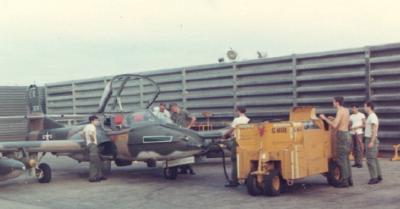
A-37B Arrival at Bien Hoa (1969)
(Bob Mead on A-37 Association)

A-37B Arrival at Bien Hoa (1969)
(Bob Mead on A-37 Association)8th and 90th Attack Squadrons Start Shutting Down (Mar 1970) The decision was made in 1970 to turn the A-37s of the 8th and 90th over to the Vietnamese Air Force under Nixon's "Vietnamization Program." Preparations were made for the transfer of aircraft to the RVNAF -- and USAF personnel to the 604th or reassignment.
At the same time, the decision was made to close out the 604th ACS while retaining the 8th Attack Squadron designation because of the significance of its being one of the squadrons with the longest record of continuous service dating back to WWI. This is the reason the 8th SOS retained the "Raps" call sign of the 604th ACS...instead of the "Dog" call sign that never caught on. The 604th ACS absorbed the personnel from the 8th and 90th Attack Squadrons which were closing out -- and then it was redesignated as the 8th Special Operations Squadron.
SITE NOTE: There seems to be some confusion as to which unit provided the cadre for the 8th SOS. The 8th Special Operations Squadron history (dated 6 Oct 93) states the 310th Attack Squadron at Bien Hoa was absorbed and redesignated as the 8th Attack Squadron. This is in error because of eye-witness statements from personnel stating the cadre came from 90th and 604th personnel -- and equipment from the 604th. According to AFHRA: 3rd Wing shows the 310th & 311th Attack Squadron was attached to the 3rd TFW only between15–30 Nov 1969. At this time, we are not certain where the 310th and 311th came from.
(AFHRA: 310th Fighter Squadron shows that the unit never bore the designation "Attack Squadron" and was reactivated as the 310th TFTS in Dec 1969. AFHRA: 310th Airlift Squadron shows the 310th Special Operations Squadron on 1 Aug 1968-1 Jan 1970 at Phan Rang, but this was a transport unit that never flew the A-37B.) 
Wavelen Fielder and Michael Palmer
installing Gun Camera Film on 8th SOS A-37 (1970)
(Det 6 600th Photographic Squadron:
Wavelen Wayne Fielder)8th SOS, 35th TFW (Sep 1970) In Mar 1970, the 604th ACS was transferred from the 14th SOW at Phan Rang to the 35th TFW at Bien Hoa -- even though it had been attached to the 3rd TFW at Bien Hoa since its inception. At the same time in March 1970, the 90th Attack Squadron "Dice" and the 8th Attack Squadron "Dog" of the 3rd TFW started to close out operations with the A-37 aircraft and turned over their assets to the Vietnamese Air Force. The 90th SOS was assigned to the 14th SOW at Phan Rang on 31 Oct 70 where it converted to C123K Ranch Hands and AC-130 aircraft.
The 8th Attack Squadron transferred its personnel to the 604th ACS. As part of the transfer process, the 604th ACS transferred to the 3rd TFW on 1 Mar 70 and simultaneously changed its designation to the 604th Special Operations Squadron.
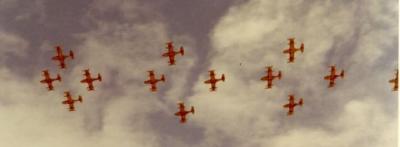
A-37B Flyby at Bien Hoa (1970)
(Bob Mead on A-37 Association site)According to A-37 Association site, "Bob (Mead) caught this unique image during a flyover at Bien Hoa in September or October of 1970. This could be the closing out of the 90th Squadron "Dice" or the 604th "Raps." The Raps and the Dice converged to become the 8th Attack Squadron and we didn't know if we were supposed to be "Daps" or "Rice" from that point on." Bob Mead was at Bien Hoa from 1969-1970.
Later Don McPhail wrote to A-37 Association site, "My comments referred to a picture already on the web site. The picture is the first picture with the title "A-37's in diamond formation" by Bob Mead. That's all under the caption of Bien Hoa Diary #4 by Bob Mead. The caption under the picture has the facts a little confused and I was trying to straighten things out a bit. ... Once again, the picture of 16 A-37's in four diamonds in trail was taken over Bien Hoa and consisted of Dogs and Dice on their last flight. The flight was led by Col. Tomlinson who was the Dog squadron commander and I was his slot man. ..."
In other words, Don McPhail was commenting on the 8th and 90th flying together for the last time -- not the 90th and 604th. The 90th was to be transferred to the 14th SOW and transitioned into the C-123K. The 90th assets were turned over to the Vietnamese and the 604th was disbanded. The assets and personnel became the 8th SOS cadre. |
The 604th SOS closed the doors on its operations at Bien Hoa on 30 Sep 1970. Simultaneously on 30 Sept 70, the 8th Attack Squadron was redesignated as the 8th Special Operations Squadron and transferred to the 35th TFW -- as the 3rd TFW was being inactivated. The 8th assumed the tail code "EK" on 30 Sep 70.
In effect, the 604th ACS became the 8th SOS. The official 8th SOS call sign "Dog" never caught on and the pilots continued to use the "Rap" call sign. The "Rap" was already a recognized call sign for A-37 strike aircraft -- and, as many of the men came from the 604th, there would be a natural reluctance to change their old call sign. The 8th SOS assumed not only the men and equipment from the 604th SOS, but it also assumed its nickname, the "RAPS."
Ollie Maier of the 604th ACS wrote, "As I understand it, the call sign RAPS (Dragons was already used by a Vietnamese unit) came from our first commander, Col Weber. He had a close friend whose initials were R.A.P. and he wanted to acknowledge the help he
had given... thus RAPs."
However, the new squadron did take on a new tail code of "EK" for the 8th SOS. SITE NOTE: There are confusing references to the tail code "EK." According to From Trainer to Gunfighter: The A-37, the A-37B aircraft were assigned to the "8th SOS/3rd TFW[CK], the 14th SOW [EK] and the 315th SOW at Phan Rang." (SEE CONFUSION: Tail code: "EK" for the 8th SOS/14th SOW for details.) The "EK" tail code at Bien Hoa was used by A-37s at Bien Hoa. There is a photo at VSPA: Photos showing an A-37 taxiing with the EK tail code.
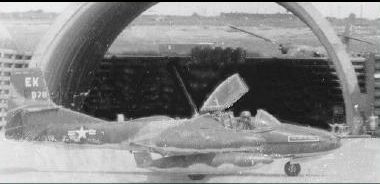
A-37B EK Tail Designator at Bien Hoa (1970) (Raymond Morgan)| The photo was taken by Security Policeman Raymond Morgan (1969-1970) who was yelling and waving to attract the pilot's attention of an impending crash of a C-7 Caribou skidding towards the arch seen in the background. The C-7 made an wheels-up landing on a foamed runway because a shot up olio strut which wouldn't allow the left gear to come down. The C-7 stopped short of the arch. Morgan wrote on the USAF C-7 Caribou site: "The following story and photos were provided by Raymond Morgan who was based at Bien Hoa Airbase in 1969/1970. I was on duty with the 3rd Security Police at Bien Hoa Air Base at the time of the C-7 crash. I had drove over to the HOT Cargo area to see my brother Ssgt. Wayne Morgan when an in-flight emergency came over the radio. We were in a good spot to watch the C-7 coming in on final approach. The foaming truck had just finished when the C-7 touched down on the runway with wheels up. The pilot made a good landing but after the C-7 got about half way down the runway the left wing tip made contact with the ground and caused the C-7 to side to the left. The C-7 never made contact with the hanger but from were we were standing it sure looked like it was going to. An A-37 aircraft taxing by some hangers oblivious to the emergency. If you look through the hanger just above the pilot's head you can see a crashing C-7 Caribou about to slam into the hanger! The pilot was looking at us and we were yelling and waving frantically at him. He never knew what the hell we were shouting about. No body was hurt. Just another day at Bien Hoa." |
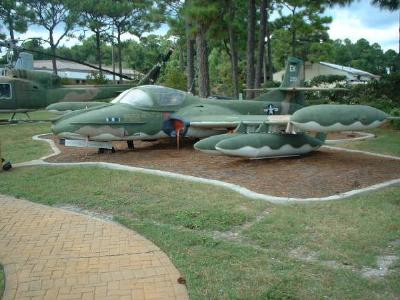
Static Display A-37B with EK Tail DesignatorCONFUSION: Tail code: "EK" for the 8th SOS/14th SOW??? There is a lot of confusion due to many web references that state the 8th SOS belonged to the 14th SOW. The references at Air Commandos and Gunships: Vietnam Era Tail Codes indicate that there was an 8th SOS/14th SOW with the "EK" tail code at Bien Hoa. Even popular models show the "8th SOS/14th SOW." For example, Academy Hobby Models has a model of an A-37B SuperTweet (#96359/EK, 8th SOS, 14th SOW, USAF, Bien Hoa AB, Vietnam, 1970).
Though it would be logical to state that a Special Operations Squadron would be assigned to a Special Operations Wing, the A-37Bs did not operate that way. The Vietnamization program was in full swing in 1970 when the "EK" code came into being. Only a handful of the 557 A-37Bs built were actually flown by the USAF in combat. The 90th SOS A-37Bs were turned over to the Vietnamese in 1970. The Vietnamese had 10 squadrons of A-37s. (NOTE: There are indications that A-37s flew missions from other bases for short periods of time to support local operations, but they were never attached to these wings.)
However, the primary reason we discount these references to an "8th SOS/14th SOW" is because AFHRA: 8th SOS and AFHRA: 14th Flying Training Wing show that the 8th was NEVER attached to the 14th SOW. (SITE NOTE: The 90th SOS converted out of the A-37B and joined the 14th SOW (1970-1971) flying C-123K and C-130 aircraft.)
The following is an example of the confusing "8th SOS/14th SOW" reference. According to Aircommandos: Air Commando and Special Operations aircraft used at major bases during the Vietnam War:
| Base | Unit | Aircraft | Call Sign Tail Code | | Bien Hoa | 8 AS/3 TFW | A-37B | CF | | Bien Hoa | 90 AS/14 SOW | A-37B | CG | | Bien Hoa | 604 SOS/3 TFW | A-37A/B | CK | | Bien Hoa | 8 SOS/14 SOW | A-37B | EK | | Bien Hoa | FS©/3 TFW | F-5A | None-transferred its 18 aircraft
to 522nd FS,
VNAF, 17 Apr 1967 | | Bien Hoa | 12 ACS/315 ACW | UC-123B/K | Ranch Hand | |
Again we repeat, records indicate that the 8th was NEVER assigned or attached to the 14th SOW.
Another reference that has caused confusion are the call signs for the A-37s listed in the 619th TCS Training Manual (Orientation Manual about 1969-70) at 505th Tactical Control Group. In it there is a reference to "2. Hawk A-37 Bien Hoa" in addition to the 8th, 90th and 604th. There was fourth A-37 unit at Bien Hoa. In addition, the "Hawk" was a call sign assigned to the F-100s at Bien Hoa. As the Orientation Manual was written in 1969-70, we believe this "Hawk" reference was in preparation for the 8th AS, 3rd TFW converting to the 8th SOS, 35th TFW.
To add to the confusion, according to From Trainer to Gunfighter: The A-37 stated "In Vietnam the A-37B equipped the 8th SOS/3rd TFW [CK],the 14th SOW [EK] and the 315th SOW at Phan Rang." Though the book is a highly authoritative source, we opt to disregard portions of this passage. In addition, the following errors appear on many hobbyist websites of vets documenting their personal experiences at Bien Hoa, Vietnam.
The first reference to the 8th SOS/3rd TFW (CK) is correct, but the 14th SOW (EK) reference we believe is in error. We believe that the "EK" tail code NEVER was associated with the 14th SOW. At Bien Hoa only the 604th ACS was attached to the 14th SOW, but they had the "CK" tail code.
Then we have the constant mention of the 8th SOS belonging to the 315th SOW. According to the AFHRA: 315th Airlift Wing, the 315th SOW was at Phan Rang from 68-70, but it did NOT fly the A-37. It flew the C-123K and AC-130. However, the 315th TAW at Phan Rang from 71-72 did fly the A-37 between 71-72. This is the 8th SOS. According to AFHRA: 8th SOS the 8th SOS was attached to the 315th Tactical Airlift Wing from 31 Jul 1971-15 Jan 1972. These muddled references cause us great confusion.
(NOTE: AFHRA: 315th Airlift Wing states that the 315th Air Commando Wing (1 Aug 67-1 Aug 68), then became the 315th Special Operations Wing (1 Aug 68-1 Jan 70), then the 315th Tactical Airlift Wing (1 Jan 70 - Inactivated 31 Mar 72). This shows the 8th SOS was assigned to the 315th TAW...NOT the 315th SOW.)

8th SOS Patch (1971)
(Richard Dutcher on A-37 Association site)8th SOS Starts to Pack Up to Go Home (1971) According to Historical Text Archives: Don Marby, "As US troops were being withdrawn, Nixon stepped up the use of US air and naval power. From 1969 to the end of 1971, the US had dropped 3.3 million tons of bombs on South Vietnam, North Vietnam, Cambodia, and Laos, more than Johnson had dropped in five years and more than the US had dropped on Europe and the Pacific in World War II. Nixon was trying to bomb the enemy into submission but it did not work. In the Spring of 1972, North Vietnamese forces launched an offensive which pushed back South Vietnamese forces. Nixon widened the bombing of North Vietnam and mined its harbors but the war was lost. The Nixon administration had been engaging in secret negotiations between 1969 and 1971 as Henry Kissinger made thirteen trips to France to meet with North Vietnamese diplomats. The US proposed a cease fire in advance of any political settlement and the preservation of the Thieu regime. Nixon had asserted that Thieu was one of the four or five greatest political leaders of the world, and supported Thieu in the 1971 presidential election, one so fraudulent that all of his opponents withdrew. But in 1972, shortly before the US presidential election, Nixon announced progress towards a cease fire. The war ended in 1973. Nixon resigned in 1974 so he did not preside over the rout of the South Vietnamese in 1975 when the North Vietnamese armies took over the entire country."
The Nixon "Vietnamization Program" was officially announced on Nov. 12, 1971 when Nixon stated that U.S. ground forces were in defensive role. Offensive actions would be handled by South Vietnamese. This policy came about because Nixon could not muster any support for the Vietnam War -- even amongst his closest advisors. The U.S. wanted out of the quagmire of Vietnam.
The turning over of the aircraft to the Vietnamese was part of the Vietnamization policy. The so-called Nixon Doctrine stated that the U.S. would provide military aid to Asian countries under Communist assault -- including air and naval forces if required -- but would under no circumstances involve US ground forces. Thus the idea was to transfer the equipment to the Vietnamese so that they could fight the battles themselves. Unfortunately, there was a fatal flaw in Vietnamization. South Vietnamese forces were trained in the American style of war in which, whenever possible, US planners would use overwhelming airpower to destroy enemy resistance before sending in US ground forces for battle. The VNAF was too small to provide such air support for bombing, troop mobilization and resupply. It was doomed from the start. The grunts in the field knew Vietnamization was a farce -- but they all wanted to go home as well.
The following is article by Dave Blum in the Dec 2003 newsletter of the A-37 Organization:
As Nixonian Vietnamation took hold, two A-37 Sqdns (8th and 90th) were Vietnamized, leaving the 604th and this became the 8th SOS at Bien Hoa.
The 3rd TFW F-100s and those from Tuy Hoa, Phu Cat, etc were sent home. Thus when at the 7AF/DO fighter mission frag mission, it became clarion clear that while we were declaring victory and turning over these CAS/interdiction assets to the VNAF, the NoViets were still coming and now with armor and mech stuff. (Or more to do today with less than yesterday.)
The A-37 and the AC-130s became the CAS system of choice and each continued to provide the accuracy and reliability that before was shuffled off or discounted because of their non-traditional n0on-signle seat single engine bearing.
How many times did the bosses turn and ask "How many sorties can the 8th generate", after his direction for 16 F-100 sorties was refused because the huns had gone home...and the F-4s were committed to Route Pack, etc.
We A-37s went abruptly from pre-Vietnamization Blow Job missions (Blow the Nipa Palm this today and that way tomorrow, No BDA) to an almost complete and continuous Alert Pad launch of the 8th SOS A-37s. Here we found ourself busy.
This started with the AF/Army Aviation joint exploitation of the bunker complexes and troop staging areas along the Cambode/Viet border (Parrot Beak - Fish Hook)
This, by the way, was the Bien Hoa A-37 CAS and Rustic FAC with Army Helio scout and attack copter integrated ops. Worked smooth and got fantastic results. We were tasked to strike not only massed NoViet truck parks but as well convoys.
Added to this was authorization to go after the big barge and riverboat traffic on the big rivers. Here we needed a far bigger gun.
Joke of the day was: How many rounds of 7.62 minigun does it take to sink a pirouge? Ans: Enough to over load it so it'll sink. (Or no explosive rounds, no holes in the wood boats...)
Buggers would run the small cargo boats under the tree canopy along the river banks. So we'd get down to the surface and at almost point blank strafe the nothers, learned some good uses for the slot lip spoilers for slow speed strafe roll control...Flaps down a bit, screens up and blast away...(gun sight is not needed here).
The only way to get a secondary or fire was to cause the 7..62 bullets to spark that might ignite fuel or driy packing material.
Oh for sure we used the Napes, and CBU's as well, but these were not that useful when going after little barges and pirouges along the river banks... Sadly, too few A-37s, and too late the evidence of worth to have a decided impact.
Up in the DaNang area there was insuffient light CAS, so the prohibition placed on OV-10 CAS before was overcome by events. (Seems the fighter jocks in command did not want FAC's doing CAS even if the target was fleeting and weapon capability could be effective.)
However, when things were on the downslide up there, the OV-10s were allowed to hang drop and fire ordnance on the stubs and allowed to shoot their M-60's at real bad guys.
The OV-10 was designed for multi-role missions from paradrop to CAS, but were not allowed in AF to do more than FACing until it became necessary...making it worse was that the Marines were and had been using their OV-10s in all roles and missions ... same plane, different rules....
Silly and stupid... Richard Dutcher, MSgt, USAF (Ret) wrote on the A-37 Association, "I was assigned to the 8th SOS as an A1C from 12 Dec 71 to 14 Nov 72 -- when the aircraft were finally turned-over to the VNAF and the pilots were sent home and the squadron returned to stateside. The First Sergeant at that time was MSgt Stevic (home somewhere around Minot, ND). The Admin Officer was Capt Brumbelow (home in Alabama?). The Commanders: Col Ledbetter ( ??? - May 72). Col Weed (May 72 - Nov 72)." He attached some interesting photos of the time including the squadron patch.

A-37B Over Vietnam (1971)
(Richard Dutcher on A-37 Association site)
A-37B Over Vietnam (1971)
(Richard Dutcher on A-37 Association site)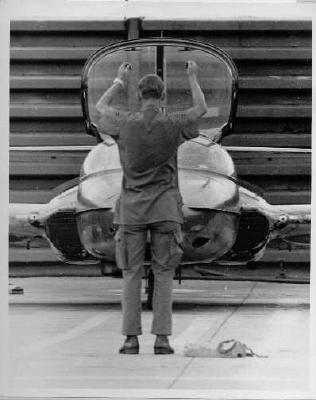
A-37 Crewchief (1971)
(Richard Dutcher on A-37 Association site)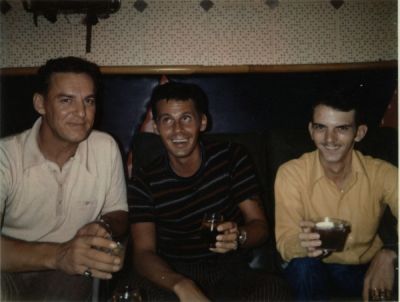
Air Force Advisory Team #6 had a bar.
Seated (L to R) are
MSgt Warren Hammaker (Intel NCO), TSgt Dan Brannan (Life Support),
A1C Rick Dutcher (Admin).
(Richard Dutcher on A-37 Association site)
Photos Courtesy William R. Stevens, MSgt, USAF (Ret)
Line Chief/"B"
Flight Chief, 8th SOS (Dec 71-Nov 72)
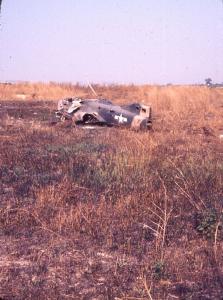  1. 72-3-17, Acft 355 #4 crashed at end of runway; 2. 72-03, 4 A-37's at OER; 1. 72-3-17, Acft 355 #4 crashed at end of runway; 2. 72-03, 4 A-37's at OER;   3. 72-03, A-37 at EOR; 4. 72-03, Behind barrier, walkway at barracks; 3. 72-03, A-37 at EOR; 4. 72-03, Behind barrier, walkway at barracks; 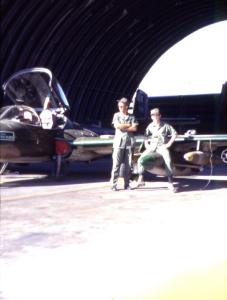 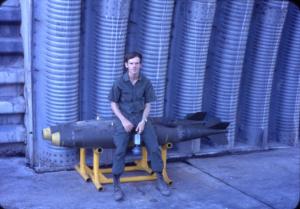 5. 72-03, Msgt Stevens & brother Danny (Army); 6. 72-03, Danny Stevens, brother visiting me at Bien Hoa #2; 5. 72-03, Msgt Stevens & brother Danny (Army); 6. 72-03, Danny Stevens, brother visiting me at Bien Hoa #2; 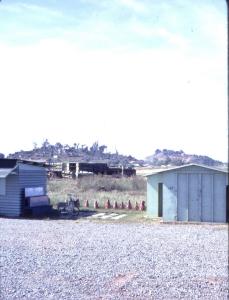 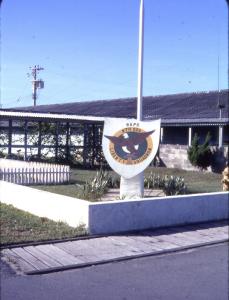 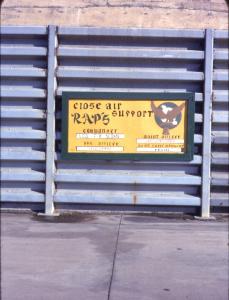 7. 72-03, EOR to country side; 8. RAPS sign at ops building; 9. 72-03, RAPS sign on revetment wall; 7. 72-03, EOR to country side; 8. RAPS sign at ops building; 9. 72-03, RAPS sign on revetment wall; 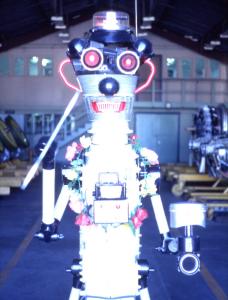 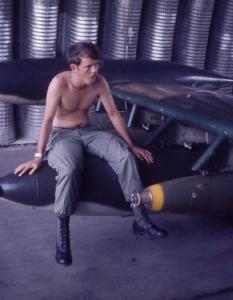 10. 72-03, Recip engine shop ''Robot'; 11. Brother Danny observing Msgt Stevens doing run on 347; 10. 72-03, Recip engine shop ''Robot'; 11. Brother Danny observing Msgt Stevens doing run on 347; 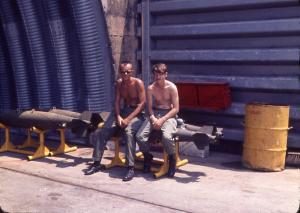 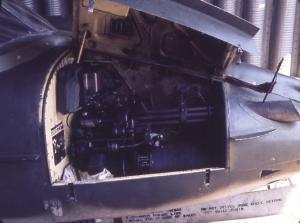 12. Both Stevens boys sitting on bombs; 13. 72-04, A-37 gatling gun bay; 12. Both Stevens boys sitting on bombs; 13. 72-04, A-37 gatling gun bay; 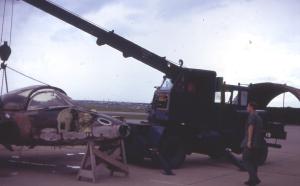 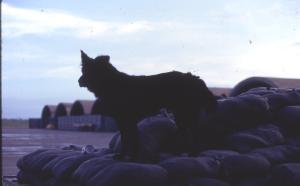 14. 72-5-2, Crashed & burned on base - Lt Moorehead OK; 15. 72-5-2, 'DEROS' on top of new bunker 'Guard Duty'; 14. 72-5-2, Crashed & burned on base - Lt Moorehead OK; 15. 72-5-2, 'DEROS' on top of new bunker 'Guard Duty'; 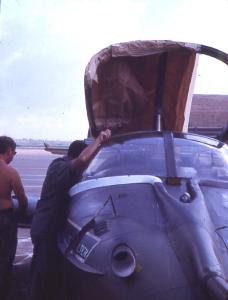 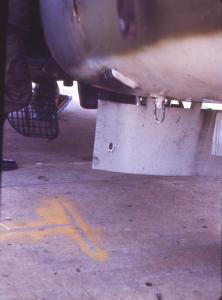  18. 72-6-12, Acft 360, still cleaning dockpit rt side of camopy gone; 19. 72-6-12, Acft 360, bullet entered thru rt side of speed brake; 20. 72-6-12, Acft 360 #4, still cleaning & repairing; 18. 72-6-12, Acft 360, still cleaning dockpit rt side of camopy gone; 19. 72-6-12, Acft 360, bullet entered thru rt side of speed brake; 20. 72-6-12, Acft 360 #4, still cleaning & repairing;   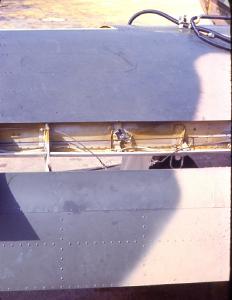 21. 72-6-12, Acft 360 #5, still cleaning & repairing; 22. 72-6-12, Acft 360 #6, bullet hole left wing near jack pad; 23. Acft 360 #7, bullet hole in flap recess; 21. 72-6-12, Acft 360 #5, still cleaning & repairing; 22. 72-6-12, Acft 360 #6, bullet hole left wing near jack pad; 23. Acft 360 #7, bullet hole in flap recess;  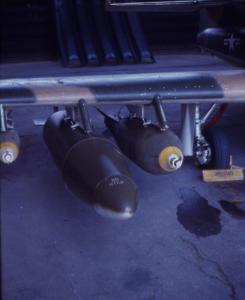 24. 72-06, 358 almost repaired; 25. 72-06, A-37 right wing loaded with a variety or ordinance; 24. 72-06, 358 almost repaired; 25. 72-06, A-37 right wing loaded with a variety or ordinance;  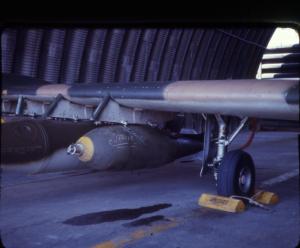 26. 72-06, 750's waiting to be loaded; 27. 72-06, A-37 right wing with 750 pounder; 26. 72-06, 750's waiting to be loaded; 27. 72-06, A-37 right wing with 750 pounder; 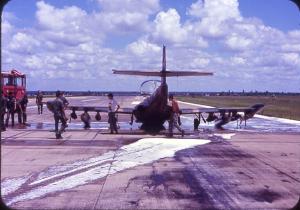 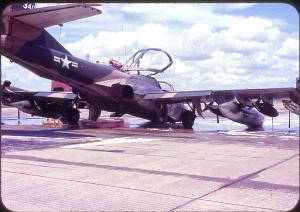 28. 72-06, Broke nose strut off on take off 69-6340; 29. 72-06, Broke nose strut off on take off 69-6340 #3; 28. 72-06, Broke nose strut off on take off 69-6340; 29. 72-06, Broke nose strut off on take off 69-6340 #3;  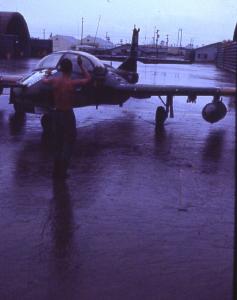 30. 72-06, Broke nose strut off on take off 69-6340; 31. 72-06, A-37 taxing in storm creating wake; 30. 72-06, Broke nose strut off on take off 69-6340; 31. 72-06, A-37 taxing in storm creating wake; 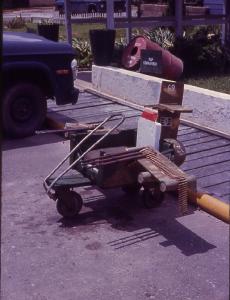 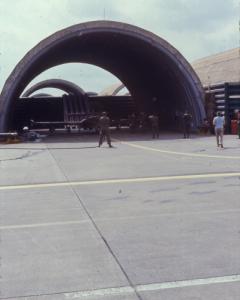 32. 72-06, Contraption; 33. 72-06, Last flight in revetment; 32. 72-06, Contraption; 33. 72-06, Last flight in revetment; 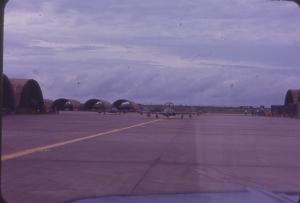 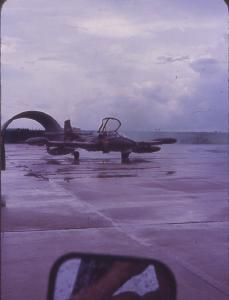 34. 72-06, Col Weed fini flight; 35. 72-06, Col Weed; 34. 72-06, Col Weed fini flight; 35. 72-06, Col Weed; 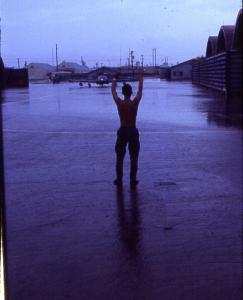 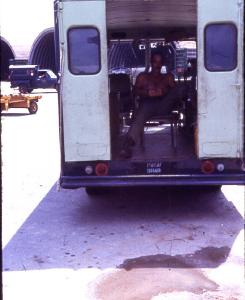 36. 72-06, Crew chief signaling pilot; 37. 72-06, Crew chief fishing in puddle after storm; 36. 72-06, Crew chief signaling pilot; 37. 72-06, Crew chief fishing in puddle after storm; 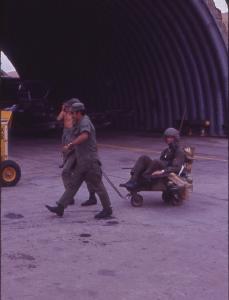  38. 72-06, Lt Col Weed taken to last flight; 40.72-06, Msgt Stevens & Sgt Gilsdorf working on 340; 38. 72-06, Lt Col Weed taken to last flight; 40.72-06, Msgt Stevens & Sgt Gilsdorf working on 340; 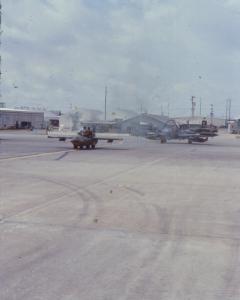  41. 72-06, Rap Mobile with smoke; 42. 72-06, Rocket damage to asphalt; 41. 72-06, Rap Mobile with smoke; 42. 72-06, Rocket damage to asphalt; 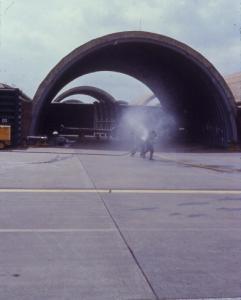 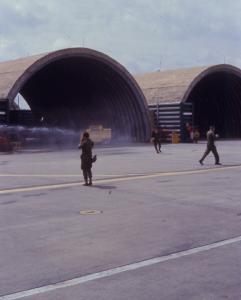 43. 72-06, The hose down begins; 44. 72-06, The hose down begins; 43. 72-06, The hose down begins; 44. 72-06, The hose down begins; 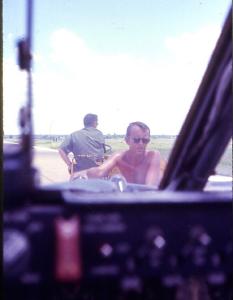 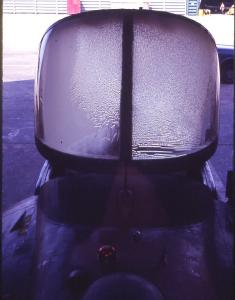 45. 72-07, After the work was done; 46. 72-06, took a .51 in the refueling boom; 45. 72-07, After the work was done; 46. 72-06, took a .51 in the refueling boom; 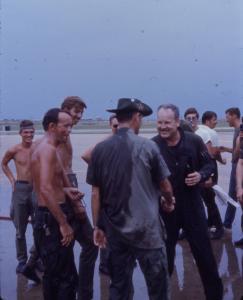 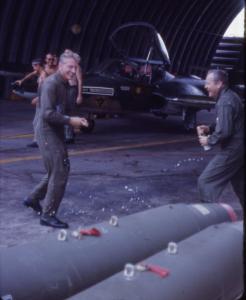 47. 72-07, Col Ledbetter's fini - with Msgt Stevens & Sgt Wynn; 48. Col Ledbetter's fini - with champagne; 47. 72-07, Col Ledbetter's fini - with Msgt Stevens & Sgt Wynn; 48. Col Ledbetter's fini - with champagne; 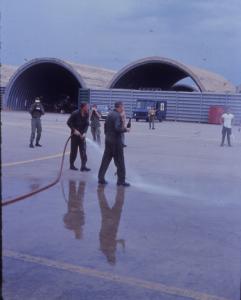 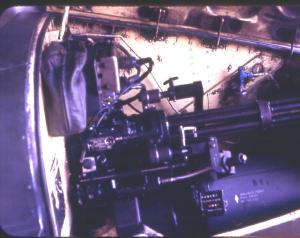 49. 72-07, Col Ledbetter's fini - with Col Weed; 50. 72-07, Gattling gun; 49. 72-07, Col Ledbetter's fini - with Col Weed; 50. 72-07, Gattling gun;  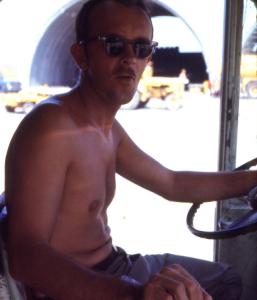  51. 72-07, Guard house on perimiter rd; 52. 72-07, Msgt Stevens in status truck; 53. 72-07, On perimiter rd; 51. 72-07, Guard house on perimiter rd; 52. 72-07, Msgt Stevens in status truck; 53. 72-07, On perimiter rd; 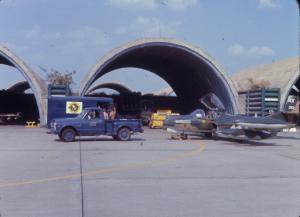 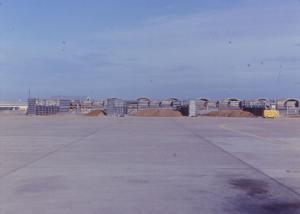 54. 72-06, We have to tow with anything; 55. 72-07, Ramp & taxiway near revetment work; 54. 72-06, We have to tow with anything; 55. 72-07, Ramp & taxiway near revetment work;  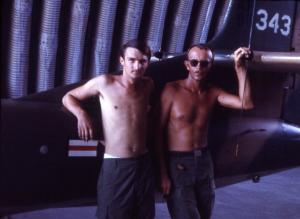 56. 72-07, Ramp & taxiway near transient area; 57. 72-07, Sgt Siple, Msgt Stevens with 343; 56. 72-07, Ramp & taxiway near transient area; 57. 72-07, Sgt Siple, Msgt Stevens with 343; 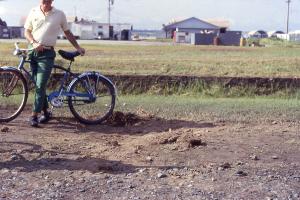 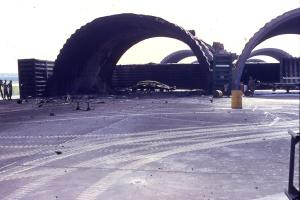 58. 72-08-31, mortar scar; 59. 72-08-31, revetment with remains of 339; 58. 72-08-31, mortar scar; 59. 72-08-31, revetment with remains of 339;  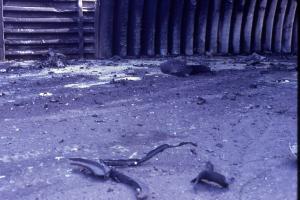 60. 72-08-31, inside revetment; 61. 72-08-31, inside revetment with pieces of 339; 60. 72-08-31, inside revetment; 61. 72-08-31, inside revetment with pieces of 339; 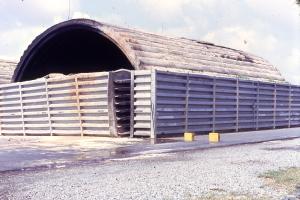  62. 72-08-31, same wall, but closer; 63. 72-08-31, looking toward front of revetment; 62. 72-08-31, same wall, but closer; 63. 72-08-31, looking toward front of revetment; 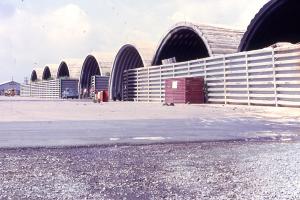 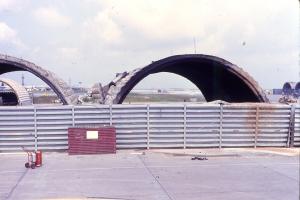 64. 72-08-31, another view of back side wall; 65. 72-08-31, view of top damage same revetment; 64. 72-08-31, another view of back side wall; 65. 72-08-31, view of top damage same revetment; 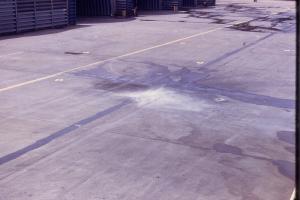 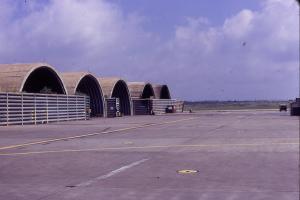 66. 72-08-31, mortar scar on taxiway between revetments; 67. 72-08-31, view of wall that was moved by blast; 66. 72-08-31, mortar scar on taxiway between revetments; 67. 72-08-31, view of wall that was moved by blast;  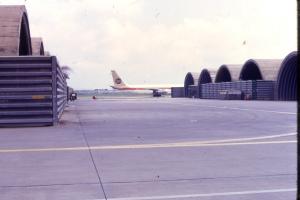 70. 72-08-31, damaged wing & tank acft 358; 71. 72-08-31, freedom bird taxiing by damaged area; 70. 72-08-31, damaged wing & tank acft 358; 71. 72-08-31, freedom bird taxiing by damaged area;   72. 72-08-31, damaged ambulance; 73. 72-08-31, damaged revetment - from alert pad; 72. 72-08-31, damaged ambulance; 73. 72-08-31, damaged revetment - from alert pad;   74. 72-08-31, Ssgt Rusk, Msgt Stevens, Sgt Treese where 339 sat; 75. 72-08-31, 339 blew up in this revetment - blast deflector; 74. 72-08-31, Ssgt Rusk, Msgt Stevens, Sgt Treese where 339 sat; 75. 72-08-31, 339 blew up in this revetment - blast deflector; 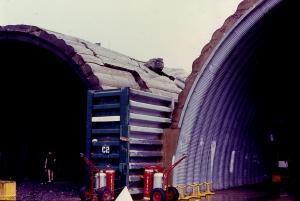 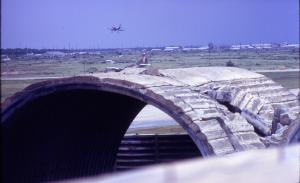 76. 72-08-31, 339 blew up in this revetment - from outside #1; 77. 72-08-31, 339 blew up in this revetment; 76. 72-08-31, 339 blew up in this revetment - from outside #1; 77. 72-08-31, 339 blew up in this revetment;  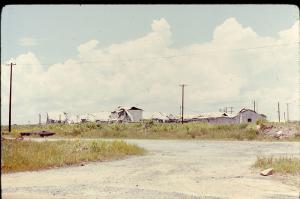 78. 72-08, Remaining ordinance destroyed (OED) #2; 79. 72-09-10, Damage from explosions; 78. 72-08, Remaining ordinance destroyed (OED) #2; 79. 72-09-10, Damage from explosions; 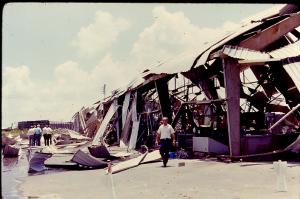  80. 72-09-10, Damage from explosions; 81. 72-09-10, Damage from explosions; 80. 72-09-10, Damage from explosions; 81. 72-09-10, Damage from explosions; 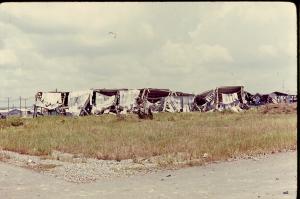  82. 72-09-10, Damage from explosions; 83. 72-09-10, Damage from explosions; 82. 72-09-10, Damage from explosions; 83. 72-09-10, Damage from explosions;  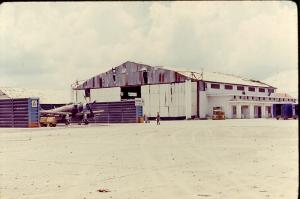 84. 72-09-10, Damage from explosions; 85. 72-09-10, Damage from explosions; 84. 72-09-10, Damage from explosions; 85. 72-09-10, Damage from explosions; 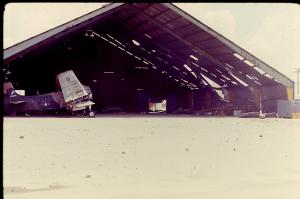 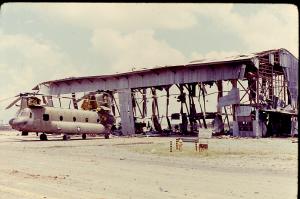 86. 72-09-10, Damage from explosions; 87. 72-09-10, Damage from explosions; 86. 72-09-10, Damage from explosions; 87. 72-09-10, Damage from explosions;   88. 72-09, 8th SOS maintenance sign; 89. 72-09, At EOR looking off base; 88. 72-09, 8th SOS maintenance sign; 89. 72-09, At EOR looking off base; 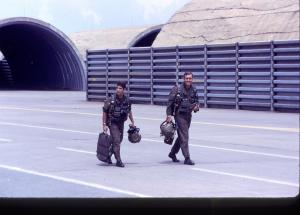  90. 72-09, Capt Nicholai, Lt Jordan; 91. 72-09, Crew chief bath; 90. 72-09, Capt Nicholai, Lt Jordan; 91. 72-09, Crew chief bath;  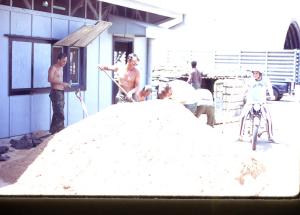 92. 72-09, filling sand bags; 93. 72-09, filling sand bags; 92. 72-09, filling sand bags; 93. 72-09, filling sand bags; 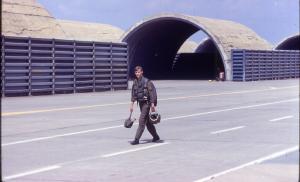 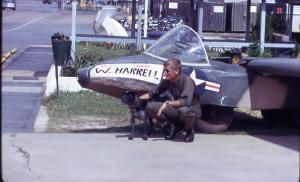 94. 72-09, Lt Gordon (Flash); 95. 72-09, Lt Harrell with his aircraft (after loss of 339); 94. 72-09, Lt Gordon (Flash); 95. 72-09, Lt Harrell with his aircraft (after loss of 339); 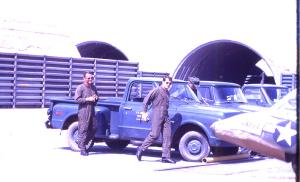 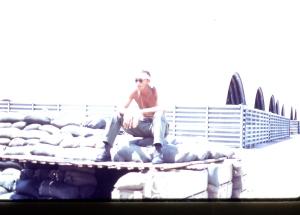 96. 72-09, Maj Beland, Lt Haynes, Lt Harrell (driver); 97. 72-09, Msgt Stevens on top of new bunker; 96. 72-09, Maj Beland, Lt Haynes, Lt Harrell (driver); 97. 72-09, Msgt Stevens on top of new bunker; 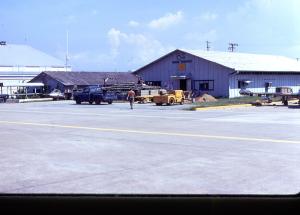 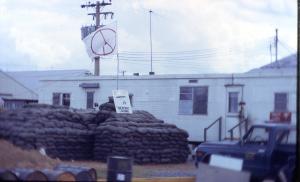 98. 72-09, New bunker in front of maintenance building; 99. 72-09, Peace flag flying over munitions crew trailer; 98. 72-09, New bunker in front of maintenance building; 99. 72-09, Peace flag flying over munitions crew trailer; 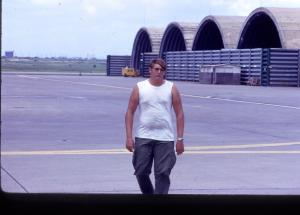  100. 72-09, Sgt Huber; 101. 72-09, Sgt Price; 100. 72-09, Sgt Huber; 101. 72-09, Sgt Price; 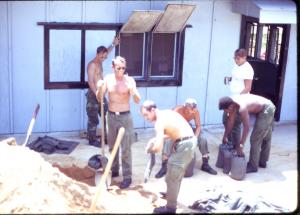 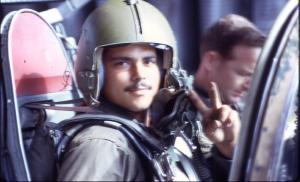 102. 72-09, Sgt Rusk, Msgt Stevens, Ssgt Price, Toussinault, Roundtree, Huber; 103. 72-09, Sgt Salazaar getting to fly with pilot #2 acft 358; 102. 72-09, Sgt Rusk, Msgt Stevens, Ssgt Price, Toussinault, Roundtree, Huber; 103. 72-09, Sgt Salazaar getting to fly with pilot #2 acft 358; 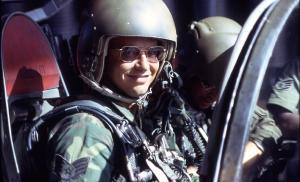 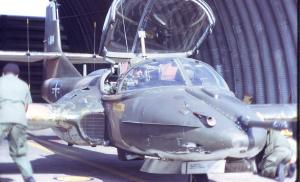 104. 72-09, Ssgt on test flight with Capt Medkiff aft 814; 105. 72-09, Ssgt Rusk with Capt Medkiff aft 814; 104. 72-09, Ssgt on test flight with Capt Medkiff aft 814; 105. 72-09, Ssgt Rusk with Capt Medkiff aft 814; 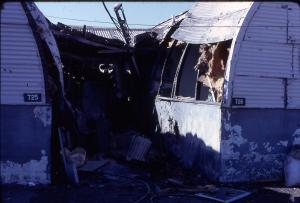  106. 72-11, Alert pad damage, no one hurt; 107. 72-11, All pilots of 8th SOS; 106. 72-11, Alert pad damage, no one hurt; 107. 72-11, All pilots of 8th SOS; 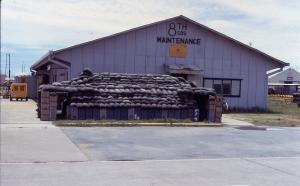 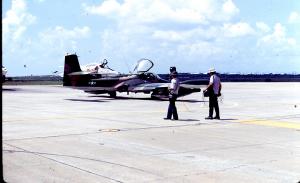 108. 72-11, beautiful new bunker #1; 109. 72-11, News crew filming mission #6; 108. 72-11, beautiful new bunker #1; 109. 72-11, News crew filming mission #6; 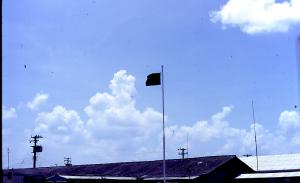 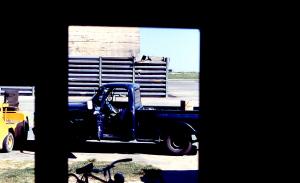 110. 72-11, Skull & cross bones flag; 111. 72-11, Rocket damage on corner of revetment - maint bldg; 110. 72-11, Skull & cross bones flag; 111. 72-11, Rocket damage on corner of revetment - maint bldg; 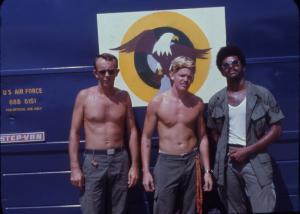 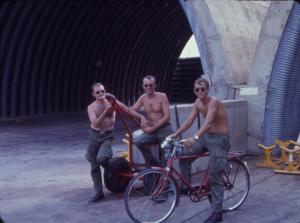 112. 72 - Msgt Stevens, Sgt Gilsdorf, Ssgt Fergunson; 113. 72 - SSGT Price, Msgt Stevens, SSgt Rusk; 112. 72 - Msgt Stevens, Sgt Gilsdorf, Ssgt Fergunson; 113. 72 - SSGT Price, Msgt Stevens, SSgt Rusk;  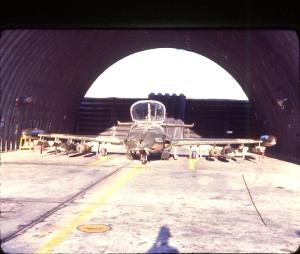 114. 72 Sgt Treece, Msgt Stevens; 115. 72, A-37 loaded & ready; 114. 72 Sgt Treece, Msgt Stevens; 115. 72, A-37 loaded & ready; 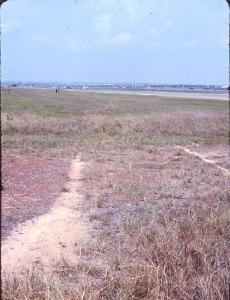 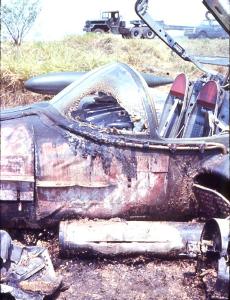 116. 72, Acft 348 skid path; 117. 72, Acft 348 Pilot Lt Moorehead OK; 116. 72, Acft 348 skid path; 117. 72, Acft 348 Pilot Lt Moorehead OK; 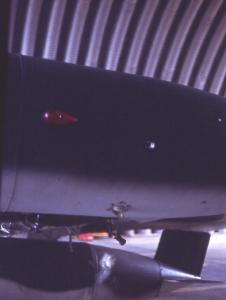 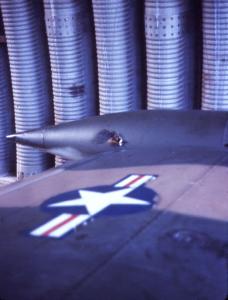  118. 72, Bullet hole lt tank entrance; 119. 72, Bullet hole lt tank exit; 120. Rain in flight line area; 118. 72, Bullet hole lt tank entrance; 119. 72, Bullet hole lt tank exit; 120. Rain in flight line area; 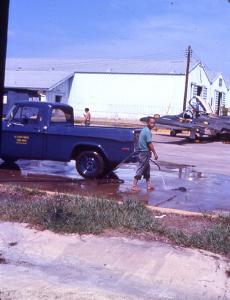 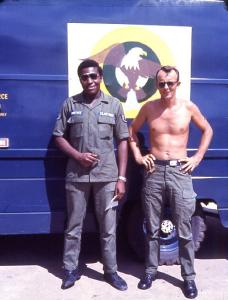 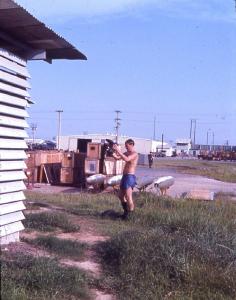 121. 72, Papasan washing OPS truck, 360 on wash rack behind; 122. 72, Ssgt Roundtree & Msgt Stevens; 123. 72-Spring, Lt Perigrim wringing out wet uniform & boots 121. 72, Papasan washing OPS truck, 360 on wash rack behind; 122. 72, Ssgt Roundtree & Msgt Stevens; 123. 72-Spring, Lt Perigrim wringing out wet uniform & boots
The following are photos by Earl Watson, then a SSgt with the 8th SOS at Bien Hoa. He wrote, "I served as a A-37 munitions load crew chief from January 1972 until the deactivation. I went from Bien Hoa to Tan Sonhut to work with FACs. I DEROS'd Nam in January of 1973."

500 pounders and CBUs | 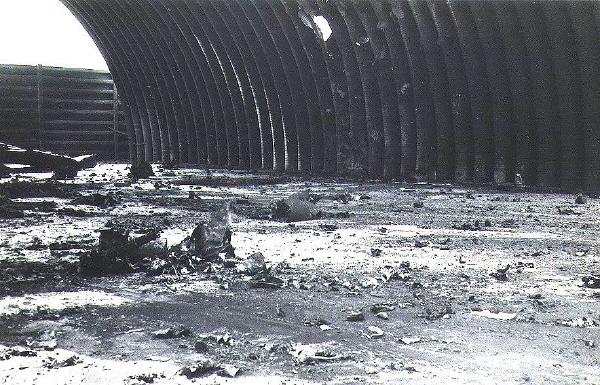
A-37 after 122mm Rocket | 
A-37 hanging with F-4s | 
Barracks Rocket Damage | 
Bien Hoa Flightline | 
Inspecting Shrapnel Damage | 
Downloading Damaged Bird | 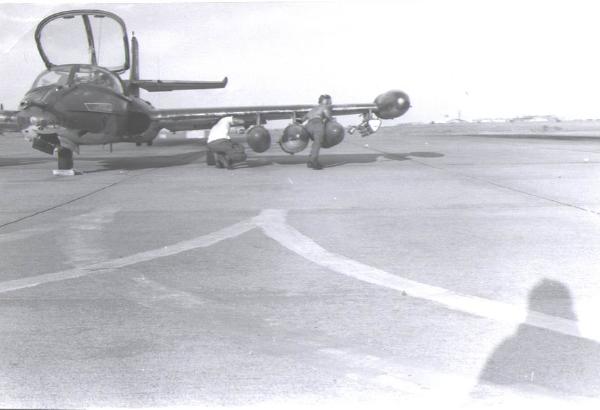
Pulling Safety Pins | 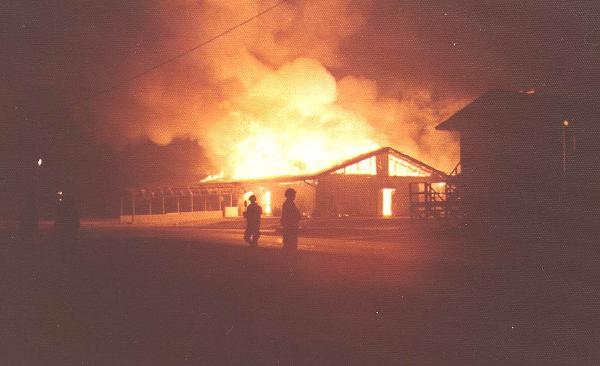
Anyone Remember this building? | 
Early AM Rockets | 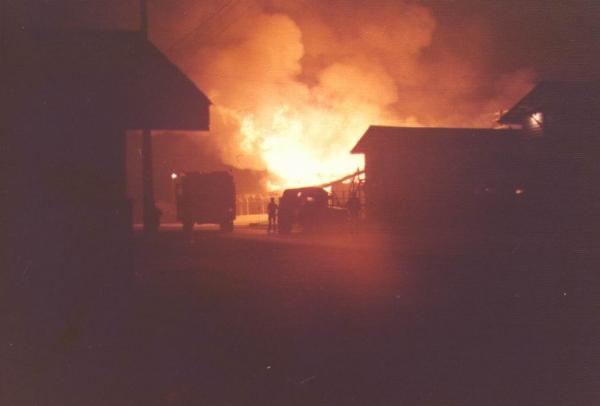
Rocket Attack fire | 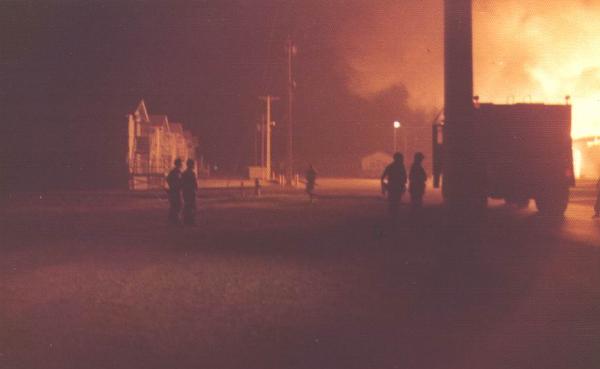
Lighting up the night | 
Flightline at Night | 
Spare Parts | 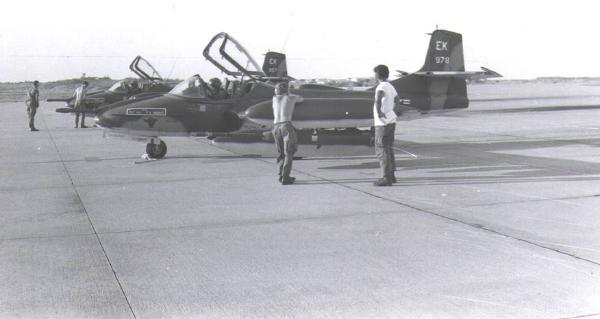
Training New Guys on Arm and Dearm | 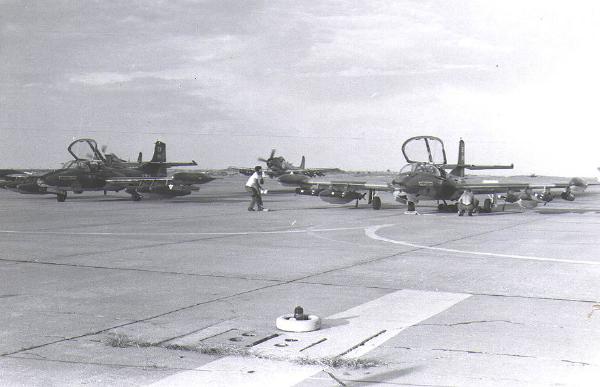
Daisy Cutters loaded on Right A-37 |

Poker with Cambodian A-37 Trainees
The War Goes On (1972) The Easter Offensive (Spring 1972) fighting was extremely nasty, but produced notable US battlefield victories. The American military managed to prevail in these struggles despite serious weakness caused by the US exodus from Southeast Asia. The US land component had shrunk from 550,000 troops at the height of the war in 1969 to only 95,000. During the same period, the strength of US air and naval forces fell to about one-third of their previous peak levels. The U.S. was desparately trying to disengage itself from the Vietnamese quagmire -- and the North exploited this weakness. In Military Region I, more than 40,000 North Vietnamese troops swarmed southward through the DMZ and eastward from camps in Laos. By April 2, the enemy had captured all intervening fire-support bases and was moving directly on Quang Tri City, the provincial capital. Interdiction by US Air Force fighter-bombers and B-52 bombers slowed the advance, but Quang Tri City was evacuated May 1. The enemy then reorganized for a drive on Hue.
In Military Region II, 20,000 Communist soldiers surged out of Laotian and Cambodian sanctuaries to attack the major cities of Kontum and Pleiku. The intent was to cut Pleiku off, then drive on to split South Vietnam in half. South Vietnamese troops fought well, stiffened by US advisors. Kontum, however, was cut off and surrounded. The city was sustained by a massive aerial resupply effort. In addition, the Communist military attack failed. US Air Force B-52s and tactical fighters combined with TOWtoting US Army UH-1s to defeat the northern invaders in the field, despite a monumental effort by huge numbers of North Vietnamese tanks and artillery.
In Military Region III, one regular North Vietnamese division and two Viet Cong divisions-some 30,000 men combined-sallied from their Cambodian salient to attack An Loc and Loc Ninh in hopes that a quick victory would lead to a drive down Highway 13 to Saigon itself. Hanoi sought an outright military victory in order to establish Communist control over South Vietnam, drive US forces from the South, and prevent the re-election of President Richard Nixon. They called the action the "Nguyen Hue Offensive" in honor of a Vietnamese hero who had inflicted a massive defeat on Chinese forces in 1789. The 1972 battles marked the final major US engagements of the Vietnam War. Moreover, they illumined the future of the Air Force more than anyone imagined at the time.
The U.S. forces in Vietnam were in deep trouble -- word was sent out. "SEND HELP NOW!!!" Easter Offensive: W. R. Baker stated:USAF assets were committed as soon as weather permitted. The combination of Tactical Air Control Systems, Forward Air Controllers, radar, and airborne command posts enabled American commanders to get the maximum effectiveness from the limited resources. B-52 bomber and tactical fighter attacks were provided in the most desperate situations as they arose, and gunships were allocated to the outposts under the heaviest fire. The gunships also provided mobile cover for retreating forces, laying down gunfire as roadblocks to the pursuing enemy armor.
While the in-theater forces were putting on a maximum effort, the orders went out for a worldwide mobilization of USAF units to return to Southeast Asia prepared to fight a vicious, protracted battle. The transfer of B-52s was called "Bullet Shot." The return of tactical fighters went by the name "Constant Guard" (I-IV). The 45 days following the start of the Easter Offensive saw the Air Force demonstrate global mobility and power on a massive scale. From bases in Korea, the Philippines, and the United States, additional fighters, bombers, gunships, electronic warfare birds, search and rescue units, transports, and tankers moved in a swift, smooth flow to Southeast Asia. In some instances, units were in combat just three days after they received orders to move.
The strike forces built up rapidly: Fighters doubled to almost 400, B-52 bomber strength increased to 171, and the number of tankers rose to 168. The Navy and Marines also responded, with the carrier force building to six.
In many instances, USAF's airmen were coming back for their second or third tours in the area, often to the same bases from which they had operated previously. The bases themselves were in varying states of readiness; after the years-long drawdown, the local population had stripped them of useful material, from radar gear down to household wiring, toilets, and window panes.
Air Force units returned to find runways intact, but not much else on hand, and tent cities sprouted where there had once been a complete base complex that had included air-conditioned hootches, clubs, theaters, and swimming pools.
Creature comforts were of little consequence, however, as the new units were immediately thrown into desperate battle. B-52 sorties in South Vietnam built from 689 in March to 2,223 in May. Fighter strike sorties of all branches (including the South Vietnamese air force) rose from 4,237 in March to 18,444 in May and were held at 15,951 in June.
USAF suffered heavy casualties. Between the start of the offensive and its withering away in June, the Air Force lost 77 aircraft, including 34 F-4 Phantoms. The scope of the conflict had been expanded on May 8 when Nixon authorized extensive strikes into North Vietnam itself under the code name Operation Linebacker. As it turned out, Nixon's decision to take the war north was crucial, because North Vietnam, as a result, could never muster the kind of logistical flow necessary to support such an intense offensive. 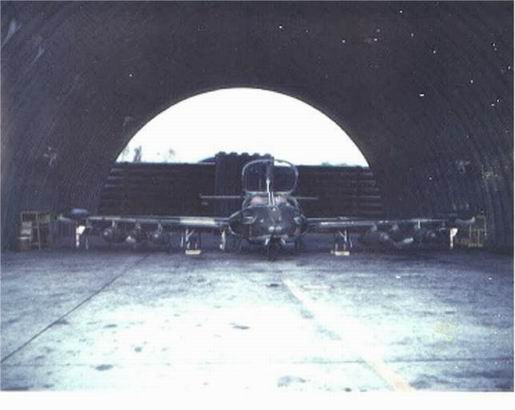
A-37 8th SOS Bien Hoa (1972) (AGE Ranger)
AGE Barn 8th SOS Bien Hoa (1972) (AGE Ranger)
AGE Ready Line 8th SOS Bien Hoa (1972) (AGE Ranger)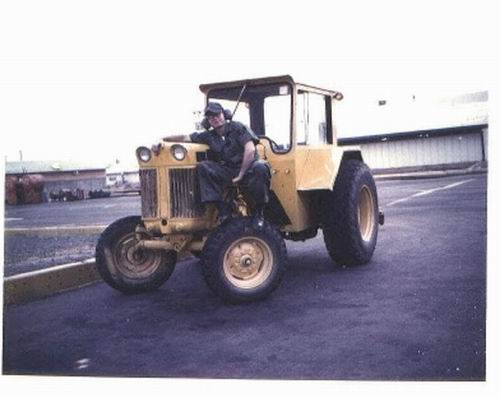
Case with AGE Tractor 8th SOS Bien Hoa (1972) (AGE Ranger)The effectiveness of the A-37 in close air support missions is illustrated by the following item excrepted from the US Army Aviation Digest web site (and found in the Dec 2003 newsletter of the A-37 Organization): LANDING ON FUMES
When then-Major Fred McNeill served as an O-2 FAC in the Central Highlands of II Corps during 1972, he operated out of Pleiku in Cambodia, Laos, and even extreme southern North Vietnam. In the spring of 1972, he was tasked to direct an airstrike in support of an ARVN firebase on the mountain top northwest of Kontum.
The ARVN had deployed a reconnaissance patrol, composed of about 100 ARVN troops and 20 U.S. Army advisors, along an extremely rocky and absolutely barren ridegeline that stretched swouth from the firebase. Once well away from their base, they began taking intense fire from an entire company of NVA regulars tahat were scaling the sides of the ridge from both directions.
When McNeill received the orders for a dawn close air support mission, the only available tactical aircraft was a pair of A-37Bs from Bien Hoa. Kontum was at the limit of their combat range. The squadron commander, Colonel Weed, and his wingman agreed to fly the mission, and McNeill asked them to bring all the napalm they could carry (about four 750-pound cannisters).
McNeill arrived in the target area at first light and contacted the pinned-down patrol. They were completely surrounded with no way to dig in or find cover on the rocky ridge. Casualties were already running to 30 percent and they were about to be overrun completely. The rules of engagement prohibited dropping napalm with 100 meters of friendly troops unless the troops were safely dug in.
However, the patrol leader insisted that McNeill direct the napalm attack they were going to die anyway if he did not. To be sure there was no misunderstanding or later recriminations, McNeill recorded the approval and the patrol leader's name on the tape recorder that was standard equipment on all combat aircraft in that war.
As the A-37s reported overhead and ready for the attack, with no excess fuel for subsequent attacks, McNeill briefed them carefully and told one of them to drop on the north side of the ridge and the other on the south side of the ridge.
McNeill placed one marking rocket on each side of teh ridge to mark the point where he wanted them to start laying down the napalm. He gae final attack directions to Colonel Weed and his wingman and then gave them a post-attack heading for a direct route to Pleiku, the nearest suitable airfield.
The Army radio-operator keyed his microphone to say something just as the napalm from the A-37s began to explode. As the initial explosions died out, McNeill could hear the troops hooping and hollering -- the napalm was laid precisely on target without hitting a single ARVN or U.S. Army soldier. The NVA immediately broke contact and pulled back after losing up to 300 of their own troops to the napalm.
The A-37s zoomed away and took up their heading for Pleiku with their fuel state dwindling. When McNeill landed back at Pleiku, he discovered that Colonel Weed's wingman had ran out of fuel on the runway and had to be towed to a parking spot for refueling.
The night in the Pleiku bar, neither of those Dragonfly pilots was able to buy his own beer, every Pleiku pilot was too impressed with their performance that day!
NOTE: Colonel Weed wrote to Ollie Maier of this article: "If I recall, we were nominated for the silver star on that mission, but the 7th AF downgraded it to a DFC with heroism. They said it was just another routine mission for the 8th SOS.
"In some respects they were correct. Pilots of the 8th flew many similar missions where they had to put napalm in exceptionally close to friendlies and had the expertise to do so."
"That's also about the time the strela came on scene but didn't shake our guys up as we learned to dodge it or home the sun and break."
When the FAC said strela, we didn't wait to find out who was being tracked, we just started pulling "Gs" in every which way direction and the SA 7 would wander off aimlessly and explode. They did take a pretty heavy toll on helicopters and a couple of 130's if I recall. (SITE NOTE: The USAF had no suppression for any of its aircraft against the SA7 Strela. Many helos were shot down as a result of this along with the FAC's. The AC130's were flying with the ramp down with the crew chiefs standing on the ramp shooting flares with a flare pistol at the SA7's in hope of diverting them.)
"In any case it's nice to be reminded of the great job the A-37 did and the many lives it saved during its tenure in Vietnam." Gordon Reed, Col, USAF (Ret) and 8th SOS Commander (May 1972-Nov 1972), wrote: "As you also probably know, the A-37 Fighter Bomber entered the picture during the Combat Dragon test phase and when it proved it effectiveness and versatility as a low level close air support aircraft, it phased into the 8th Special Operations Squadron due to the requirement of supporting troops in South Vietnam and Cambodia. When this took place
exactly I don't know. I entered the picture in July of 71, flew under the command of Lt/Col Frank Sloan. I was the operations officer and when Frank completed his tour in April of 72, I was fortunate enough to assume Command of the 8th which by then was a well tuned operation with an organizational
structure second to none. My operations officer, Lt/Col Mel Ledbetter was unequaled in his selection and training of flight commanders and the scheduling of young pilots for critical and demanding close air support missions. We were a well oiled machine and I don't think there was any member in the Squadron at that time that wasn't highly motivated and proud to be part of the 8th SOS."
From its centrally-located position in Phan Rang, the 808th SOS was able to respond to calls for close air support to the north and south in III and IV Corps areas with its 23 A-37Bs. The A-37 provided close air support during the intense fighting in An Loc in April and May. The 8th SOS is mentioned in Easter Offensive: W. R. Baker Photo Caption: "The A-37 light ground attack aircraft, a small but reliable tactical support aircraft, here dropping a 500-pound bomb. These aircraft, flown at An Loc by Lieutenant Colonel Gordon Weed and his 8th Special Operations Squadron, were extremely effective in the close fighting that characterized the battle for An Loc." (NOTE: Gordon Weed retired as a full colonel. It was during the Battle of An Loc on 11 May 1972 that 1Lt. Michael J. Blasie was lost. See Final Return Home and the Airman Magazine story below. The 8th SOS from Hurlburt Field had the honor of transporting Lt. Blassie's remains home in 1998.)
  1. 72-08, An Loc mission #3 - Taxi out with 344; 2. 72-08, An Loc mission #4 - at OER; 1. 72-08, An Loc mission #3 - Taxi out with 344; 2. 72-08, An Loc mission #4 - at OER;  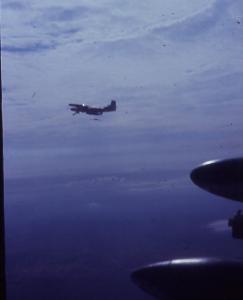 3. 72-08, An Loc mission #6 - in flight; 4. 72-08, An Loc mission #9 - wingman goes in; 3. 72-08, An Loc mission #6 - in flight; 4. 72-08, An Loc mission #9 - wingman goes in; 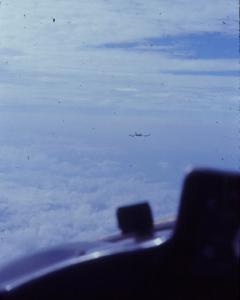 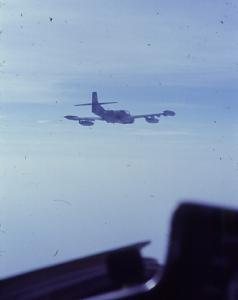 5. 72-08, An Loc mission #16 - joining up after; 6. 72-08, An Loc mission #17 - joining up after; 5. 72-08, An Loc mission #16 - joining up after; 6. 72-08, An Loc mission #17 - joining up after;  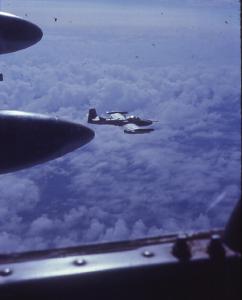 7. 72-08, An Loc mission #18 - joining up after; 8. 72-08, An Loc mission #19 - return flight; 7. 72-08, An Loc mission #18 - joining up after; 8. 72-08, An Loc mission #19 - return flight; 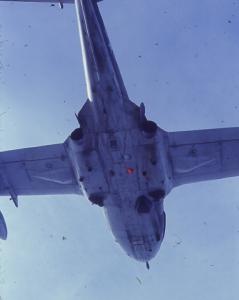  9. 72-08, An Loc mission #20 - checking bottom side; 10. 72-08, An Loc mission #22 - return flight; 9. 72-08, An Loc mission #20 - checking bottom side; 10. 72-08, An Loc mission #22 - return flight; 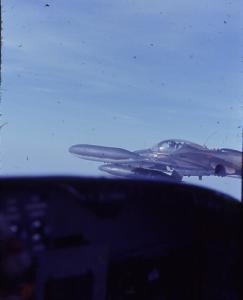 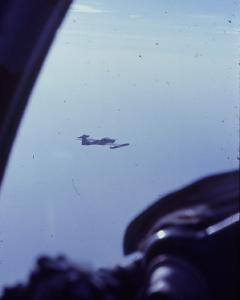 11. 72-08, An Loc mission #23 - return flight; 12. 72-08, An Loc mission #24 - return flight; 11. 72-08, An Loc mission #23 - return flight; 12. 72-08, An Loc mission #24 - return flight; 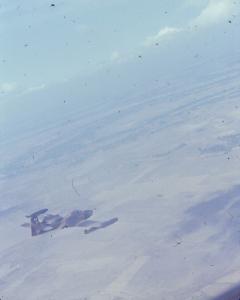 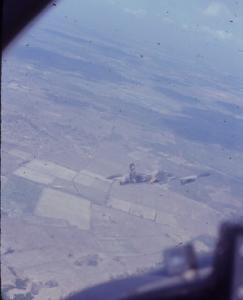 13. 72-08, An Loc mission #25 - return flight; 14. 72-08, An Loc mission #26 - return flight; 13. 72-08, An Loc mission #25 - return flight; 14. 72-08, An Loc mission #26 - return flight; 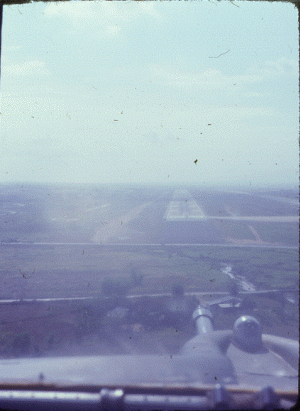  15. 72-08, An Loc mission #29 - landing approach; 16. 72-08, An Loc mission #29 - down at EOR; 15. 72-08, An Loc mission #29 - landing approach; 16. 72-08, An Loc mission #29 - down at EOR; 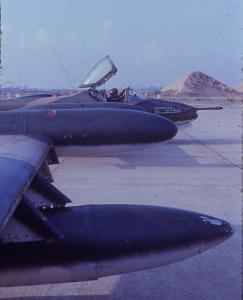 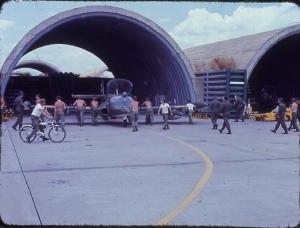 17. 72-08, An Loc mission #30 - down at EOR; 18. 72-08, An Loc mission #32 - push back into revetment - Capt Williams fini; (Photos Courtesy William R. Stevens) 17. 72-08, An Loc mission #30 - down at EOR; 18. 72-08, An Loc mission #32 - push back into revetment - Capt Williams fini; (Photos Courtesy William R. Stevens)Paper: They were Good Ol' Boys talks of the battle for An Loc in May 1972, "Men on the ground were lavish in their praise of the FAC'S from the 21st TASS and the A-37 pilots from the 8th Special Operations Squadron (SOS) at Bien Hoa. On one occasion, Lieutenant Colonel Gordon Weed, the SOS squadron commander, made two passes at rooftop level through heavy enemy flak to destroy a T-54 tank that was threatening the 5th ARVN Division command post (CP).21 Stopping the NVA was not without its price: on 11 May alone, the clusters of enemy air defense weapons downed four Air Force and Army aircraft."
In the June 2004 issue of the A-37 Association Newsletter, Gordon Weed related in a letter: "There were many aircraft on scene in those dark days including 130 Gunships, Helicopters and even B-52s. I sincerely believe that the A-1Es flon by the South Vietnamese and the A-37s from the 8th SOS were the most effective in stemming the tide of the North Vietnamese onslaught.
The number of sorties flown from Bien Hoa were phenomenal. ...
After An Loc was declared secure, General McGiffert came over to the 8th SOS to thank us for the Close Air Support we provided and awarded the Squadron "The Vietnamese Cross of Gallantry," with subsequent individual awards for each Pilot in the Squadron.
At the time he asked if I had been nominated for the Silver Star by 7th Air Force. I told him that if A-37 Pilots received the Silver Star for every routine low level strike typical of our Close Air Support Missions, 7th Air Force wouldn't have enough Silver Stars to go around.
I also said if you want to nominate anyone for a Silver Star take a hard look at the 21st Tass Pilots and especially pilots like Sundog 07 (Pep McPhillips). In my opinion, they are the unsung heroes of the Siege of An Loc. The An Loc advisors summed it up well. "There were good old boys."
Of the three major invasion thrusts, the stakes had been greatest in Military Region III where a decisive North Vietnamese drive past An Loc and into Saigon might well have won the war in a single battle. The fight for MR III typifies the struggle that unfolded in all three areas and can be used as a model to illustrate the powerful results achieved by USAF in all three regions. The strength of the Air Force effort was heightened by its use of battle-proven techniques.The enemy had brushed by weak ARVN resistance to put the town of An Loc under a siege that would last for two months and would become a byword for hardship and misery. The ARVN units invested at An Loc had no artillery with which they could respond to the almost continuous shelling of the city. The South Vietnamese army depended entirely upon aircraft for critical supplies.
The demand for aerial resupply was crucial in the battle for An Loc, where more than 20,000 personnel required everything to be brought in by air. The C-130 crews turned to a Ground Radar Aerial Delivery System with an improved parachute system with great success. Allied air forces operated in two modes. On the one hand, they were at the front lines, blunting attacks with bombs and rockets. Russian T-54 tanks littered the streets. On the other, they placed the besieging Communist forces under siege themselves by bombing supply dumps and routes. The "Linebacker I" effort to bomb North Vietnam with its B-52s ensured that the resupply of the offensive would be crippled. The massive weight of the American aerial effort finally paid off in the field; North Vietnamese forces suffered enormous casualties and were forced to withdraw in all three military regions. South Vietnamese forces were able to recapture their badly damaged cities.
In retrospect, it becomes clear that the American air assaults of spring 1972 bought South Vietnam three more years of existence. Giap, after suffering a third major battlefield fiasco, licked his wounds and waited for the right time to attack again. It came in spring 1975, when American forces had withdrawn, Nixon was no longer in the White House, and it was clear the American public no longer had the will to defend South Vietnam. Then, he attacked, and this time, without US backing, South Vietnamese military units offered scant resistance. Communist tanks finally rolled into Saigon on April 30, 1975. American airpower had been withheld, and Giap had his victory at last. But that's another story...
8th SOS Inactivated (Dec 1972) In 1971, the 3rd TFW was preparing to inactivate. On March 15, 1971, the 612th TFS moved from Misawa, Japan to Phan Rang Air Base to replace the Detachment 1, 612th TFS. A month later, the wing began phasing down for inactivation and stood down operations June 26, 1971. The 35th TFW transferred its remaining resources to the 315th Tactical Airlift Wing on July 31, 1971 -- including the 8th SOS -- when it inactivated.
Still flying its A-37Bs, it was attached to the 315th Tactical Airlift Wing from 31 Jul 1971. It would remain with the 315th TAW until 15 Jan 1972. (NOTE: The 315th TAW was first the 315th Air Commando Wing, Troop Carrier. It was then redesignated as the 315th Air Commando Wing, then became the 315th Special Operations Wing, then the 315th Tactical Airlift Wing.)
Then the 8th SOS was attached to the 377th Air Base Group (later 377th Air Base Wing) from 15 Jan 1972- 1 Oct 1972 as the unit transferred its assets to the VNAF. The last combat sorties were flown on 30 Sept 1972.
It was inactivated on 15 Dec 1972. During their operational tours in Vietnam the A-37B units lost 16 aircraft to enemy fire of which 14 were destroyed on the ground during rocket and mortar.
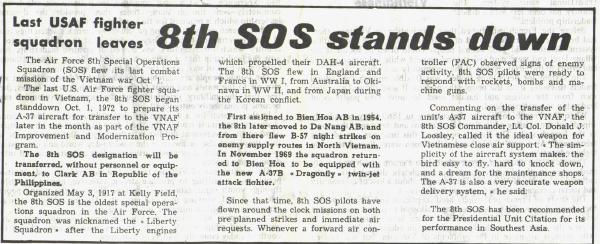
8th SOS Shuts Down (1972) (Air Forces News: Courtesy Earl Watson)
According to Historical Text Archives: Don Marby, "The war was costly. One and one-half million died in Indochina of whom 58,000 were Americans. Millions more were maimed. Some 500,000 people became refugees. From 1965-1971, the US spent $120 billion dollars directly on the war but other costs raised this amount to $400 billion. Costly, too, was its effect on the US military which thought itself invincible and had difficulty accepting the fact that it was not. Of course, the War of 1812 was a draw, at best, but Americans only paid attention to recent events. It was a long war but not as long as the War on Drugs or the perpetual war that the War on Terrorism promises to be. It left open wounds on the US psyche."
For its actions in Vietnam, it earned the following honors. Campaign streamers: Vietnam: Vietnam Advisory; Vietnam Defensive; Vietnam Air; Vietnam Air Offensive; Vietnam Air Offensive, Phase II; Vietnam Air Offensive, Phase III; Vietnam Air/Ground; Vietnam Air Offensive, Phase IV; TET 69/Counteroffensive; Vietnam Summer-Fall, 1969; Vietnam Winter-Spring, 1970; Sanctuary Counteroffensive; Southwest Monsoon; Commando Hunt V; Commando Hunt VI; Commando Hunt VII; Vietnam Ceasefire. Presidential Unit Citations: [12 Oct-12 Dec 1966 and 11 Feb-10 Apr 1967]; 6 Jun 1967-18 Jan 1968; 15 Nov 1968-31 May 1969.
8th Fighter Squadron: Becomes a Paper Unit (1972) In Nov 1972, the A-37Bs were turned over to the Vietnam Air Force (VNAF) and the personnel departed for stateside assignments. This was part of a process that started in 1970 called "Vietnamization," where the South Vietnamese were primed to provide the bulk of their own defense. In December 1972, the 8th SOS was inactivated.
Finally it was assigned to the 405th Fighter Wing of Clark AB, PI from 1 Oct 1972. This was strictly administrative as the 8th had become a "paper unit" by this time. The 8th SOS moved administratively to Clark AB, Philippines as a "paper unit" without men or aircraft from 1 Oct 1972-1 Mar 1974.
On 1 Jul 1973, the unit was renamed the 8th Fighter Squadron but remained a "paper unit" assigned to the 405th TFW of Clark AFB. The reason it was not simply deactivated is that the unit was the second oldest squadron in the Air Force -- and historically significant.
Life after Vietnam (1974) The unit reverted to its old name the 8th Special Operations Squadron on 1 Mar 1974 when it was assigned to Eglin Air Force Auxiliary Field No. 9 (Hurlburt Field) FL. It departed Clark AB for Florida in March of 1974 without personnel or aircraft and transitioned to the MC-130E "Combat Talon I".
It was first assigned to the 1st Special Operations (later, 834th Tactical Composite; 1st Special Operations) Wing on 1 Jul 1974. It was later assigned to the 1st Special Operations (later 16th Operations) Group on 22 Sep 1992. The squadron absorbed the personnel and equipment (Lockheed MC-130E Combat Talon 1) of the inactivated 318th Special Operations Squadron. On 20 June 1975, the 8th SOS absorbed the assets of the 415th Special Operations Training Squadron gaining the Lockheed AC-130A and AC-130H gunships. Later that year these assets were transferred to the 919th Special Operations Group and the 16th Special Operations Squadrons, respectively.
An interesting side note occurred during the fall of Vietnam in April 1975 concerning the A-37Bs which were turned over to the VNAF. According to VNAF.net, "VNAF A-37Bs attack Tan Son Nhut air base
By Nghia T. Ta
The attack took place in the early evening April 28, 1975. A flight of three A37Bs from Phan Rang AB (already captured by the NVA) were enroute to Tan Son Nhut. The flight did not attempt to contact the tower and started to bomb the parked aircraft right away. It was around dinner time so there wasn't much activity at Tan Son Nhut. The flight was led by Nguyen Thanh Trung who had bombed the presidential palace weeks earlier. The wingmen were Lt. Ky and Lt. On from the 516th Fighter Squadron. My uncle friend, Capt. Nguyen Bay, has trained these two pilots as they came from an observation squadron flying O-1E. Capt. Nguyen Bay said that these two pilots were stuck in Da Nang when the city fell. They were forced to fly this mission. Also on board (in the right seat) were pilots from the North Vietnamese Air Force. The bombing destroyed some transport aircraft. There was return fire from ARVN anti aircraft artillery. but none of the attacking planes were hit.
After taking over SVN, the Communists forced some of the VNAF pilots and maintenance personnel to train them on the left behind aircraft. One VNAF C130 pilot told me that he was forced to translate the C130 flight manuals into Vietnamese. The Communists would reportedly fuel the aircraft with just enough fuel so the pilots couldn't escape to neighboring countries. However, there was one incident where a UH-1H had escaped to Thailand. The VNAF pilot and the rest of the Communist crew had agreed to flee. 1st Lt. Ho Kim Hai who flew UH1 out of Pleiku AB. As the VC advanced south in March 1975. His squadron was moved to Can Tho to regroup. When SVN was lost, Lt. Hai was forced to train the VC pilot on the UH1s. On March 1976, Lt. Hai stole a UH-1 along with a VC crew. First, he flew the UH-1 to a predetermined landing spot to pick up his wife and four kids before heading to Chantaburi, Thailand (I presume that he did not have enough fuel to fly farther than that). Lt. Hai is now an electrical engineer working and residing in San Jose, CA.
Cessna A-37A/B DragonflyT-37A Trainer The T-37A "Tweet" trainer made its first flight in 1955 and went into service with the Air Force in 1956. The T-37 Tweet is a twin-engine jet used for training undergraduate pilots, undergraduate navigator and tactical navigator students in fundamentals of aircraft handling, and instrument, formation and night flying.
The Cessna A-37 was derived from the proven T-37 trainer in 1962. Two YAT-37D prototypes were produced from existing T-37s for evaluation by the United States Air Force in the counterinsurgency role. Combat tests in South Vietnam showed that the YAT-37D was underpowered. A decision was made to fit the A-37 with two General Electric J-85 turbojets. The new A-37A could double its takeoff weight and thus carry a larger bomb load. Five hundred seventy-seven A-37s were built. A-37s were used with great success in Southeast Asia. The South Vietnamese Air Force was also equipped with the Dragonfly.
In an article History in Blue: Robert F. Dorr stated, "Air Force pilots flew air-to-ground missions, and some helped train the South Vietnamese to fly the aircraft. The A-37B received few headlines, but it was frequently on the scene for close-air support when friendly troops were under attack. Fredric Neumann, a maintainer who served with the 602nd Fighter Squadron in Vietnam, said, “The A-37 followed the KISS [Keep it simple, stupid] principle. It was well-equipped for operations from primitive airfields and required little of the fancy, high-tech maintenance needed by more sophisticated warplanes like the F-4 Phantom.”
According to Greg Goebel / In The Public Domain: Cessna T-37/A-37, The first YAT-37D flew in October 1964, followed a year later by the second prototype. The second prototype had four stores pylons under each wing, rather than three, and the first prototype was upgraded to this configuration as well.
Test results were good, but USAF interest in COIN aircraft had faded for the moment. The program went into limbo for a time, with the second prototype "put out to pasture" at the Air Force Museum at Wright-Patterson Air Force Base in Ohio.
However, the war in Southeast Asia continued to escalate. Losses of Douglas A-1 Skyraider close-support aircraft in US and South Vietnamese hands proved greater than anticipated, and so USAF interest in COIN aircraft revived. The YAT-37D seemed like a promising candidate for the job, but the Air Force felt the only way to be sure was to evaluate the aircraft in combat.
As a result, the USAF issued a contract to Cessna for a preproduction batch of 39 YAT-37Ds, with a few minor changes relative to the prototypes, to be rebuilt from existing T-37Bs. These aircraft were initially designated "AT-37D", but the designation was quickly changed to "A-37A". The second prototype YAT-37D was yanked out of the Air Force Museum and upgraded to A-37A standards as part of the test program.
The A-37A had a gross takeoff weight of 5,440 kilograms (12,000 pounds), of which 2,130 kilograms (2,700 pounds) was warload. The A-37A retained the dual controls of its T-37B ancestor, allowing it to be used as an operational trainer.
In combat "forward air control (FAC)" operations, the second seat was occupied by an observer. Only one crewmember normally flew in the aircraft for close support missions, permitting a slight increase in warload.
In August 1967, 25 of the A-37As were sent to Vietnam under the "Combat Dragon" evaluation program, and flew from Bieh Hoa Air Force Base on USAF "air commando" missions, including close air support, helicopter escort, FAC, and night interdiction. Warloads included high-explosive bombs, cluster munition dispensers, unguided rocket packs, napalm tanks, and the SUU-11/A Minigun pod. For most missions, the aircraft also carried two additional external tanks on the inner stores pylons.
The A-37As flew thousands of sorties. None were lost to enemy fire, though two were wrecked in landing accidents. The A-37A was formally named the "Dragonfly", but most pilots called it the "Super Tweet". It is an interesting question if that meant the A-37A was even noisier than the T-37. Combat Dragon: A-37A Evaluaton According to Greg Goebel / In The Public Domain: Cessna T-37/A-37, "The Combat Dragon program was very successful, but unsurprisingly the combat evaluation revealed some of the deficiencies of the A-37A. The worst problem was that the aircraft lacked range and endurance. Other concerns were heavy control response during attack runs and the vulnerability of the aircraft's non-redundant flight control system. The USAF signed a contract with Cessna in early 1967 for an improved Super Tweet, designated the "A-37B". The initial order was for 57 aircraft, but this was quickly increased to 127. The A-37Bs were primarily intended to be supplied to the South Vietnamese Air Force as replacements for their Skyraiders. The A-37B prototype was rolled out in September 1967, with deliveries to the South Vietnamese beginning in 1968."
According to USAF Museum: Cessna A-37AOn 23 August 1966, the USAF directed the establishment of a program to evaluate the A-37 in a combat environment. The project was named "Combat Dragon" and was designed to test the effectiveness of the A-37 in Close Air Support, Counterinsurgency and escort missions in Vietnam. Besides testing the aircraft operationally, the project was also used to evaluate the maintenance, supply and manpower requirements. The Tactical Fighter Weapons Center directed the program and established a 350-man squadron with 25 A-37A's at England AFB, Louisiana in early 1967. The unit was designated as the 604th Air Commando Squadron (ACS). Initial instructor pilot training began on 29 March 1967, initial operations and combat orientation started on May 1st. Phase I of "Combat Dragon" was done between 19 June and 16 July 1967 at England AFB. Phase I measured data collection and analysis procedures to be used during the actual combat evaluation, train the A-37A pilots, establish a bombing and gunnery baseline, and identify and fix problems with the aircraft.
The 604th ACS was moved to Bien Hoa Air Base, South Vietnam between 17 July and 14 August 1967. Phase II of "Combat Dragon" began on August 15th and ended on September 6th. This phase of the project was used to familiarize the pilots was the operational areas of Vietnam and Laos. The data collection and evaluation system was also refined using forms and methods already in use in Southeast Asia. Phase III of "Combat Dragon" began on September 7th and the first actual ground strike missions were flown. Phase III operations continued until 27 October. Phase IV of "Combat Dragon" was done between October 28th and 30th and tested accelerated (maximum sortie generation) mission scheduling. Phase V began on November 1st and tested the ability of the aircraft to operate from a forward operating location. Seven aircraft were deployed to Pleiku Air Base and flew combat mission through December 2nd. The remaining 18 aircraft remained at Bien Hoa AB and flew normal (Phase III) combat strike missions.
The 604th ACS flew about 5,000 training and combat sorties during the five phases of the "Combat Dragon" project. During Phase III each aircraft averaged between 3 and 4 missions every 2 days. During Phase IV, the maximum sortie rate reached 6.3 missions per day per aircraft. During Phase V, three new missions were flown: Forward Air Control (FAC), armed reconnaissance and night interdiction. In addition to missions with South Vietnam, Phase V missions were flown in southeast Laos. in the Tigerhound areas. 
8th SOS A-37B cockpit (1970)
(Det 6 600th Photographic Squadron:
Wavelen Wayne Fielder )A-37B According to Greg Goebel / In The Public Domain: Cessna T-37/A-37, The A-37Bs were all new-build aircraft. They were stronger than the A-37A, stressed to 6 gees instead of 5, and had a longer fatigue life of 4,000 hours. Field experience would show that 7,000 hours was more in line with reality.
The A-37B weighed almost twice as much as the T-37C. A remarkable fraction of the loaded weight, 2.67 tonnes (5,880 pounds), could be external stores. In practice, the A-37B usually operated with at least two and sometimes four underwing fuel tanks to improve combat endurance.
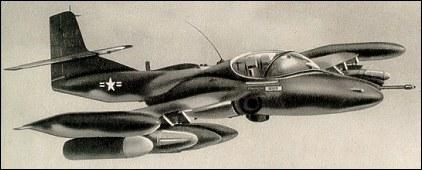
A-37B DrawingTo get this greater weight off the ground, the A-37B was fitted with General Electric J85-GE-17A engines, providing 12.7 kN (1,300 kg / 2,850 lb) thrust each. These engines were canted slightly outward and downward to improve single-engine handling. Air commando pilots in Vietnam operating the A-37A had found single-engine cruise an effective means of improving their flight endurance.
Modifications were made to control surfaces to improve handling. To improve aircraft and crew survivability, the A-37B was fitted with redundant elevator control runs that were placed as far apart as possible. The ejection seats were armored, the cockpit was lined with nylon flak curtains, and foam-filled self-sealing fuel tanks were installed.
The A-37B added a refueling probe to the nose, leading to pipes wrapped around the lower lip of the canopy, for probe-and-drogue midair refueling. This was an unusual fit for USAF aircraft, which traditionally are configured for boom refueling. Other improvements included updated avionics, a redesigned instrument panel to make the aircraft easier to fly from either seat, an automatic engine inlet de-icing system, and revised landing gear. Like its predecessors, the A-37B was not pressurized.
20 millimeter and 30 millimeter cannon pods were developed for the A-37B to give it more punch, but apparently such pods were rarely or never used in operation.
* A total of 577 A-37Bs were built, with 254 delivered to the South Vietnamese Air Force. They reportedly performed well in actions against Communist forces. When South Vietnam fell in early 1975, a South Vietnamese Air Force officer, Captain Nguyen Thanh Trung, defected to the Communists and led strikes against South Vietnamese government positions in his A-37B.
There were about 187 A-37Bs in South Vietnamese hands when the country fell. 92 were recovered by the Americans, while the other 95 were later used by the Communist Vietnamese in missions over Cambodia. These "renegade" aircraft were phased out of service in the late 1970s or early 1980s, no doubt due to lack of spares.
After the war, the USAF passed their A-37Bs from the USAF Tactical Air Command to Air National Guard and Air Force Reserve units. In the early 1980s, these aircraft were assigned the FAC role and given the designation "OA-37B". The OA-37Bs were eventually phased out and replaced in the FAC mission by the much more formidable Fairchild OA-10A Warthog.
The A-37B was also exported to Latin American air arms, mostly during the 1970s. It was well suited to their needs because of its simplicity, low cost, and effectiveness for insurgent warfare. Most of the A-37Bs exported south had the refueling probe shortened to act as a single-point ground refueling probe, or deleted completely.
Latin American countries that received the A-37B included Peru (36 aircraft), Chile (34), Columbia (14 originally, plus 12 reportedly supplied later), Ecuador (12), Uruguay (8), Honduras (15), Guatemala (13), and El Salvador (18). Super Tweets remain in service in some of these countries in slowly declining numbers. According to Dennis SelvigCombat Record
During the SouthEast Asian War it served mostly in the III and IV Corps areas of South Viet Nam. It was especially well suited for troops in contact situations where its accuracy and loiter time made it a favorite of the FAC's as well as ground troops and commanders. Its achievements in combat were recognized by awarding A-37 units the Air Force Outstanding Unit Award. It flew over 165,000 sorties in Viet Nam!
The Dragonfly pulled alert duty at Bien Hoa Air Base (about 30 miles from Saigon) and from there was able to reach into most of the southern areas of South Viet Nam. It flew both day and night missions in visual meteorological conditions.
The moderate speed of the aircraft gave it much greater accuracy than other fighters of that time. The speed caused experienced enemy gunners to overlead the aircraft and shoot in front of it. The A-37's small size also reduced its vulnerability and increased survivability. It did not go through the war without losses, but its survivability surprised many.
One of the few aircraft made with an unusual ability, it could carry its own weight. This meant a combat configuration of 4 Mk82 500 lb bombs, 2 pods of rockets, and a load of gun ammo. This was equivalent to the load carried by the F-100 Super Saber (not counting the 20MM gun). In close range missions, the A-37 could actually get bombs on target faster than the F-100 since the "Hun" had to burn off some fuel before it could go to work. It could also hit the target, climb up to pattern altitude and return to make another pass quicker than any other. According to The Great Adventures of Bob and DonWe were pleasantly surprised with the airplane, while the A-37B on first glance looked like the "A" model; it was a completely different bird. One of the biggest improvements was the newer J85-17A engine capable of producing 2,850 lbs. of thrust that replaced the "A" model's 2,400 lb. thrust engines. Also, the inclusion of an inflight refueling (IFR) capability was another performance enhancement the airplane received. Bill Eaves, who assumed the role as our weapons guy, made some important recommendations late in the development phase that endorsed the better gun system that had a selectable firing rate of 3,000 or 6,000 rounds per minute. Being an old "Hun" driver he also made some recommendations on improving the weapons control panel, the optical gun site, the nose mounted gun camera, and a strike camera to be mounted in the lower center fuselage section. The new airplane also had much better flight characteristics that were the result of a redesigned flight control system that now had redundant control cables to the rudder and elevators and much needed aileron boost tabs.
Several flight publications reported at the time that the A-37 had so much thrust relative to its size, that pilots had to reduce power immediately after takeoff to keep from exceeding the gear limit speed. The A-37B at low fuel weights did have a 1:1 thrust to weight ratio and was able to takeoff and immediately execute a half loop with an immelman at the top and continue into a repeat maneuver. I believe that the F-16 demonstration aircraft currently perform this maneuver at many of their airshows. It should be pointed out that the A-37 perfected this maneuver over 35 years ago.
While there were only 39 A-37As built, Cessna built a lot more of the "B" models, close to 600 in all. Sadly, the A-37 was only used for a relatively short period by the U.S. Air Force being assigned to only two stateside training squadrons and two TAC fighter squadrons the 6th, and 603rd. However, many of the aircraft did have longer service lives flying in SVN, Panama, the Air Force Reserve and Air National Guard. The 4532nd and 4408th Combat Crew Training Squadrons at England AFB initially trained over 75 USAF and 150 South Vietnamese Air Force pilots.


- SPECIFICATIONS: A-37A
- Span: 35 ft. 10 in.
- Length: 29 ft. 4 in.
- Height: 8 ft. 2 in.
- Weight: 11,700 lbs. max.
- Armament: Max. of 3,000 lbs. including one GAU-2/A 7.62mm "Gattling" gun, plus additional gun pods, high-explosive bombs, fire bombs, rockets, grenades, and/or missiles
- Engines: Two General Electric J85s of 2,400 lbs. thrust each
- Cost: $161,000
- PERFORMANCE
- Maximum speed: 485 mph.
- Cruising speed: 425 mph.
- Range: 270 miles with 3,000 lb. load
- Service Ceiling: 36,000 ft.
- Nicknames: Super-Tweet
- SPECIFICATIONS: A-37B
- Span: 38 ft. 5 in.
- Length: 29 ft. 4 in. (31 ft. 10 in. including refueling boom)
- Height: 9 ft. 6 in.
- Weight: 14,000 lbs. gross weight (15,024 lbs. after in flight refueling)
- Armament: one GAU-2B/A 7.62mm "Gatling" gun with 1500 rounds of ammunition, plus 6,000 lbs. (800 lbs. on each of the inboard pylons, 600 lbs. on the middle two pylons and 500 lbs. on the outboard pylon) of mixed ordnance on 8 hardpoints including additional gun pods, high-explosive bombs, fire bombs, rockets, grenades, and/or missiles (Note: the aircraft rarely flew with more than 4,000 lbs. of ordnance)
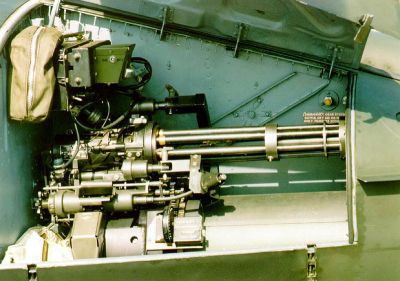
GAU-2BA 7.62mm Minigun
(Rick Hunter)Engines: Two General Electric J85-GE-17/A axial flow turbojets of 2,850 lbs. thrust each Cost: $161,000PERFORMANCE - Crew: 2 (usually flown with just a pilot in the left seat)
- Maximum speed: 416 knots at 15,500 ft., maximum power
- Cruising speed: approximately 260 knots
- Range: 808 nautical miles with 847 gallons of fuel at 257 knots average in 3.14 hours at 12,736 lbs. takeoff weight
- Combat radius: 140 nautical miles with 3,152 lb. payload at 259 knots avg. in 1.38 hours
- Service Ceiling: 25,000 ft. operational limit (cockpit not pressurized)
Nicknames: Super-TweetAccording to Wright-Patterson AF Museum: A-37B The A-37B was an improved version of the A-37A. One improvement was the installation of fully rated J85 jet engines capable of producing 2,850 lbs. of thrust at maximum power. The J85 engines fitted to the -A model "Dragonfly" were derated to 2,400 lbs. thrust maximum. Another major difference was the inclusion of an in flight refueling (IFR) system with the refueling probe fitted to the nose of the aircraft. The A-37B used the probe and drogue method of IFR rather than the boom and receptacle method normally used on USAF fixed wing aircraft. The increased thrust of the engines gave the aircraft a maximum gross takeoff weight of 14,000 lbs. The use of the IFR system allowed the aircraft to fly with a maximum gross weight of 15,000 lbs. -- the aircraft would takeoff with a heavy load of ordnance and limited fuel, conduct an IFR, then proceed on its mission. Other changes included improvements in the gun system: a selectable firing rate of 3,000 or 6,000 rounds per minute, an upgraded optical gun site, a nose mounted gun camera, and a strike camera mounted in the lower center fuselage. The control system also had some improvements: redundant control cables to the rudder and elevators and aileron boost tabs.
Cessna built a total of 577 A-37B's. The aircraft was used for a relatively short period by the USAF; however, many aircraft had long service lives flying for the Air Force Reserves and Air National Guard. The United States also supplied many aircraft to foreign countries including South Vietnam during the late 1960's and early 1970's. The 4532nd Combat Crew Training Squadron at England Air Force Base in Louisiana initially trained over 100 South Vietnamese Air Force pilots. Each VNAF student received 112 hours of ground instruction and 85 hours of flight training. After training was completed, the VNAF pilots returned to Vietnam to fly A-37's supplied under the US Military Assistance Program (MAP). South Vietnam had 10 squadrons of A-37's at peak strength during the early 1970's.
The OA-37 Dragonfly derivative was an armed observation aircraft developed during the Vietnam War. The OA-37 "DRAGONFLY" replaced the aging O-2A in the early 1980s. It continued in use with Air Guard and Reserve units as observation platforms until the 1980s. Recommended publication on T-37/A-37: A-37/T-37 Dragonfly in Action (Aircraft ; No. 114) by Terry Love (Editor), Joe Sewell, Squadron/Signal Publications, 1991. Available used: from $99 on Amazon.com. Greg Goebel: "Like most of the SQUADRON/SIGNAL publications, this is an entertaining, informative, and generally thorough book at a comfortable level of detail and a pleasantly low price."
Articles
Final Return Home:
1Lt Michael J. Blassie (04 April 1948 - 11 May 1972) As a side note of history, 1st Lt. Michael J. Blassie, A-37 Dragonfly pilot of the 8th SOS 377th ABW (Bien Hoa), 7th AF, was finally returned home to rest after years of residing in the tomb of the unknown soldier.
According to Virtual Wall, On 11 May 1972, 1st Lt Michael J. Blassie was flying as wingman to Major James Connally in A-37B tail number 69-6345 on a ground attack mission in support of ARVN troops besieged in the town of An Loc. Blassie was making an attack run on NVA positions about 2 miles northwest of the ARVN perimeter when he was hit by 23mm AAA fire. Major Connally and a Forward Air Controller watched as Blassie's A-37 rolled inverted, crashed, and exploded. There were no signs of ejection, no parachute was sighted, and no emergency radio signals were heard. The crash area was in enemy-occupied territory and an immediate recovery attempt was impossible. Because of the circumstances - eyewitnesses and the absence of any evidence that he had escaped his aircraft - 1st Lt Blassie was classed as Killed in Action. It should be noted that a number of US aircraft had been shot down in the vicinity of An Loc, including an AH-1G (with the loss of two crewmen) on 11 May.
In October 1972 ARVN forces regained control of the area where Blassie had crashed and fragmentary human remains were recovered from the crash site. Although aircrew-related objects also were recovered, it was decided that then-available techniques were inadequate to confirm that the human remains could be positively identified as those of 1st Lt Blassie, although they were those of a Caucasian who was similar in age and stature to Blassie.
In the early 1980s a decision was taken to inter the remains of an unidentified Vietnam casualty in the Tomb of the Unknowns at Arlington National Cemetery. In 1984, the selected remains - those recovered from the vicinity of the A-37 crash - were interred with due ceremony as the Vietnam War's Unknown Soldier.
A decade later, questions concerning the identity of the Vietnam Unknown Soldier were raised. It was argued that the crew-associated equipment was sufficient to rule out the possibility that the remains recovered in October 1972 were those of a helicopter, C-130, or AC-119 crewman - leaving only the possibility that they belonged to the pilot of the A-37.
The remains were disinterred from the Tomb of the Unknowns in May 1998 for DNA testing, and at the end of June 1998 the Secretary of Defense announced that the DNA tests demonstrated that the remains were indeed those of First Lieutenant Blassie. Formal identification was announced on 08 July 1998 following the Blassie family's acceptance of the identification.
On 10 July 1998 the 8th Special Operations Squadron, now flying MC-130 aircraft, transported 1st Lt Blassies remains to Saint Louis for burial with full honors in the Jefferson Barracks National Cemetery. The story in Airman Magazine: Unknown, No More stated, "Maj. James Connally, the flight lead, craned his head back in time to see Blassie nosedive into a thick jungle of rubber trees and watched his wingman's plane explode on impact. "It's a snapshot that will forever be imbedded in my brain," said Connally, now a retired colonel living in Bethesda, Md. "I knew he didn't make it. He was the first and last man I'd ever lose in combat, and I felt deeply responsible. For the past 26 years, I've thought of Michael Blassie often, and I've asked myself what I could've done differently. I have no answers."
Burial of Lt. Blassie (1998)A
lthough Blassie's remains were recovered later that year, positive identification couldn't be made at the time -- partially due to an administrative SNAFU -- and the remains were reclassified as "unknown." On Memorial Day 1984, Blassie's remains were placed in Arlington National Cemetery's Tomb of the Unknowns. In May 1997, Lt. Blassie's body was disinterred to undergo DNA testing and identified with a "99.9-percent degree of certainty."
Lt. Blassie's body was flown home to St. Louis on a MC-130E of the 8th SOS from Hurlburt Field -- Returning one of their own home in July 1998. (Go to Return home for the full story.)
The following story was excerpted from Air Magazine, Sep 98: Unknown, No More by Tech. Sgt. Pat McKenna: He was a faceless patriot "known but to God..." and laid to rest in the country's most hallowed ground.
Today 1st Michael J. Blassie is...
Unknown, No MoreJean Blassie treasures the one and only set of fine china she’s ever owned. The 12-place setting made by Noritake of Japan is pearl white and ringed with blue flowers. She proudly displays her trove behind glass in an oak hutch in a modest and tidy apartment in Florissant, Mo., a suburb of St. Louis. Not a single piece is missing, broken or even chipped.
Mrs. Blassie rarely uses the dishes, saving them for special occasions like Thanksgiving, Christmas and Easter. She’s never needed to scold her children to treat them with care. They’d seen their mother delicately handle and guard each piece, gently cradling the porcelain plates like a newborn baby ... so they knew.
“The dishes are precious to me,” she said. “Michael sent them.”
Michael, the eldest of her five children, shipped the dishes from South Vietnam in the spring of 1972. The china came home safely without so much as a scratch. Michael never came home, though.
On May 11, 1972, North Vietnamese anti-aircraft guns sliced apart Air Force 1st Lt. Michael Joseph Blassie’s A-37 attack jet while it made a low-level bombing run near An Loc, 60 miles north of Saigon.
Maj. James Connally, the flight lead, craned his head back in time to see Blassie nosedive into a thick jungle of rubber trees and watched his wingman’s plane explode on impact.
“It’s a snapshot that will forever be imbedded in my brain,” said Connally, now a retired colonel living in Bethesda, Md. “I knew he didn’t make it. He was the first and last man I’d ever lose in combat, and I felt deeply responsible. For the past 26 years, I’ve thought of Michael Blassie often, and I’ve asked myself what I could’ve done differently. I have no answers.”
A knock at the door
The Friday before Mother’s Day, a pair of Air Force officers in dress uniforms waited in the lobby of North St. Louis Trust Company for Jean Blassie to return from lunch. The officers, one of them a chaplain, had already “regretfully informed” her husband, George, a meat-cutter at the McHenry Meat Co.
“They brought me into the bank’s conference room, told me the news and then took me home. And that’s all I want to say about that day,” she says.
A neighbor picked up 11-year-old George Jr., the youngest of the children, from Mark Twain Elementary School.
“I was so excited about skipping the rest of the school day,” said George, now a 37-year-old supermarket customer service manager from St. Peters, Mo. “I kept asking Mrs. Leeser, ‘Why am I going home?’ I thought it had to be something good, but then I saw the official Air Force vehicles parked out front. Although I didn’t know much about Vietnam or the military, I knew something was wrong.”
A month later, the china arrived at the Blassie’s doorstep. And days before that a box of chocolate chip cookies that Mrs. Blassie had baked and mailed to Michael for his 24th birthday returned unopened from Vietnam. Michael never returned, though.
Fierce fighting in An Loc stalled a search party from surveying the crash site for six months. When a South Vietnamese patrol finally reached the wreckage, soldiers found Lieutenant Blassie’s military ID card, dog tags, survival gear, Vietnamese money, a tattered parachute, the remnants of a flight suit and a scant set of human remains: part of a pelvis, four ribs and an upper arm bone. On the trip back to the States, Blassie’s ID and dog tags vanished, a snafu later serving to muddy identification.
Despite the mix-up, the Pentagon tagged the bones as “believed to be” Blassie. Forensic tests in 1978 by the Army’s Central Identification Lab in Hawaii, however, suggested the remains weren’t Blassie’s after all. The blood type and size of the bones didn’t match the lieutenant’s so the Army removed the “believed to be” designation. The Pentagon reclassified the remains as unidentifiable, cataloging them as “X-26, Case 1853.” Accordingly, Blassie’s status reverted to “killed in action, body not recovered.”
Then in 1984, the Defense Department interred “X-26” in the nation’s most hallowed ground – the Tomb of the Unknowns at Arlington National Cemetery. Representing the Vietnam War dead, the relics recovered from An Loc joined unknowns from three previous wars: World Wars I and II, and the Korean War.
A white marble sarcophagus crowns the sacred shrine. Chiseled above it reads the epitaph, “Here rests in honored glory an American soldier known but to God.” As tradition prescribes, the government destroyed all documents concerning the selection of the “unknown” to preserve the tomb’s sanctity and its air of anonymity.
Suffering in silence
Meanwhile, Jean Blassie silently grieved. For 10 years, she couldn’t even bear to speak Michael’s name. No one could share her pain. No one could soothe a mother’s heartache. No one could answer her questions: Was Michael still alive? Was he a prisoner? Was he injured or lost in the jungle? Was he going to walk through the front door someday and surprise them all? No one could answer her, so she never asked. Since the day she lost him more than two decades ago, she said she’s gone to bed every night wondering where Michael might be.
“In my heart, I knew he was gone, but there’s always that doubt,” said Mrs. Blassie, who has allowed herself to cry three times for her son. “There’s always ‘what if?’ ”
George Blassie Sr. suffered, as well, in muted agony. And because he needed to stay strong for his family, he swallowed his emotions. But Michael was special to him. He was his first born, and he had made it! He became the first Blassie to go to college, graduating from the Air Force Academy no less. As a former Army Air Corps staff sergeant who fought during World War II, he beamed when his boy pinned on his second lieutenant bars.
And when Michael didn’t return, father saluted son by raising a flagpole in the front yard of their home on Paddlewheel Drive in Florissant. He hoisted a garrison-sized American flag, which he illuminated by spotlight, and let wave night and day for almost 20 years. Then George died in 1991, never to learn his son’s ultimate fate.
“My father never really recovered from my brother’s death,” said Pat Blassie, one of Michael’s three sisters. “He kept all of Michael’s pictures, medals and awards in a display case in the basement. When he came home from work, he’d go sit downstairs for the evening and look at Michael’s things.”
Pat serves in the Air Force Reserve as a captain in the Pentagon. While on her tours in Washington, she’s paid several visits to the Tomb of the Unknowns, never aware that she stood beside her brother’s grave and never aware when President Ronald Reagan eulogized the Unknown Soldier during his interment on May 28, 1984, that he spoke of Michael.
The president said, “We may not know of this man’s life, but we know of his character. We may not know his name, but we know his courage. He is the heart, the soul and the spirit of America.”
Knowing the unknown
Today, thanks to modern science, we now know his name and much more. Earlier this year, a CBS television report revealed evidence that Michael was indeed buried in the Tomb of the Unknowns. The family gathered at their mother’s home and decided unanimously to petition the Department of Defense to reanalyze the remains.
Wishing to ease the Blassies’ burden and put lingering doubts to rest, Secretary of Defense William Cohen honored their request. On May 14, the family witnessed the exhumation in Arlington, watching as an honor guard placed the silver coffin into a hearse, before it left for the Armed Forces Institute of Pathology in Rockville, Md. A bugler played “Taps” as the motorcade sped away.
Using mitochondrial DNA testing, a procedure approved for use only in 1995, the lab determined with a 99.9 percent degree of certainty that “X-26” was Michael Blassie. The unknown’s DNA matched perfectly with all 610 “markers” from Jean’s and sister Judy Cozad’s DNA samples. When the Blassies learned of the lab’s findings, it whipped up a tsunami of feelings.
“You think you’ve dealt with something, but you realize that you never did,” Pat said. “It’s like he died yesterday. We’re crying about things we never cried about and sharing thoughts we never shared before. I think my mother has expressed her emotions more in the last seven months than she’s ever done in her whole life.”
In the process, they’ve also rediscovered Michael and have gotten to know him better. They dragged shoeboxes crammed with his letters down from the attic, and together read his dispatches from Vietnam. Never once did the lieutenant moan about his problems or complain about dangers he faced. “He didn’t want to worry us,” his mother said. “He’d write things like ‘Hi. How are you? I’m doing fine,’ or tell little George to eat his vegetables. Nothing important, really.”
In a letter to his girlfriend, Lou Adams Pennebaker, he tried explaining how he felt about duty and mission. “Why am I trying to live if I am just living to die? I’ll keep on living to fight as long as there’s a fighting reason to live or for others to live,” he wrote.
Then there are the pictures. On this particular day, the Blassies huddled around their mother’s dining room table, flipping through scrapbooks and photo albums while Pat’s purring Himalayan cat slinked between their legs and Jean’s canary chirped noisily in the living room.
The pictures show “Michael the altar boy,” who helped Father Halleman with communion at Our Lady of Perpetual Help, and “Michael the Boy Scout,” who devoured Superman comic books and possessed a bottomless stomach, one that he enjoyed stuffing with German chocolate cake and Rice Krispies with bananas.
There’s “Michael the musician” blowing the bassoon at St. Louis University High School, where he earned a music scholarship, and “Michael the jock,” who captained the Air Force Academy soccer team and lettered in tennis.
Dozens of snapshots portray “Michael the doting brother,” Michael lugging little George on his shoulders while the three sisters dangle from big brother’s arms; Michael coaching his siblings through calisthenics and jogs around the block; and Michael quizzing George on his multiplication tables while the rest of the family decorates the Christmas tree.
Then there are images of “Michael the officer,” the academy cadet, reeking of Brut cologne, posing by his red MGB convertible before graduation in 1970; Michael puffing his chest out while his parents pin silver wings on it at Columbus AFB, Miss., and Michael, sporting a jaunty mustache barely within regs, grinning beside his A-37.
During his last conversation with Michael, George, then age 10, recalls pointing to a photograph of an A-37, asking him how hard it would be to shoot down. “He told me, ‘It would be almost impossible. You’d have to shoot that guy right there in the cockpit,’ ” George said. “That left me with some sense of security. The cockpit was so tiny. Michael would be safe.”
Blaze of glory
But the pilot that squadron mates called “Blaze” soon learned the skies above Southeast Asia were less than friendly. Assigned to the 8th Special Operations Squadron at Bien Hoa Air Base near Saigon, Blassie flew 132 combat missions, eventually earning an Air Medal with four oak leaf clusters, and posthumously receiving the Silver Star, Purple Heart and Distinguished Flying Cross.
In the spring of 1972 during the Easter offensive, communist troops laid siege to the provincial capital of An Loc, strangling its population of 20,000. Lieutenant Blassie flew about three missions a day under hostile fire, to keep heat off South Vietnamese “RVN” troops defending An Loc.
On May 11, Air Force B-52s pounded enemy positions around An Loc every 55 minutes. In response, the communists set up clusters of anti-aircraft batteries. By that afternoon, the enemy had shot down a Vietnamese Air Force A-1, an Army Cobra helicopter, two O-2 planes, and Blassie’s A-37 Dragonfly.
The day after the shootdown, 1st Lt. Thomas “Doc” Waskow, an academy classmate of Blassie’s, hedgehopped over the crash site, peering down from his O-2 Skymaster and scanning the jungle for signs of life. But he saw nothing. For the next month, he monitored the “guard” band, the emergency channel, on his aircraft radio. But he heard nothing. Waskow, however, persisted in his crusade to bring Michael and others like him home.
“Never in the history of our country have we left our own on the battlefield, and we weren’t going to break those values in Vietnam, so the search continued,” said Waskow, now a major general and AIRSOUTH chief of staff. “Servicemembers know that regardless of their fate on the battlefield, they’ll finally come home and we’ll never forget their sacrifice.”
Today, 2,087 Americans from the Vietnam War remain unaccounted for.
On July 11, 1998, Michael Blassie’s journey ended. His family buried him near his father’s plot in Missouri soil on the banks of the Mississippi River. At Jefferson Barracks National Cemetery, he received a hero’s welcome.
As a solemn crowd of onlookers, many quietly weeping, took off their hats and bowed their heads, the Air Force honor guard fired a 21-gun salute that echoed off the cemetery’s stone walls and a flight of F-15 fighters roared overhead in the missing-man formation. More than 3,000 people paid their respects, including, among others, congressmen, Defense Secretary William Cohen and veterans.
Airman 1st Class Michael Leonard inspected the folded American flag that had been draped on the lieutenant’s coffin and crisply handed it to Gen. Michael Ryan, Air Force chief of staff, who in turn presented it to Mrs. Blassie. As a member of the Air Force Honor Guard, Leonard’s lost count of the exact number of funerals he’s participated in over the last two years, guessing it’s in the “thousands.”
“I can think of no greater honor,” Leonard said. “I felt privileged to carry Lieutenant Blassie’s casket and to fold the flag for his family. With so many funerals, so many caskets and so many bereaved families dressed in black, you sometimes forget why you’re doing it. Now I remember why.”
After the funeral, family and friends talked of “healing old wounds,” of “coming full circle” and “closing open chapters in their lives.” And they spoke of “closure.”
Conversely, others have criticized the Blassies’ actions, saying the family committed an act of desecration in their quest to have the Tomb of the Unknowns opened and disturbed.
“We’ve been asked, ‘What is so important about just six bones?’ ” Pat said. “Well, he’s our brother, first of all. And he wasn’t unknown. And he didn’t belong there. But really, it falls back to our mother. She told us, ‘Bring my Michael home.’ ”
George added, “He’s a great man, and I’m proud of him. My brother deserves to be known.”
The day after the funeral the Blassies returned to the cemetery to spend a few private moments alone with Michael. Jean Blassie stooped beside her boy’s grave, heaped with flowers, miniature American flags, POW/MIA mementos and messages.
She rested her age-worn hand on top of the white marble marker, gently and tenderly caressing it like a piece of her fine china. And she said silently, “My son is home. My son is finally home.”
A-37, Flying and Operating The following is a funny article on the idiocyncracies of the A-37 written by Dennis Selvig. To fully appreciate the maintenance humor, you'd have to been associated with aircraft in combat and know the types of pranks and antics of the pilots and maintenance folks played on one another. The problems dealing with "night vision" have been the subject of aviator tales dating back to World War II -- and the A-37 pilot was no different. And what combat tale would be complete without the ones dealing with gremlins and grinchs in the hung-ordnance. These vignettes are classics. A-37, Flying and OperatingThe A-37 had its own unique characteristics. Some of them were very interesting.
By Dennis Selvig
The Sky Blue DragonFly
The Air Force wanted to find out if ground fire was aimed or just random shooting into the air (barrage). They decided to paint a few of the A-37s in a sky blue (almost powder blue) color to see if the paint job would make any difference in the number of hits the bird took. They always paired the sky blue aircraft with a regular (camo) painted bird so they could have a good comparison. This was all very scientific.
There were several lessons learned from this exercise. First, it didn't make any difference what color the aircraft was. The sky blue ones picked up just as many hits (barrage fire). Second, it usually came back with all it's bombs on board because the FAC's couldn't see it and wouldn't clear it to drop. Third, the wingman better be flying it because if you scheduled it as lead it often came back alone. The wingman couldn't see it to rendezvous after the strike.
Those intake screens
The engines had screens that covered the intakes when the plane was taxiing. The idea was to protect the engines from FOD, since the intakes were so close to the ground. As soon as you got airborne and pulled up the gear handle, the screens would swing down and you would have an extra shot of thrust due to the restriction being removed from the intake. This was all fine and dandy except for formation take offs. You had to put the screens down manually after you lined up so that you wouldn't get out of synch as each of you lifted off. It was better when there was no confusion about who had the lead.
The screens did come in handy now and then. My roommate was in the arming area one rainy night on a scramble from Bien Hoa. When the crew chief showed him the arming streamers to confirm they were all out, the chief stood a little close to the aircraft and his poncho got sucked up against the left screen. Not to worry, after the RPM sagged enough the vacuum lessened and the chief was able to pull his poncho free and the war resumed.
Unpressurised Cockpit
The coolest thing about the unpressurised cockpit was that you got to smell gun smoke when strafing. There were some disadvantages however. For instance, when air refueling from a leaking basket, the JP-4 would run up the windshield and drip through the canopy seal onto your flight suit.
The Blast Deflector
The gun's blast deflector was built to vent the gun gasses straight up. The idea was to keep them from going into the right intake and causing corrosion problems. This made night strafing a little interesting. When you squeezed the trigger you got a very bright series of flashes about six feet away at your right front quarter. It was bright enough to ruin your dark adaptation and make it hard to see well enough to recover the plane. The solution was to close one eye when you shot (I always shot better that way anyhow), then open up that eye when you release the trigger and recover the plane using your "good" eye. Yankee ingenuity can lick any problem.
The Armament Panel
The A-37A model was famous for getting weapons released in various strange ways. Sometimes it was the pilot's fault, sometimes it was the panel's. In any case, if you managed to drop everything off one side while retaining everything on the other wing, you had your hands full recovering the plane. It usually took both hands on the stick and the stick as far to one side as you could hold it to keep the wings somewhat level and pull out.
The Emergency Engine Ignition Switch
Crew Chiefs liked to have fun too. They figured out that one could lift up the red cover guard on the Emergency Ignition Switch, turn it from NORMAL to OFF, and then lower the cover carefully without flipping the switch back to NORMAL.
This would make the engine start sequence quite a puzzle for most pilots. Lack of a light-off created a real funny look on the pilot's face as he scanned the gauges and switches to find the cause of the problem. He would usually slap the red cover down without fully appreciating the consequences of his action. The moaning and groaning of the engine, the clock-wise rotation of the EGT gauge, and a 20 foot long flame out the back would usually cause a red tinge on his face that matched the color of the flame.
Working with a FAC that never worked the A-37 before
Many FACs liked to orbit over the target. It made it easy to drop the nose and put in another mark or observe the hits and correct for the next fighter. The fast movers would fly under the FAC during their pullout, but the Dragonfly would pull up so quickly that it came through the FAC's altitude as it crossed over the target. Of course the lacking in a FAC's tactical experience would only become evident as you flipped off the Master Arm and looked up to see a windscreen full of Oscar Duck.
More Fun With the FAC
Rap - "Rap 21 in hot."
Rustic - "No joy Rap. Where ya in from?"
Rap - "Straight up."
Rustic - "AHhhhhhhh..... . . . . . OK, cleared hot."
(Strafing from a loop sure was fun).
VNAF A-37s Attack Ton Sonhut AB FOOTNOTE IN HISTORY: By Nghia T. Ta
The attack took place in the early evening April 28, 1975. A flight of three A37Bs from Phan Rang AB (already captured by the NVA) were enroute to Tan Son Nhut. The flight did not attempt to contact the tower and started to bomb the parked aircraft right away. It was around dinner time so there wasn't much activity at Tan Son Nhut. The flight was led by Nguyen Thanh Trung who had bombed the presidential palace weeks earlier. The wingmen were Lt. Ky and Lt. On from the 516th Fighter Squadron. My uncle friend, Capt. Nguyen Bay, has trained these two pilots as they came from an observation squadron flying O-1E. Capt. Nguyen Bay said that these two pilots were stuck in Da Nang when the city fell. They were forced to fly this mission. Also on board (in the right seat) were pilots from the North Vietnamese Air Force. The bombing destroyed some transport aircraft. There was return fire from ARVN anti aircraft artillery. but none of the attacking planes were hit.
After taking over SVN, the Communists forced some of the VNAF pilots and maintenance personnel to train them on the left behind aircraft. One VNAF C130 pilot told me that he was forced to translate the C130 flight manuals into Vietnamese. The Communists would reportedly fuel the aircraft with just enough fuel so the pilots couldn't escape to neighboring countries. However, there was one incident where a UH-1H had escaped to Thailand. The VNAF pilot and the rest of the Communist crew had agreed to flee. 1st Lt. Ho Kim Hai who flew UH1 out of Pleiku AB. As the VC advanced south in March 1975. His squadron was moved to Can Tho to regroup. When SVN was lost, Lt. Hai was forced to train the VC pilot on the UH1s. On March 1976, Lt. Hai stole a UH-1 along with a VC crew. First, he flew the UH-1 to a predetermined landing spot to pick up his wife and four kids before heading to Chantaburi, Thailand (I presume that he did not have enough fuel to fly farther than that). Lt. Hai is now an electrical engineer working and residing in San Jose, CA.

Captured A-37 on display in Vietnam
Appendix:Air Munitions: The following is excerpted from Grunt Online: Fire Support Coordination: General Air Munitions Data (Appendix 2).
GENERAL PURPOSE BOMBS.
a. Design
General purpose (GP) bombs are designed to provide both blast and fragmentation effects. The most extensively used GP bombs are the 500, 750, and 1,000 pound munitions. For special missions, 2,000 lb GP and 3,000 lb demolition bombs may be available also. GP bombs of 500 and 750 pounds can be delivered in a low or high drag configuration.
b. Effectiveness
Examples of effectiveness for various fuze options are shown below as crater widths and depths for several fuze/bomb combinations (earth detonated). In general, if blast and fragmentation effects are desired (personnel and materiel targets), proximity fuzes, fuze extenders, or instantaneous fuzing should be requested. If cratering or destruction is desired (roads, low bridges, or bunkers), appropriate short fuze delays should be requested. These crater dimensions apply only to the low drag configuration discussed in the subparagraph below; cratering efficiency will be significantly reduced for high drag bombs, because of less penetration.
Cratering Effects
Note that three figures for crater diameter and crater width are given for each type of ordnance and these correspond to soil types soft/medium/hard.
| Ordnance | Optimum Fuze Delay | Striking Velocity | Angle of Penetration | Crater Diameter | Crater Depth | | Mk 81 (250# GP) | 0.01 | 1000 fps | 58° | 32/ 19/ 10 | 14/ 6/ 2 | | MK 82 (500# GP) | 0.01 | 1000 fps | 58° | 40/ 23/ 14 | 17/ 7/ 2 | | M117 (750# GP) | 0.01 | 1000 fps | 58° | 48/ 26/ 16 | 21/ 9/ 3 | | M117 (750# GP) | 0.025 | 1000 fps | 58° | --/ 35/ 18 | --/ 7/ 3 | | MK 84 (2000# GP) | 0.025 | 1000 fps | 58° | 72/ 49/ 26 | 32/ 13/ 4 |
c. Low Drag Bombs.
(1) General. Low drag bombs (slicks) are cylindrical and are equipped with conical fins for external carriage on fighter aircraft. They have nose and tail fuzing to increase functioning reliability and to obtain the desired terminal effects (ie. blast, fragmentation or cratering.)
(2) Delivery. Low drag bombs will normally be delivered from a 20°- 60° dive angle. Level deliveries between 500' and 2000' AGL are possible for 750# and smaller bombs but optical sighting system limitations degrade the accuracy of such deliveries. Twenty degree dive deliveries require a ceiling of about 4000' and a visibility of about three miles. However, deliveries can be made with a ceiling of 2000 feet. The following table provides estimates of combat delivery accuracies for low drag bombs.
| BOMB TYPE | Aircraft Dive Angle | AGL-Feet | Knots True Airspeed | REP-Feet | DEP-Feet | CEP-Feet | | MK82, M117 | All Jet | 45° | 4500 | 500 | 200 | 140 | 300 | | MK84, M118 | All Jet | 45° | 4500 | 500 | 200 | 140 | 300 | | MK82, M117 | A-1 | 30° | 2500 | 450 | 160 | 90 | 220 | | MK82, M117 | A-1 | 30° | 2000 | 325 | 110 | 70 | 160 |
Methods of measuring delivery accuracy are Range Error Probable (REP), Deflection Error Probable (DEP) and Circular Error Probable (CEP). REP is half the range distance between two points, equidistant from the target, that contains 50% of the impact points. BEP is half the lateral distance between two points, equidistant from the target, that contains 50% of the impact points. CEP is equal to the radius of a circle around the target which contains half the impact points.
(3) Fuzing. The terminal effects obtained from a high explosive bomb are determined by its fuzing. Low drag bombs can be fuzed for instantaneous or delayed detonations after impact. Low drag bombs are usually configured with both a nose and tail fuze and the pilot has the capability of selecting either one or both fuzes. Therefore, if a bomb has one fuze with an instantaneous element and the other with a delay element, the pilot can select either instantaneous or delay fuzing as desired.
Fuzes compatible with the bombs and other munitions listed here include impact, proximity, and airburst time fuzes. Where a munition is limited to use with only one of these specific fuze classifications, it will be so noted in the weapon data. Reliability, safety features, weapon effects, and delivery considerations vary with the type of fuze used; consequently, selection of the proper fuzing is as vital as selection of the bombs themselves.
- (a) Impact Fuzes. These fuzes initiate the fuze-bomb explosive train upon impact. Actual detonation of the bomb may be instantaneous or may be delayed through the use of pyrotechnic delay elements in the fuze. On M904 and M905 fuzes, instantaneous functioning or short delay elements (0.01, 0.025, 0.05, 0.1, and 0.25 seconds) may be preselected on the ground. M906 tail fuzes provide a medium delay of 12 seconds. The FMU-72 long delay fuze provides selectable delays up to 36 hours.
- (b) Proximity Fuzes. These fuzes are designed to burst a munition at a preset distance above the target. Proximity fuzes contain a radar transmitting and receiving unit which operates on the doppler principle. Low altitude (0 to 50') and high altitude (50' to 3000') proximity fuzes are in the inventory. (Note: The available World War II proximity fuzes are low speed delivery and have very poor reliability.)
- (c) Airburst Time Fuzes. These fuzes contain a mechanical or electric timer which is initiated upon release and airbursts the bomb after the preset time interval. This type fuze is generally used on dispenser munitions, bomb clusters, photoflash, leaflet bombs, etc.
- (d) M1A1 36" Fuze Extender. This fuze extender, commonly called the "Daisy Cutter" consists of an explosive filled length of steel tubing. The extender is installed in the nose fuze well adapter booster and an instantaneous fuze is installed in the forward end of the extender. An inertial non-delay fuze may be installed in the tall fuze well. This arrangement detonates the bomb above ground, and improves both blast and fragmentation effects. It is very effective when used against enemy troop concentrations even in forested areas. When fuze extenders are used, minimum safe distance from friendly troops is increased. Until more accurate data are provided, double the published minimum safe distances when employing fuze extenders.
d. High Drag Bombs.
(1) General. High drag bombs are MK 82 (500#) and M117 (750#) bombs with the conical tail fin removed and folding retarding fins installed. These fins open after the bomb is released to provide the aircraft safe separation from the blast and fragmentation effects of the bomb. This provides the fighter aircraft with the capability to deliver ordnance under low weather conditions. Also, because of reduced slant ranges at release, the high drag bomb can usually be more accurately delivered than the low drag bomb.
(2) Delivery. High drag bombs will normally be delivered from 10° - 20° dive angles with releases 500-1,000 feet, AGL. This will require a ceiling of 2,000-4,000 feet and a visibility of 2-3 miles. Aircraft are vulnerable to small arms and light AAA fire during the delivery of high drag bombs. Therefore, low drag bombs should be used wherever possible and high drag bombs used only when weather or other situations dictate. The following table provides an estimate of the combat delivery accuracy for high drag bombs.
| BOMB TYPE | Aircraft Dive Angle | Knots True Airspeed | Release Altitude (Feet) | REP-Feet | DEP-Feet | CEP-Feet | | Snakeye and M117 Retarded | All | 20° | 450 | 800' | 100 | 50 | 130 |
(3) Fuzing. The high drag bombs are double fuzed, nose and tail. The nose fuze for a high drag bomb is the same as that of a low drag bomb and can provide the same delays. The tail fuze provides only an instantaneous detonation. If a delay is desired, the tail fuze will not be used.
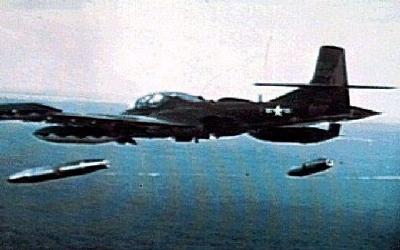
Dropping Napalm. NAPALM.
Napalm or "fire bombs" are cylindrical, thin skinned aluminum tanks filled with various types of incedigel mixes. It is one of the most versatile tactical fighter weapons since pilots have considerable leeway in delivery accuracy and need only insure that ordnance impacts are short of the target by about one-half the effective pattern length. Even with a near miss, napalm can be highly destructive to personnel, and to equipment that is vulnerable to its effects. Fuzing consists of an impact fuze which ejects white phosphorus (WP) into the splash pattern. Napalm cannisters have fuze igniters installed in both nose and tail. Napalm is available as 500# and 750# munitions and can be delivered in the unfinned or finned configuration. The napalm flame pattern may be as large as 40x180 meters when delivered from low altitude at high speed. Best delivery is parallel to friendly troop positions.
a. Unfinned Napalm.
(1) General. Unfinned napalm bombs are unstable after release with random tumbling until impact. Impact ruptures the napalm can and spreads the napalm mix over an area forward of the impact point.
(2) Delivery. Unfinned napalm is usually delivered from low (0° - 20°) dive angles, low (50' - 800' AGL) altitudes and high (up to 500 knots, depending on aircraft) speed. Delivery can be conducted under ceilings as low as 800' – 1000' AGL with visibilities of 2 to 4 miles (The lower visibility is for slower aircraft). A-1 aircraft may deliver unfinned napalm in dives up to 45°.
b. Finned Napalm.
(1) General. Finned napalm has predictable ballistics which allow accurate delivery from high dive angles and altitudes. As dive angle or release altitude increases, however, the pattern size decreases and effectiveness is reduced.
(2) Delivery. Finned napalm is better suited for penetration of jungle canopies than unfinned napalm when delivered from dive angles of 20° or greater.
c. Delivery Accuracy.
The following table provides an estimate of combat delivery accuracy for napalm:
| Aircraft | Angle | Knots True Airspeed | Above Ground Level (Feet) | REP-Feet | DEP-Feet | | All | 0° | 450 | 100 | 100 | 20 |
d. Napalm Mixtures:
(1) Napalm. Napalm is a mixture of gasoline and M-4 thickener which tends to adhere to a target. Napalm burns for approximately 15 to 30 seconds at temperatures up to 1400° F and is effective against combustible or partially combustible targets and those targets which can be damaged by intense heat. This category of targets includes: parked aircraft, vehicles, ammunition and supply depots in the open, POL dumps, stationary armored vehicles and tanks, unhardened radar and communication facilities, exposed personnel, and warehouses of combustible construction.
(2) Napalm B. Napalm B, the newest incendigel mix, provides increased burning times and improved terminal effects. It is a mixture of polystyrene, benzene, and low octane gasoline. Napalm B is more viscous than other incedigel mixes which improves its adherence to target surfaces and reduces the "fire ball" effect. It burns for up to 10 minutes.
ROCKETS
a. General. The 2.75" folding fin aerial rocket (FFAR) was originally designed for air-to-air use, but is now used as an air-to-ground antipersonnel and materiel munition. Several different warheads can be installed. The rockets can be carried in two different launchers. The LAU-59 is a reusable launcher that carries 7 rockets. The LAU-3 carries 19 rockets and is jettisoned after firing.
b. Warheads.
(1) MK 1 (HE). The high explosive head produces blast and fragmentation. Detonation of the MK 1 head ejects 750 fragments with an average velocity of 3780 feet per second. These fragments are capable of penetrating 1/8" of mild steel at a distance of 30 feet from the point of detonation. When firing against targets on soft ground, most of the rocket fragmentation will probably be absorbed since warhead fuzing will allow the head to penetrate the ground prior to detonation. Lethal radius for a single rocket against men standing is 20' and for men prone is 12'.
(2) MK 5 (HEAT). The high-explosive antitank warhead, with its specially designed shaped charge, is capable of penetrating up to six inches of armor with an impact normal (90°) to the surface. The weapon will have a negligible effect unless a direct hit is obtained.
(3) M151 (HEAP). This high-explosive antipersonnel warhead has a "super-quick" fuze which causes detonation prior to penetration of the head into soil or sand. Lethal radius for a single rocket against men standing is 39 feet and for men prone is 26 feet.
(4) WDU-4A/A (Flechette). This antipersonnel warhead contains 2400 twenty grain flechettes which are expelled from the warhead at motor burn out. The flechettes resemble small darts and inflict casualties by virtue of their high energy level at impact. Foliage degrades the effectiveness of flechettes and they should not be used under jungle canopy. Flechettes have very limited capabilities against materiel or shielded personnel. The following table shows pattern sizes for various delivery parameters:
| Dive Angle | Altitude AGL (Feet) | Pattern Width and Length (Feet)
10° | 800 | 300 x 1200 | | 20° | 1400 | 300 x 1200 | | 30° | 2200 | 250 x 250 | | 30° | 3000 | 400 x 500 | | 45° | 3600 | 250 x 300 | | 45° | 5000 | 400 x 500 |
(5) M156WP. The warhead contains 2.0 lbs of white phosphorous (WP) and 2.0 ounces of B-4 high explosive. Upon detonation, the high explosive ruptures the warhead and dispenses the WP to generate a white cloud of smoke.
c. Delivery Accuracy. All fighter aircraft deliver rockets from a dive, with angles varying from 10° to 45°. The following table provides an estimate of combat delivery accuracies for rockets:
| Type | Dive Angle | Knots True Airspeed | Alt AGL | REP-Feet | DEP-Feet | CEP-Feet | | HEAT | 30° | 500 | 2400 | 105 | 40 | 130 | | HEAP | 30° | 500 | 2400 | 10540 | 130 | | WDU-4A/A | 30° | 500 | 2400 | 105 40 | 130 |
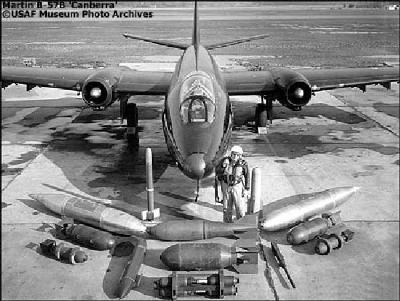
B-57 munitions. (USAF Museum)DISPENSER MUNITIONS.
a. General.
There is a large group of munitions designated as cluster bomb units (CBU) which consist of a dispenser (SUU-XX) matched with a bomblet (BLU-XX). The complete round is designated a CBU. For example, CBU-24B/B = SUU-30B/B + BLU-26/A. These munitions produce a wide variety of effects, to include antimateriel, antipersonnel, area denial, and chemical riot control. The dispenser has the capability to distribute its payload widely, thereby spreading the effectiveness of the munition over a large area instead of concentrating the destructive energy in one small area which can result in near misses or over-kills.
b. Delivery.
(1) CBU-24/49. The CBU-24/49 consists of a clam shell dispenser which opens into two hemispherical halves, allowing the bombs to fall free and disperse in a somewhat elliptical pattern. CBU-24/49's are normally delivered from a dive (25° - 45°; 5000' - 8000') at high speeds (up to 550k depending on aircraft) but may be delivered from level flight or dive toss. A CBU-24/49 pattern size is about 530x530 meters for a single dispenser but may be considerably larger if premature opening occurs. The pattern for a single dispenser normally has an area within the pattern itself that is not covered by bomblets. This is known as the "donut" effect and the size of the hole is dependent upon dispenser opening altitude. This munition is not intended for use near friendly forces.
(2) Rearward and Downward Dispensing CBU's. These CBU's comprise a major portion of our CBU inventory (i.e., CBU14, 25, 33, 42, 46). They are normally delivered from level flight at relatively low (50'-500') altitudes and high (up to 600 knots depending on aircraft) speeds because of dispenser and optical sighting system limitations, and because this mode of delivery produces the best dispersion patterns. A-1's however, may deliver these CBU's from a dive. The resulting patterns are normally long and narrow. The length of the patterns will depend on the type of dispenser used, number of bomb button depressions during the attack, number of tubes released per depression and release airspeed. A normal CBU pattern is about 30x400 meters. Delivery can be conducted under 800'-1000' ceilings and with visibilities of 2-4 miles. The delivery should be parallel to friendly formations, with positions well marked. Delivery of CBU-25's and CBU-46's should be with the friendly forces on the right side of the aircraft to compensate for the left drift of the bomblets. Caution must be exercised in the vicinity of friendly troops near the ends of the CBU pattern, since delayed releases may extend patterns beyond desired areas. Additionally, aircraft should never fly over friendly positions once they have initiated CBU passes because some bomblets may dribble from the dispensers. The following table provides an estimate of combat delivery accuracies for CBU munitions.
| Munition | Aircraft Angle | KTAS Altitude AGL | REP-Feet | DEP-Feet | CEP-Feet | | CBU-24/49 | All | 45° | 500 | 4500 | 175 | 130 | 265 | | Rearward | All | 0° | 450 | 100 | 100 | | 40 120
Downward | All | 0° | 450 | 300 | 250 | 70 | 280 |
20mm AMMUNITION.
a. General. 20mm ammunition may consist of high explosive incendiary (HEI) or armor-Piercing incendiary (API). The HEI projectile causes damage by blast, fragmentation and incendiary effects. At short range, HEI is effective against targets, such as vehicles, which can be penetrated due to the high striking velocity, and then destroyed by internal functioning of the explosive round. Against light vehicles, HEI is about twice as effective as API. HEI fragmentation makes it very effective against personnel. The API projectile Is designed for use against armored targets, and functions with a combined penetration and incendiary effect. Against hard targets such as locomotives and armored vehicles, HEI blast is absorbed by the target surface and the deeper penetrating API round is preferred. API produces no lethal fragments and is not effective against personnel for other than a direct hit.b. Delivery. The following table provides estimated delivery accuracies for 20mm.
| Aircraft | Dive Angle | KTAS | Slant range (Feet) | CEP-Feet | | All | 5-15° | 400-500 | 2000 | 28 | | All | 5-15° | 400-500 | 3000 | 42 |
7.62mm AMMUNITION.
7.62mm ammunition may consist of ball or tracer rounds. The ball round is intended for use against personnel or materiel targets.
WEAPONS MINIMUM SAFE DISTANCES.
Minimum safe distances from various. weapons should be provided to both the FAC directing the airstrike and the ground commander requesting an airstrike close to his forces. It is not intended here to present all the factors affecting weapons delivery accuracy; however, consideration of expected delivery accuracy, weapon lethal radius, and target identification error should provide a minimum safe distance for initial munition delivery. These distances can be reduced. but the ground commander must make that decision based upon his estimate of the immediate situation. The following table shows the minimum safe distances from unprotected troops for delivery of ordnance. The distances listed represent the range at which a fragment from the particular munition will not penetrate the skin of an individual standing in an open field. The figures are based on a probability of kill of zero (Pk=0). They do not take into account aiming errors, pattern length, or pattern dispersions. The distances are from the actual point of impact. For the BLU-3/B and the BLU-26/59/B, the figure represents the actual point of impact of a single bomblet from the CBU dispenser. The safe distance for rockets is measured from the actual point of impact for a single 2.75" FFAR. The table also shows the minimum safe distances from protected troops that various types of ordnance may be delivered. The distances offer reasonable casualty-free risk for troops in armored vehicles, bunkers, trenches, or fox holes who are shielded from the point of detonation. They are based on 150% expected delivery accuracy, 200% lethal radius, 60 meters target identification error for high angle delivery, and 30 meters for low angle delivery.
| Minimum Safe Distances (Meters) Weapon Type | Protected Troops | Unprotected Troops | | M118 (3000#) | 250 | 1174 | | MK 84 (2000#) | 250 | 720 | | M117 (750#) low drag | 215 | 830 | | M117 (750#) high drag | 160 | 830 | | MK 82 (500#) low drag | 225 | 700 | | MK 82 (500#) high drag | 170 | 700 | | MK 81 (250#) | 215 | 620 | | Napalm | 115 | --- | | CBU (except CBU 24/49) | 110 | 250 | | CBU 24/49 | 1000 | 1000 | | Rockets | 215 | 215 | | Cannons and gun (20mm, 7.62mm) | 45 | --- |
Close Air Support According to the WPAFB Museum: A-X
Close Air Support Project, "During the Vietnam War, it became clear that the USAF was in need of a dedicated CAS aircraft. Many aircraft were used successfully in the CAS/ground attack role in Vietnam, but all had limitations. For example, the Douglas A-1 and LTV A-7 (Corsair II) were used effectively; however, the A-1 were getting old and the A-7 didn't have the maneuverability to operate at low altitudes in confined areas. A number of fighters (and fighter-bombers) were used also. The McDonnell Douglas F-4, North American F-100, Republic F-105 and General Dynamics F-111 were all moderately effective ground attack aircraft, but like the A-7, lacked the maneuverability to operate in very close proximity to friendly troops under enemy attack. A number of cargo aircraft were modified for use as side firing gunships. The Douglas AC-47, Fairchild AC-119 and Lockheed AC-130 were used very effectively in the interdiction and ground attack roles, particularly at night. Finally, the USAF used some modified trainer aircraft in the counter insurgency and ground attack roles, two examples are the North American T-28 and Cessna A-37 (T-37)." (NOTE: The A-1E Skyraiders were Korean War vintage Navy AD-5s taken out of mothballs and redesignated for USAF use as a ground attack workhorse. The A-7D Corsair II was strictly ground attack.)
The following is excerpted from A-37 Association:
The Dragonfly pulled alert duty at Bien Hoa Air Base (about 30 miles from Saigon) and from there was able to reach into most of the southern areas of South Viet Nam. It flew both day and night missions in visual meteorological conditions.
The moderate speed of the aircraft gave it much greater accuracy than other fighters of that time. The speed caused experienced enemy gunners to overlead the aircraft and shoot in front of it. The A-37's small size also reduced its vulnerability and increased survivability. It did not go through the war without losses, but its survivability surprised many. (SITE NOTE: During their operational stay in Vietnam the USAF A-37B units lost 16 aircraft to enemy fire of which 14 were destroyed on the ground during rocket and mortar attacks.)
One of the few aircraft made with an unusual ability, it could carry its own weight. This meant a combat configuration of 4 Mk82 500 lb bombs, 2 pods of rockets, and a load of gun ammo. This was equivalent to the load carried by the F-100 Super Saber (not counting the 20MM gun). (SITE NOTE: The empty weight of the A-37B was 6,254 lb, while its full-up combat takeoff weight was 14,000 lb.) In close range missions, the A-37 could actually get bombs on target faster than the F-100 since the "Hun" had to burn off some fuel before it could go to work. It could also hit the target, climb up to pattern altitude and return to make another pass quicker than any other fighter. On the troop list of the 25th Infantry Division in 1970, the 8th Attack Squadron is listed under "US Air Force elements with habitual association". An article Close Air Support describes the FACs task in CAS. It gives some insight into what the A-37 pilot's task was in a CAS mission. It stated, "Close Air Support (or CAS) missions were probably the most demanding flown by FACs in Southeast Asia. Working a troops in contact (TIC) situation required the airborne FAC to coordinate with the ground commander, strike aircraft and command and control agencies on three different radios (UHF for fighters, VHF for command and control and FM for the ground troops). While doing this he had to maintain visual contact with the friendly forces and attacking aircraft, locate and mark targets and avoid hostile ground fire.
It continued, "At times there were mismatches between the tactical situation and the ordnance available on the fighter. The Rules of Engagement were always there to "guide" you, but when the chips were down common sense and your gut always were the best guides. The knowledge that you were directing the use of deadly munitions in close proximity to friendly forces whose lives depended on you was a constant motivator. Throw in mountainous terrain, smoke, bad weather and darkness, and a normally demanding mission would become even more exciting. No two were ever the same." In their actions in close air support, the pilots exhibited acts of bravery appreciated by the ground forces. For example, in the May 1972 attack on An Loc, Lieutenant Colonel Gordon Weed, the 8th SOS squadron commander, made two passes at rooftop level through heavy enemy flak to destroy a T-54 tank that was threatening the 5th ARVN Division command post (CP).
In providing CAS to ground troops the pilots were to be mindful of the "Rules of Engagement." Unfortunately, the "Rules of Engagement" became a political affair and was an example of the naivete of the Vietnam War where the "Rules of Engagement" was not followed by the enemy. In the end the "Rules of Engagement" proved to be more of a handicap than a moral determinant of action. According to the Crimes of War Project, "But despite the GIs' confusion, international law enjoins armies to avoid targeting any but military objectives and assures protection to civilians, in almost any circumstance. Free fire zones as defined by Department of Defense doctrine and the rules of engagement are a severe violation of the laws of war for two reasons. First, they violate the rule against direct attack of civilians by presuming that after civilians are warned to vacate a zone, then anyone still present may lawfully be attacked. The rule prohibiting direct attacks on civilians provides no basis for a party to a conflict to shift the burden by declaring a whole zone to be "civilian free." And second, they violate the rule against indiscriminate attack by presuming without justification in the law that warning civilians to leave eliminates the legal requirements to discriminate in targeting its weapons."
It went on, "Faced with this negative coverage and with severe difficulty in enforcing international laws limiting the imposition of free fire zones, as well as other elements of the rules of engagement, the Pentagon over time added more directives to its pocket cards: a village could not be bombed without warning even if American troops had received fire from within it; a village known to be Communist could be attacked only if its inhabitants were warned in advance; only once civilians had been removed could a village be declared a free fire zone and shelled at will." The bottom line was that the Rules of War was completely ineffective in Vietnam.
The article continued, "Toward the end of the 1960s, the term free fire zone itself was dropped from the U.S. military lexicon in no small part because that doctrine embraced actions that the United States today would regard as illegal. Subsequent U.S. military manuals and rules of engagement, whether for ground, air, or naval forces, tend to track quite closely with the central principle of international humanitarian law on civilian immunity and the prohibition on the targeting of civilians." In the early 1970s, the two primary aircraft used for close air support were the F-100 and A-37s in the early 70s. A number of cargo aircraft were modified for use as side firing gunships. The Douglas AC-47, Fairchild AC-119 and Lockheed AC-130 were used very effectively in the interdiction and ground attack roles, particularly at night. Also used were the aging A-1E, T-28, and LTV A-7. The A-1E's were getting old and the Navy A-7 Corsair II didn't have the maneuverability to operate at low altitudes in confined areas. The F-4, F-100, F-105 and F-111 were all moderately effective ground attack aircraft, but also lacked the maneuverability to operate in very close proximity to friendly troops under enemy attack. These fighter aircraft were primarily committed to North Vietnam leaving the South Vietnam CAS roles to the A-37 and F-100s.
The A-37s companion in the CAS role was the F-100. The reason the F-100D was relegated to South Vietnam close air support roles was that as a tactical bomber, the F-100D was inferior to the F-105 and the F-4. The F-105 could carry a larger bombload further and faster. In addition, the F-105 was built to take the extreme structural loads of low-level, high-speed flight, whereas the F-100 was not. Consequently, from mid-1965 onward, F-100D fighter bombers generally operated only in the South, leaving the North for the F-4 and the F-105.
In a typical mission, the F-100D would approach the target down on the deck at about 500 mph and pull up at a steady 4Gs acceleration. Partway into what would be a half loop, the bomb would be automatically released by the computer. The plane would then complete the half-loop and undergo a half-roll and head away from the target. The F-100D would then go to full afterburner in order to get as far away as possible from the bomb when it exploded. Its CAS missions the F- 100Ds were armed with two CBU-24 bombs which, on opening, released a large number of anti-personnel devices, and two 750lb (340kg) napalm bombs. Once they had dropped their load, the Super Sabres proceeded to spray the zone under attack with their four 20mm cannons to complete the 'cleaning up' work. Because of their adaptability and, even more, the lack of a real alternative, numerous F-100 Wings were used in Vietnam.
Unfortunately, in 1967 a catastrophic wing failure caused by a series of wing cracks that had been produced by metal fatigue, temporarily restricted to a 4-G maneuver limit until all the planes could be fixed by carrying out a complete modification of the wing structural box. These modifications were not completed until 1969.
However, the A-37B's advantage was it being able to drop its ordnance without having to burn off fuel and being able to quick turn within 90 minutes for another combat mission. In addition, its moderate speed increased its accuracy in dropped ordnance. According to Dennis Selig: A Tribute to The A-37 "Smallest Fighter, Fastest Gun" Combat Record, "The moderate speed of the aircraft gave it much greater accuracy than other fighters of that time. The speed caused experienced enemy gunners to overlead the aircraft and shoot in front of it. The A-37's small size also reduced its vulnerability and increased survivability. It did not go through the war without losses, but its survivability surprised many.
From T-37 (of which 1,268 models of three basic versions were built between 1955 and 1977), an efficient attack plane was derived in 1963, the A-37, which was also successfully exported. The prototype flew on October 22, 1963 and the first 39 A-37As were produced by direct conversion of other T-37Bs. The definitive version was the A-37B, which first appeared in September 1967 and of which 577 were built with the majority of these going to the USAF.
One of the few aircraft designed from the start for tactical support, the A-37 arrived in Vietnam toward the end of the 1960s and was mainly used in support of helicopter operations. Capable of mounting a wide range of weapons, it proved highly adaptable to diverse operational needs. Particularly effective were its low-level napalm bomb attacks. A fairly limited number of machines, under the colors of both the USAF and the VNAF were used in action.
One of the few aircraft made with an unusual ability, it could carry its own weight. This meant a combat configuration of 4 Mk82 500 lb bombs, 2 pods of rockets, and a load of gun ammo. This was equivalent to the load carried by the F-100 Super Saber (not counting the 20MM gun). In close range missions, the A-37 could actually get bombs on target faster than the F-100 since the "Hun" had to burn off some fuel before it could go to work. It could also hit the target, climb up to pattern altitude and return to make another pass quicker than any other fighter." The A-37s prided itself on being able to provide the "closest air support" -- "smallest fighter; fastest gun" -- as it didn't have to burn off fuel to launch its attack.
However, there were differences in types of munition payloads that were carried between the F-100 and A-37B as illustrated during the 3-day battle of the 3rd Brigade, 25th Infantry Division at Renegade Woods between 2 - 6 April 1970. NVA were thought to be infiltrating into this area to set up a base camp. When the Ranger elements entered the area, they came under heavy fire. More elements were brought in and a major battle ensued in a bunker complex with the NVA. Close air support was called in from the USAF. The 8th Attack Squadron of Phan Rang and 3rd TFW (604th SOS/90th SOS) of Bien Hoa were involved along with F-100s from the 3rd TFW of Bien Hoa. (Source: Air War College: 25th ID After Action Report: USAF Air Strikes.)
Both the F-100 and A-37 carried loads of 4,500 lbs of High Explosives and 4,500 lbs of napalm. However, the F-100 carried the "daisy cutter" bombs (8,500 lb HE) due to aircraft clearance problems as well as all the high drag HE bombs to give the F-100 time to depart the area. Remember that in a typical mission, the F-100D would approach the target down on the deck at about 500 mph and pull up at a steady 4Gs acceleration. The F-100D would then go to full afterburner in order to get as far away as possible from the bomb when it exploded. However, in 1967, the F-100 developed structural problems that limited its manuevers to 4G loads max. (See Appendix: Air Munitions Data for more information on napalm and high drag bombs.)
1 2/1315 2 A-37 8th Attack Sq (Phan Rang) 4 500 lbd HE; 4 500 lbd napalm (SITE NOTE: We consider this an error as the 8th AS was at Bien Hoa.)
2 2/1330 2 F-100 3rd TAC F.W. (Bien Hoa) 4 750 lbd napalm
3 2/1345 2 F-100 35th TAC F.W. (Phan Rang) 4 500 lbd HE (high drag); 4 750 lbd napalm
4 2/1700 2 F-100 31st TAC F.W. (Tuy Hoa) 8 500 lbd HE;
5 2/1810-1815 4 F-100 3rd TAC F.W. (Bien Hoa) 8 500 lbd HE; 8 500 lbd HE (.025 sec. Delay)
6 2/1900 2 F-100 35th TAC F.W. (Phan Rang) 4 500 lbd napalm; 4 500 lbd HE (high drag)
73/1030 2 A-37 3rd TAC F.W. (Bien Hoa) 8 500 lbd HE
8 3/1100 2 F-100 35th TAC F.W. (Phan Rang) 4 500 lbd HE; 4 500 lbd napalm
93/1300 2 A-37 3rd TAC F.W. (Bien Hoa) 4 500 lbd HE; 4 500 lbd napalm
10 3/1300 2 F-100 3rd TAC F.W. (Bien Hoa) 8 500 lbd napalm
114/1000 2 A-37 3rd TAC F.W. (Bien Hoa) 4 500 lbd HE; 4 500 lbd napalm
12 4/1300 2 F-100 3rd TAC F.W. (Bien Hoa) 4 500 lbd HE (high drag);4 500 lbd napalm
13 5/1000 2 A-37 3rd TAC F.W. (Bien Hoa) (N) 4 500 lbd HE (1 dud) (S) 4 500 lbd napalm
14 5/1200 2 A-37 3rd TAC F.W. (Bien Hoa) (N) 4 500 lbd HE; 2 500 lbd napalm; (S) 2 500 lbd napalm
155/1630 2 A-37 3rd TAC F.W. (Bien Hoa) 4 500 lbd HE; 4 500 lbd napalm
16 6/0900 2 F-100 35th TAC F.W. (Phan Rang) 8 500 lbd HE (Daisy Cutter)
17 6/0930 2 F-100 31st TAC F.W. (Tuy Hoa) 8 500 lbd HE (Daisy Cutter)
18 6/1300 2 A-37 3rd TAC F.W. (Bien Hoa) 4 500 lbd HE; 4 500 lbd napalm
(Source: Air War College: 25th ID After Action Report) Another difference was the airloads on some munitions. The A-37B flew at airspeeds lower than their high-speed cousins so could carry CBU-19 gas bombs. According to Defense Link: Operation Tailwind, on the use prior to 1969 of the CBU-19 gas bomb designed for helicopters but used mostly by the A-1s in the Air Force. The use of persistent tear gas was to deny the use of an area to the enemy in order to facilitate extractions. From 1970-1972, the Air Force principally used the CBU-30 tear gas cluster bomb. Both propeller aircraft, A-1s, and jet aircraft, especially F-4s and F-100s, employed the CBU-30, which contained 66 pounds of CS tear gas, while the CBU-19 contained only 14 pounds.The CBU-19 chemical cluster was a 130-lb. modified U.S. Army dispenser intended for use on helicopters and consisted of two subclusters fitted to a strongback. Each cluster contained 528 agent-filled canisters; each canister contained an incapacitating chemical, called CS, and a pyrotechnic fuze. Upon ejection from the aircraft, the fuze ignited the CS, disseminating the CS for four to six seconds. This required delivery below 600 feet AGL [above ground level] to insure that the chemical reached the ground. Also, as the cluster had originally been designed for use on helicopters, delivery was restricted to use on the A-1 and A-37 because the cluster could not withstand the airloads encountered on faster aircraft. The CBU-30 consisted of the SUU-13 downward ejection dispenser and 1,280 BLU-39/B23 submunitions, each filled with CS. Upon ejection, a pyrotechnic fuze in each submunition ignited, disseminating the agent into the air. Delivery was restricted to below 600 feet AGL to insure ground coverage. Upon contact with the ground, the submunitions skittered about, disseminating the CS even further. The CBU-30 was compatible with both low and high speed aircraft.
An account with an A-1 Skyraider using tear gas shows its effectiveness. On 15 February 1969, A-1 Skyraiders flew a SAR mission near the Laos-South Vietnam border and dropped CBU-19s. It continued: "Braving the constant hail of antiaircraft fire, the Skyraiders made the required mile-long run at 300 feet and 220 knots to hit all their targets--enemy antiaircraft gun positions. While the gunners choked, coughed, cried, and retched uncontrollably, a Jolly Green [helicopter] with its crew wearing gas masks swooped in and saved the pilot."
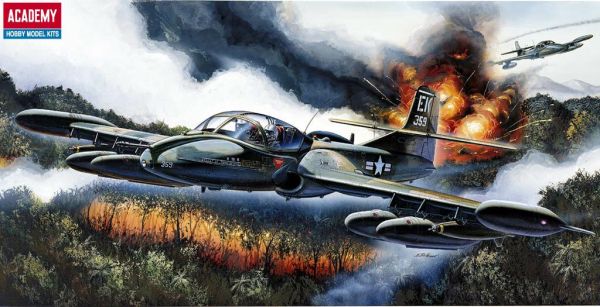
A-37B SuperTweet Model (Academy Hobby Models)
NOTE: "EK" Tail Designator (96359/EK, 8th SOS, 14th SOW, USAF, Bien Hoa AB, Vietnam, 1970) We believe that 8th SOS/14th SOW is in error and should be 8th SOS/35th TFW.A-37 Call SignsThe call signs for the A-37s Strike Aircraft at Bien Hoa is listed in the 619th TCS Training Manual (about 1969-70) at 505th Tactical Control Group. The aircraft at Bien Hoa are listed below:| Call Sign | Type Aircraft | Base | | 1. Hawk | F-100 | Bien Hoa | | 2. Hawk | A-37 | Bien Hoa | | 3. Ramrod | F-100 | Bien Hoa | | 4. Dice | A-37 | Bien Hoa | | 5. Rap | A-37 | Bien Hoa | | 6. Falcon | F-5 (VNAF) | Bien Hoa | | 7. Dog | A-37 | Bien Hoa | |
"Rap" was the 604th ACS; "Dice" was the 90th AS; and ""Dog" was the 8th AS. However, the entry for "2. Hawk" is confusing as no other A-37 existed at Bien Hoa at the time -- and "Hawk" was actually an F-100 call sign. The only explanation was that this was part of the planning process for the creation of the 8th SOS, 35th TFW.
Sources from Air Force Historical Research Agency (AFHRA) B-57: 8th TBS & 13th TBS (See A-37 Source for 35th TFW)
(SOURCE: AFHRA: 8th SOS: ASSIGNMENTS: 405th Fighter Wing, 18 Nov 1964 (attached to 33d Tactical Group, 18–28 Jun 1965; 2d Air Division, 28 Jun–7 Jul 1965; 6252d Tactical Fighter Wing, 8 Jul–15 Aug 1965, 16 Oct–16 Dec 1965 and 15 Feb–7 Apr 1966; 35th Tactical Fighter Wing, 8–18 Apr 1966, 15 Jun–15 Aug 1966, 12 Oct–12 Dec 1966, 11 Feb–12 Apr 1967, 7 Jun–2 Aug 1967, and 26 Sep–21 Nov 1967);
STATIONS: 17 Nov 1960 (deployed at Clark AB, Philippines, 9–23 Apr 1964); Clark AB, Philippines, 24 Apr 1964 (deployed at Bien Hoa AB, South Vietnam, 5 Aug–3 Nov 1964; Tan Son Nhut AB, South Vietnam, 18–28 Jun 1965; Da Nang AB, South Vietnam, 28 Jun–15 Aug 1965, 16 Oct–16 Dec 1965, 15 Feb–18 Apr 1966, and 15 Jun–15 Aug 1966; Phan Rang AB, South Vietnam, 12 Oct–12 Dec 1966, 11 Feb–12 Apr 1967, 7 Jun–2 Aug 1967, and 26 Sep–22 Nov 1967); Phan Rang AB, South Vietnam, 17 Jan 1968; Bien Hoa AB, South Vietnam, 15 Nov 1969; Clark AB, Philippines, 1 Oct 1972–1 Mar 1974;
(SOURCE: AFHRA: 13 BS: ASSIGNMENTS: 3 Bombardment Wing, 25 Oct 1957 (attached to 41 Air Division, 1 Sep 1963-7 Jan 1964); 41 Air Division, 8 Jan 1964; Thirteenth Air Force, c. 10 Apr 1964 (attached to 405 Fighter Wing, 10 Apr- 17 Nov 1964); 405 Fighter Wing, 18 Nov 1964-15 Jan 1968 (attached to: 2 Air Division, 5 Aug-3 Nov 1964 and 17 Feb-21 Jun 1965; 6252 Tactical Fighter Wing, 16 Aug-16 Oct 1965 and 16 Dec 1965-17 Feb 1966; 35 Tactical Fighter Wing, 17 Apr-17 Jun 1966, 14 Aug-13 Oct 1966, 12 Dec 1966-11 Feb 1967, 11 Apr-8 Jun 1967, 1 Aug-26 Sep 1967, and 21 Nov 1967-15 Jan 1968).
STATIONS: Clark AB, Philippines, 10 Apr 1964-15 Jan 1968 (deployed at Bien Hoa AB, South Vietnam, 5 Aug-3 Nov 1964, 17 Feb-16 May 1965; Tan Son Nhut AB, South Vietnam, 16 May-21 Jun 1965; Da Nang AB, South Vietnam, 16 Aug- 16 Oct 1965, 16 Dec 1965-17 Feb 1966, 17 Apr- 17 Jun 1966 [operated from Bien Hoa AB, South Vietnam, 15-22 May 1966], 14 Aug-9 Oct 1966; Phan Rang AB, South Vietnam, 10- 13 Oct 1966, 12 Dec 1966-11 Feb 1967, 11 Apr-8 Jun 1967, 1 Aug- 26 Sep 1967, 21 Nov 1967-15 Jan 1968).
8th SOS, 90th SOS and 604th ACS -- 3rd TFW, 14th SOS, 35th TFW
SOURCE: AFHRA: 90th FS LINEAGE: 90th Tactical Fighter Squadron on 8 Jun 1964; 90th Attack Squadron on 12 Dec 1969; 90th Special Operations Squadron on 31 Oct 1970; 90th Tactical Fighter Squadron on 8 Jul 1973; 90th Fighter Squadron on 26 Sep 1991.ASSIGNMENTS: 3d Tactical Fighter Wing, c. 8 Feb 1966; 14th Special Operations Wing, 31 Oct 1970; 483d Tactical Airlift Wing, 1 Sep 1971; 18th Tactical Fighter Wing, 15 Apr 1972; 405th Fighter Wing, 15 Dec 1972; 3d Tactical Fighter Wing, 16 Sep 1974; STATIONS: Bien Hoa AB, South Vietnam, 12 Feb 1966 (deployed at Phan Rang AB, South Vietnam, 9–14 Apr 1967); Nha Trang AB, South Vietnam, 31 Oct 1970; Kadena AB, Okinawa (later, Japan), 15 Apr 1972; Clark AB, Philippines, 15 Dec 1972;
SOURCE: AFHRA: 8th SOS LINEAGE: 8th Bombardment Squadron, Tactical, on 1 Oct 1955; 8th Attack Squadron on 18 Nov 1969; 8th Special Operations Squadron on 30 Sep 1970; 8th Fighter Squadron on 1 Jul 1973; 8th Special Operations Squadron on 1 Mar 1974ASSIGNMENTS: 35th Tactical Fighter Wing, 15 Jan 1968 (attached to 405th Fighter Wing, 15–17 Jan 1968); 3d Tactical Fighter Wing, 15 Nov 1969; 35th Tactical Fighter Wing, 30 Sep 1970 (attached to 315th Tactical Airlift Wing, 16–30 Jul 1971); 315th Tactical Airlift Wing, 31 Jul 1971; 377th Air Base Group (later, 377th Air Base Wing), 15 Jan 1972 (attached to 6251st Air Base Squadron, 1–14 Sep 1972; Detachment 2, 377th Air Base Wing, 15–30 Sep 1972); 405th Fighter Wing, 1 Oct 1972; 1st Special Operations (later, 834th Tactical Composite; 1st Special Operations) Wing, 1 Jul 1974; 1st Special Operations (later 16th Operations) Group, 22 Sep 1992–.STATIONS: Phan Rang AB, South Vietnam, 17 Jan 1968; Bien Hoa AB, South Vietnam, 15 Nov 1969; Clark AB, Philippines, 1 Oct 1972–1 Mar 1974;
SOURCE: AFHRA: 3rd WingASSIGNMENTS: Seventh Air Force, 1 Apr 1966; Fifth Air Force, 15 Mar 1971; 314th Air Division, 15 Mar 1971; Thirteenth Air Force, 16 Sep 1974; Eleventh Air Force, 19 Dec 1991–.
SQUADRONS: 1st Air Commando (later, 1st Special Operations): attached 21 Nov 1965–8 Mar 1966; assigned 15 Jan 1981–1 Mar 1983. 1st Test: 16 Sep 1974–1 Jan 1980 (detached 15 Mar 1979–1 Jan 1980). 3d Tactical Electronic Warfare Training: 15 May 1976–1 Jan 1980. 3d Tactical Fighter: 15 Dec 1975–19 Dec 1991 (detached 15–16 Dec 1975). 7th Airborne Command and Control: 31 Mar–14 Aug 1975 (detached). 8th Bombardment (later, 8th Attack): attached 13 Aug 1956–24 Oct 1957, assigned 25 Oct 1957–8 Jan 1964 (detached 1 Sep 1963–8 Jan 1964); assigned 15 Nov 1969–30 Sep 1970. 8th Tactical Reconnaissance: attached 18 Apr 1949–1 Apr 1950. 10th Fighter: 8 Apr 1966–17 Apr 1967. 13th Bombardment: attached 13 Aug 1956–24 Oct 1957, assigned 25 Oct 1957–8 Jan 1964 (detached 1 Sep 1963– 8 Jan 1964). 20th Operations: 16 Sep 1974–31 Mar 1975. 25th Tactical Fighter: 18–19 Dec 1975. 26th Tactical Fighter (later, 26th Tactical Fighter Training; 26th Tactical Fighter Training Aggressor; 26th Aggressor): 16 Sep 1974–1 Oct 1988. 35th Tactical Fighter: 15 Mar 1971–16 Sep 1974 (detached 1 Apr–12 Oct 1972). 36th Tactical Fighter: 15 May 1971–16 Sep 1974. 40th Fighter-Interceptor: attached 1 Dec 1961–31 May 1962. 44th Tactical Fighter: attached 3 Apr–2 Jun 1972 and 28 Jul–8 Sep 1972. 67th Tactical Fighter: attached 2 Jun–28 Jul 1972 and 8 Sep–16 Oct 1972. 68th Tactical Fighter: 16 Sep 1974–30 Sep 1975. 80th Tactical Fighter: 15 Mar 1971–16 Sep 1974. 90th Bombardment (later, 90th Tactical Fighter; 90th Attack; 90th Tactical Fighter): attached 13 Aug 1956–24 Oct 1957, assigned 25 Oct 1957–8 Jan 1964 (detached 1 Sep 1963–8 Jan 1964); assigned 9 Jun 1964–19 Nov 1965 (detached 3 Feb–10 May 1965 and 3 Aug–19 Nov 1965); assigned 3 Feb 1966–31 Oct 1970; assigned 16 Sep 1974–29 May 1991. 307th Tactical Fighter: attached 21 Nov–6 Dec 1965. 308th Tactical Fighter: 2 Dec 1965–25 Dec 1966 (detached 15 Nov–25 Dec 1966). 310th Attack:15–30 Nov 1969. 311th Attack: 15 Nov–15 Dec 1969. 416th Tactical Fighter: 16 Jun 1964–8 Nov 1965 (detached 14 Mar–21 Jul 1965); 16 Nov 1965– 15 Apr 1967 (detached 16 Nov 1965–15 Jun 1966). 421st Air Refueling: attached 21 Nov 1960–1 Jun 1962. 429th Tactical Fighter: attached c. 21 Nov–14 Dec 1965. 510th Tactical Fighter: 16 Mar 1964–15 Nov 1969 (detached 5 May–c. 20 Aug 1965). 531st Tactical Fighter: 16 Jun 1964– 19 Nov 1965 (detached 2 Nov 1964–18 Mar 1965); 7 Dec 1965–31 Jul 1970. 602d Fighter: attached 21 Nov 1965–8 Mar 1966. 604th Air Commando (later, 604th Special Operations): attached 15 Nov 1967–1 Mar 1970, assigned 1 Mar–30 Sep 1970. 731st Bombardment: attached 1 Dec 1950– 25 Jun 1951. 6091st Reconnaissance: attached 21 Nov 1960–c. 5 Jun 1962. STATIONS: England AFB, LA, 8 Jan 1964–Nov 1965; Bien Hoa AB, South Vietnam, 8 Nov 1965; Kunsan AB, South Korea, 15 Mar 1971; Clark AB, Philippines, 16 Sep 1974–19 Dec 1991; Elmendorf AFB, AK, 19 Dec 1991–.
OPERATIONS (EXCERPT): After the Korean war, the wing participated successively in bombardment, air defense, reconnaissance, and air refueling training. Its headquarters was non-operational 1 Sep 1963 to 8 Jan 1964. Moved to the United States without personnel or equipment in Jan 1964, then trained and rotated its squadrons in detached status to Southeast Asia for combat duty. Moved in Nov 1965 to Bien Hoa AB, South Vietnam, a forward operating base which frequently came under enemy mortar and rocket fire.Missions included close air support, counterinsurgency, forward air control, interdiction, and radar-controlled bombing. Supported numerous ground operations with strike missions against enemy fortifications, supply areas, lines of communication and personnel, in addition to suppressing fire in landing areas. During this time, wing also participated in combat evaluation of F–5 and A–37 aircraft. Unmanned and unequipped on 31 Oct 1970, the wing remained active in a "paper" status until it moved to South Korea on 15 Mar 1971, to be manned and equipped with F–4 aircraft.
SOURCE: AFHRA: 14th Flying Training WingASSIGNMENTS: Pacific Air Forces, 28 Feb 1966; 2d Air Division, 8 Mar 1966; Seventh Air Force, 1 Apr 1966–30 Sep 1971. Air Training Command, 1 Jun 1972; Nineteenth Air Force, 1 Jul 1993–.
SQUADRONS: 1st: 8 Mar 1966–20 Dec 1967. 3d: 1 May 1968–15 Sep 1969. 4th: 8 Mar 1966–15 Dec 1969. 5th: 8 Mar 1966–15 Oct 1969. 6th: 29 Feb– 15 Jul 1968. 9th: 25 Jan 1967–30 Sep 1971. 14th: 25 Oct 1967–1 May 1968. 15th: 15 Mar 1968–31 Oct 1970. 17th: 1 Jun 1969–30 Sep 1971. 18th: 1 Oct 1969–25 Aug 1971. 20th: 8 Mar 1966–1 Sep 1971. 37th: 1 Jun 1972–15 Dec 1991. 43d: 25 Jun 1990–15 Dec 1991. 49th: 25 Jun 1990–15 Dec 1991. 50th: 1 Jun 1972–15 Dec 1991. 71st: 20 Dec 1968–10 Jun 1969. 90th: 31 Oct 1970–1 Sep 1971. 602d: 8 Mar 1966–8 Apr 1967. 604th: 15 Nov 1967– 1 Mar 1970 (detached). STATIONS: Nha Trang AB, South Vietnam, 8 Mar 1966; Phan Rang AB, South Vietnam, 15 Oct 1969–30 Sep 1971. Columbus AFB, MS, 1 Jun 1972–.OPERATIONS (EXCERPT): Performed combat operations in Southeast Asia, Mar 1966–Sep 1971, operating from numerous locations in South Vietnam and Thailand. Operations included close and direct air support, interdiction, combat airlift, aerial resupply, visual and photographic reconnaissance, unconventional warfare, counterinsurgency operations, psychological warfare (including leaflet dropping and aerial broadcasting), forward air control operations and FAC escort, search and rescue, escort for convoy and defoliation operations, flare drops, civic actions, and humanitarian actions. The wing also operated Nha Trang AB, South Vietnam, Mar 1966–Oct 1969, and provided maintenance support for a number of tenants. Trained South Vietnamese Air Force (VNAF) personnel in AC–119 operations and maintenance, Feb–Aug 1971, and transferred some of its AC–119s to the VNAF, Aug–Sep 1971 as part of a phase-down for inactivation.
SOURCE: AFHRA: 35th FWASSIGNMENTS: Pacific Air Forces, 14 Mar 1966; Seventh Air Force, 8 Apr 1966–31 Jul 1971. Twelfth Air Force, 1 Oct 1971; Tactical Training, George, 1 Oct 1977; 831st Air Division, 1 Dec 1980; Twelfth Air Force, 31 Mar 1991–15 Dec 1992. First Air Force 31 May 1993; Eighth Air Force, 1 Oct 1993–1 Oct 1994. Fifth Air Force, 1 Oct 1994–.
SQUADRONS: 2 Squadron, Royal Australian Air Force: attached c. 19 Apr 1967– 4 Jun 1971. 8th Bombardment, Tactical (later, 8th Special Operations): attached 8–18 Apr 1966, 15 Jun–15 Aug 1966, 12 Oct–12 Dec 1966, 11 Feb– 12 Apr 1967, 7 Jun–2 Aug 1967, 26 Sep–21 Nov 1967; assigned 15 Jan 1968–15 Nov 1969; assigned 30 Sep 1970–31 Jul 1971 (detached c. 16–31 Jul 1971). 8th Tactical Reconnaissance: attached 1 Apr–14 Aug 1950. 13th Bombardment, Tactical: attached 17 Apr–17 Jun 1966, 14 Aug–13 Oct 1966, 12 Dec 1966–11 Feb 1967, 11 Apr–8 Jun 1967, 1 Aug–26 Sep 1967, 21 Nov 1967–15 Jan 1968. 20th Tactical Fighter Training (later, 20th Fighter): 1 Dec 1972–8 Jul 1992. 21st Tactical Fighter Training (later, 21st Tactical Fighter; 21st Tactical Fighter Training): 1 Dec 1972–28 Jun 1991. 39th Fighter-Interceptor (later, 39th Tactical Fighter Training; 39th Tactical Fighter): attached 8 Oct 1956–1 Jul 1957; assigned 1 Jul 1977–11 May 1984. 40th Fighter-Interceptor (later, 40th Tactical Fighter): attached 15 Jan–14 Jul 1954 and 8 Oct 1956–1 Jul 1957; assigned 1 Jun 1972–30 Apr 1982. 41st Fighter-Interceptor: attached 9 Jul–1 Dec 1950 and 15 Jan–14 Jul 1954. 77 Squadron, Royal Australian Air Force: attached 1 Dec 1950–6 Apr 1951. 120th Tactical Fighter: 30 Apr 1968–18 Apr 1969. 319th Fighter-Interceptor: attached 17 Aug–1 Oct 1954. 339th Fighter (later, 339th Fighter-Interceptor): attached 1 Jul 1949–1 Dec 1950 and 25 May 1951–20 Jul 1954. 352d Tactical Fighter: 10 Oct 1966–31 Jul 1971. 390th Tactical Fighter: 8 Apr–10 Oct 1966. 431st Tactical Fighter Training: 15 Jan 1976–1 Oct 1978. 434th Tactical Fighter (later, 434th Tactical Fighter Training): 1 Oct 1971–1 Jan 1977 (detached 12 Aug–6 Oct 1972). 480th Tactical Fighter: attached 8 Apr–22 Jun 1966, assigned 23 Jun–10 Oct 1966. 561st Tactical Fighter (later, 561st Fighter):attached 1–14 Jul 1973, assigned 15 Jul 1973–30 Mar 1981; 5 Oct 1989– 30 Jun 1992 (detached Aug 1990–Mar 1991). 562d Tactical Fighter (later, 562d Tactical Fighter Training; 562d Fighter): 31 Oct 1974–30 Mar 1981 (detached 12–30 Aug 1977); 5 Oct 1989–30 Jun 1992. 563d Tactical Fighter Training (later, 563d Tactical Fighter): 31 Jul 1975–30 Mar 1981. 612th Tactical Fighter: 15 Mar–31 Jul 1971. 614th Tactical Fighter: 10 Oct 1966– 31 Jul 1971. 615th Tactical Fighter: 10 Oct 1966–31 Jul 1971. 4435th Combat Crew Training: 1 Oct 1971–1 Dec 1972. 4435th Tactical Fighter Replacement: 1 Oct 1971–15 Jan 1976. 4452d Combat Crew Training: 1 Oct 1971–1 Dec 1972.
Detachment. Det 1, 612th Tactical Fighter Squadron: attached 10 Oct 1966–8 Jan 1967 and 14 Apr 1969–15 Mar 1971.
STATIONS: Da Nang AB, South Vietnam, 8 Apr 1966; Phan Rang AB, South Vietnam, 10 Oct 1966–31 Jul 1971. George AFB, CA, 1 Oct 1971–15 Dec 1992. Keflavik NAS, Iceland, 31 May 1993–1 Oct 1994. Misawa AB, Japan, 1 Oct 1994–.
OPERATIONS (EXCERPT): From 1 Jul until inactivated on 1 Oct 1957, the wing was a "paper" unit, its units controlled by 41st Air Division. Organized again in Apr 1966 at Da Nang AB, South Vietnam, replacing the 6252d Tactical Fighter Wing. Controlled two F–4C squadrons, two rotational B–57 squadrons, and F–102 flights of the 64th Fighter-Interceptor Squadron, to conduct combat operations in Southeast Asia. On 1 Oct 1966 the 35th and 366th Wings moved in name only, the 35th Wing replacing the 366th Wing at Phan Rang AB, South Vietnam, and becoming an F–100 organization. The two B–57 squadrons also shifted bases, following the 35th Wing to Phan Rang. Missions included air support of ground forces, interdiction, visual and armed reconnaissance, strike assessment photography, escort, close and direct air support, and rapid reaction alert. Struck enemy bases and supply caches in Parrot’s Beak just inside the Cambodian border, Apr–May 1970. Provided close air support and interdiction in support of South Vietnamese operations in Laos and Cambodia, Jan–Jun 1971. Also attached to the wing at Phan Rang was RAAF Squadron No. 2, equipped with MK–20 Canberra bombers, which provided day and night bombing, photo strike assessment, and close air support primarily for 1st Australian Task Force in Phuoc Tuy Province. Another attached component, actually a de facto squadron, was the F–100-equipped Detachment 1, 612th TFS. On 15 Mar 1971, the 612th moved from Japan to Phan Rang in name only, replacing the detachment. Gained an A–37B squadron (8th SOS) in Sep 1970. Began phasing down for inactivation in Apr 1971, standing down from operations on 26 Jun 1971. Remaining resources passed to the 315th Tactical Airlift Wing on 31 Jul 1971 when the 35th Wing inactivated. A few months later, the 35th Wing activated at George AFB, CA, replacing the 479th Tactical Fighter Wing.
For inputs or comments, contact Kalani O'Sullivan.NOTICE/DISCLAIMER: The content of this page is unofficial and the views and opinions expressed do not necessarily reflect those of anyone associated with this page or any of those linked from this site. All opinions are those of the writer and are intended for entertainment purposes only. Links to other web pages are provided for convenience and do not, in any way, constitute an endorsement of the linked pages or any commercial or private issues or products presented there.
 You are listening to CCR: Bad Moon Rising You are listening to CCR: Bad Moon Rising
Return to Top | 
28 October 2003 |
For inputs or comments, contact Kalani O'Sullivan.NOTICE/DISCLAIMER: The content of this page is unofficial and the views and opinions expressed do not necessarily reflect those of anyone associated with this page or any of those linked from this site. All opinions are those of the writer and are intended for entertainment purposes only. Links to other web pages are provided for convenience and do not, in any way, constitute an endorsement of the linked pages or any commercial or private issues or products presented there.
Copyright 2003 - All Rights Reserved
email to: kalani@hanvit.com

FastCounter by bCentral
|

